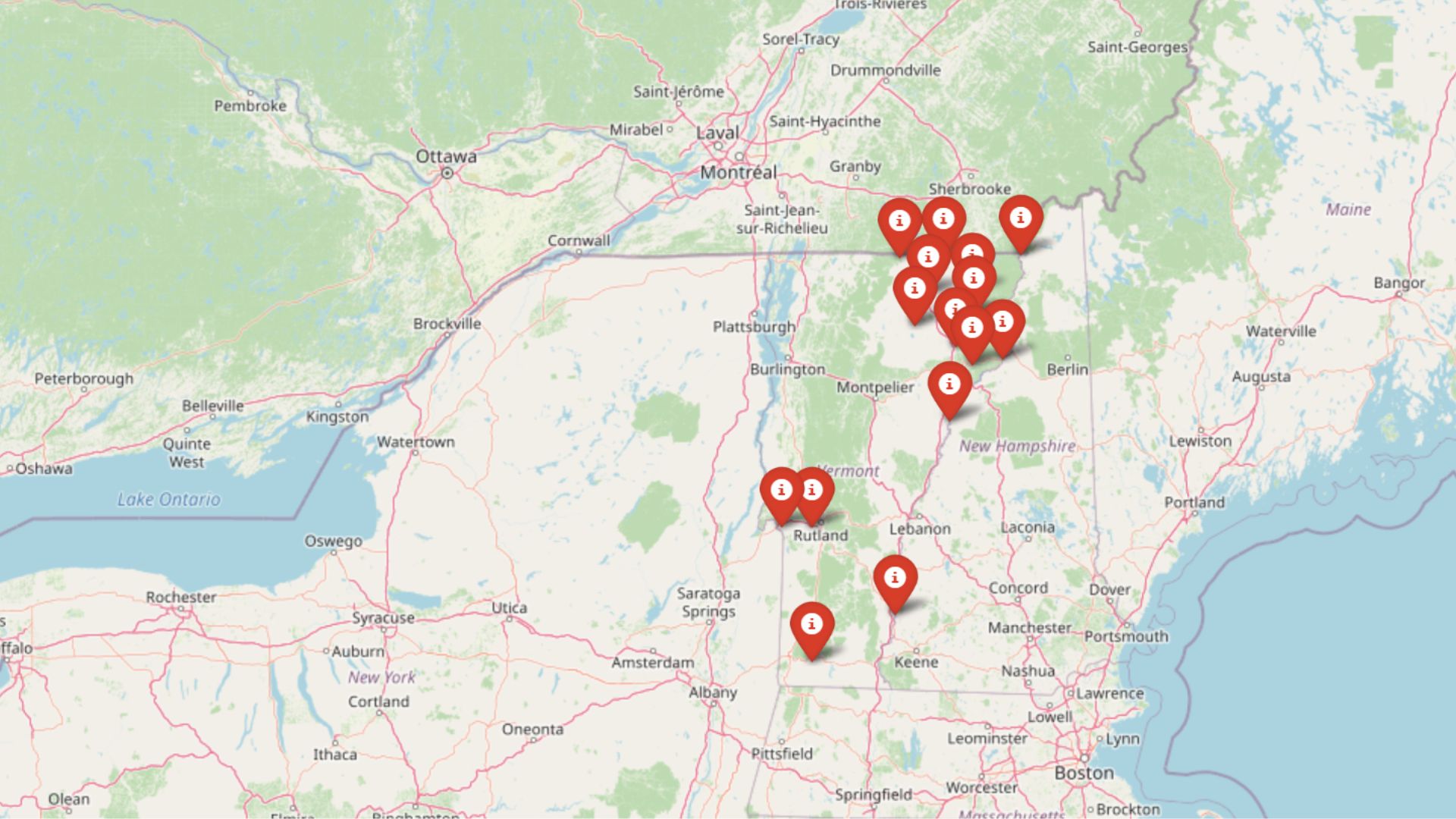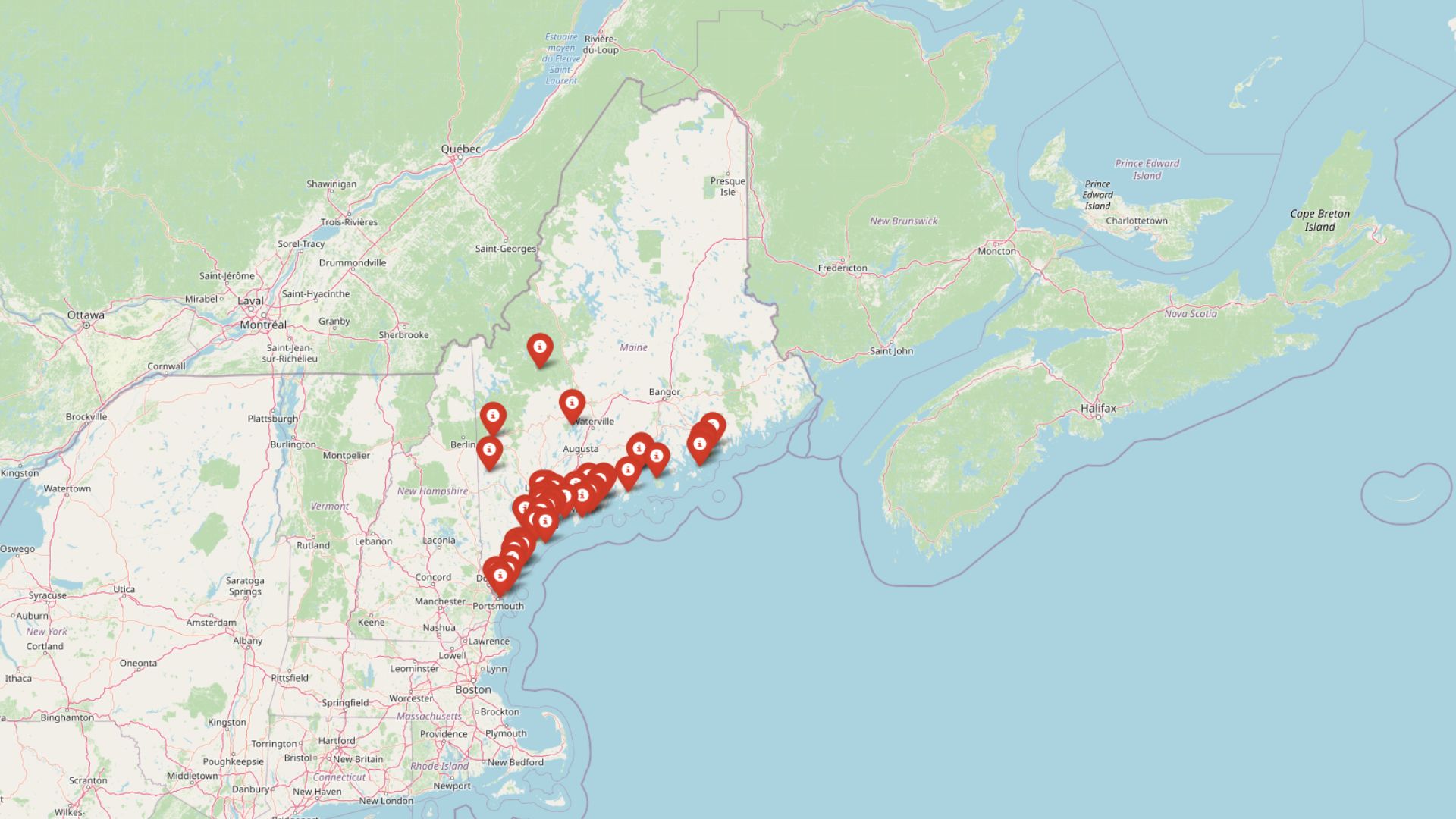
Forget the cozy coastal clichés—buying a home in Maine now takes serious cash. The Zillow Home Value Index shows property prices across the state smashing records, from ocean-view estates to backwoods cabins that now come with luxury price tags. Towns once known for lobster rolls and quiet charm are racking up six- and seven-figure deals as buyers scramble for a slice of the scenery. Whether you’re dreaming of a mountain hideaway or a coastal retreat, these 40 towns show exactly where Maine’s home prices are reaching jaw-dropping highs in 2025.
40. Newry – 183% Home Price Increase Since 2011
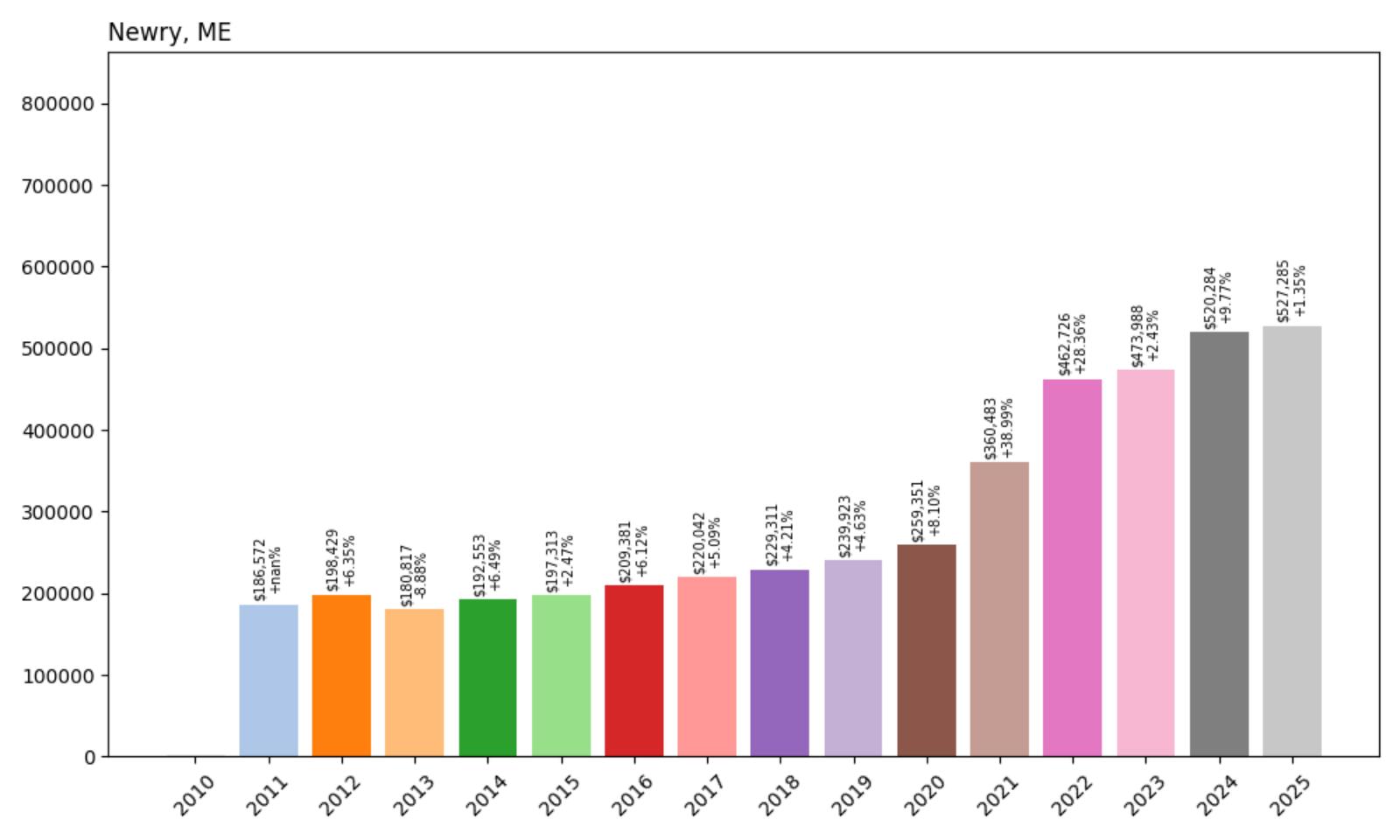
- 2010: N/A
- 2011: $186,572
- 2012: $198,429 (+$11,857, +6.35% from previous year)
- 2013: $180,817 (−$17,612, −8.88% from previous year)
- 2014: $192,553 (+$11,736, +6.49% from previous year)
- 2015: $197,313 (+$4,760, +2.47% from previous year)
- 2016: $209,381 (+$12,068, +6.12% from previous year)
- 2017: $220,042 (+$10,662, +5.09% from previous year)
- 2018: $229,311 (+$9,268, +4.21% from previous year)
- 2019: $239,923 (+$10,612, +4.63% from previous year)
- 2020: $259,351 (+$19,429, +8.10% from previous year)
- 2021: $360,483 (+$101,132, +38.99% from previous year)
- 2022: $462,726 (+$102,243, +28.36% from previous year)
- 2023: $473,988 (+$11,263, +2.43% from previous year)
- 2024: $520,284 (+$46,296, +9.77% from previous year)
- 2025: $527,285 (+$7,001, +1.35% from previous year)
Newry’s home price trajectory shows the dramatic impact of the pandemic-era real estate boom on Maine’s mountain communities. The town experienced steady but modest growth through the 2010s, with values hovering around $200,000 to $240,000. Then came the explosive growth of 2021 and 2022, when prices jumped nearly 40% and 28% respectively, pushing the median home value above half a million dollars for the first time.
Newry – Gateway to Sunday River Ski Resort
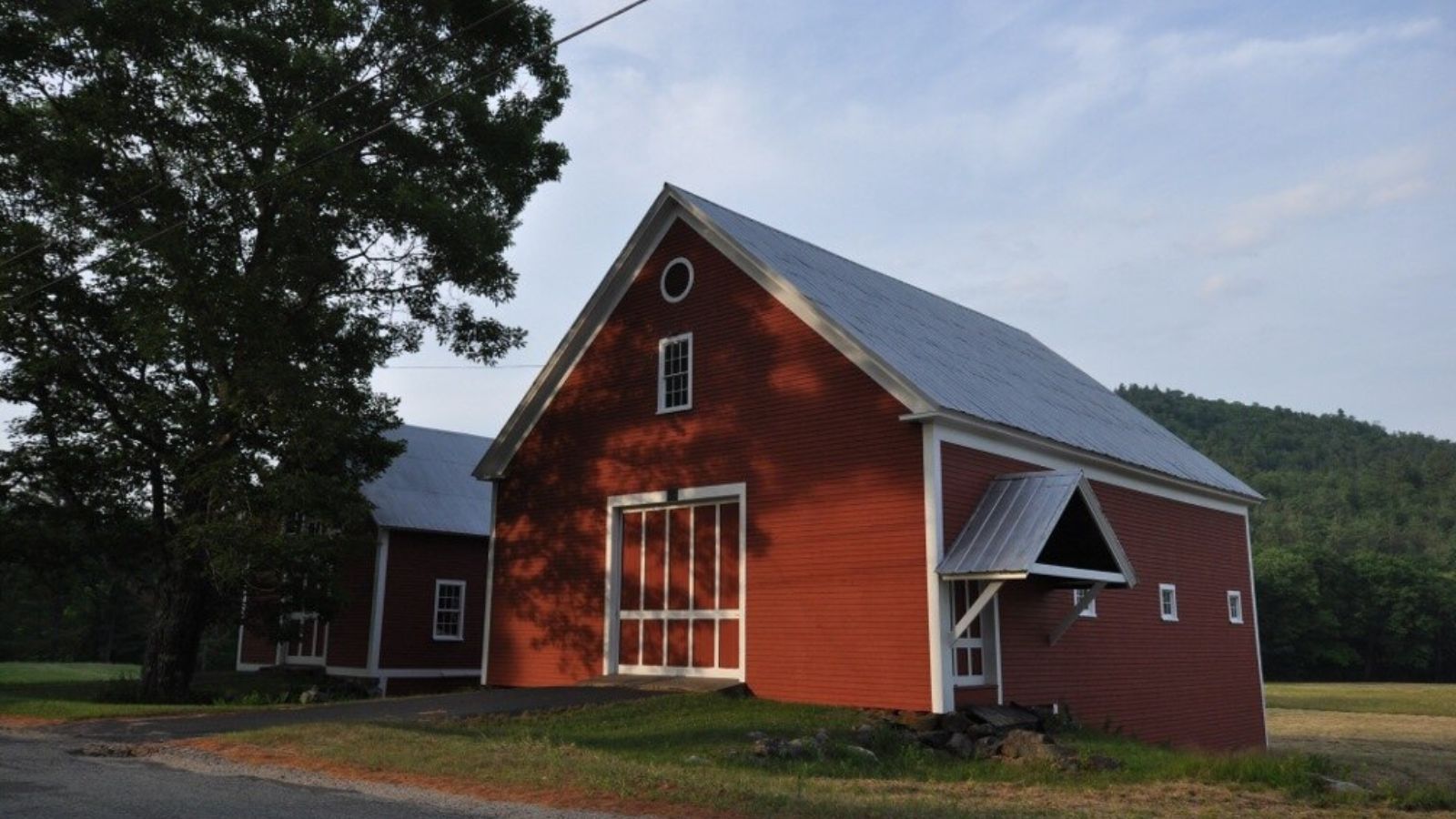
Located in Oxford County near the New Hampshire border, Newry serves as the gateway to Sunday River Ski Resort, one of Maine’s premier winter destinations. This small town of fewer than 400 residents has transformed from a quiet rural community into a sought-after location for second homes and vacation properties. The proximity to world-class skiing, mountain biking trails, and year-round outdoor recreation has made Newry increasingly attractive to buyers from Boston, New York, and other metropolitan areas.
The town’s current median home price of $527,285 reflects the premium buyers are willing to pay for access to both recreational amenities and the natural beauty of western Maine’s mountains. Despite its small size, Newry benefits from well-maintained infrastructure and easy access to Route 2, which connects the area to major population centers. The combination of recreational opportunities, scenic beauty, and relative accessibility has positioned Newry as one of Maine’s emerging high-value communities, though it remains more affordable than many coastal alternatives.
39. Rome – 146% Home Price Increase Since 2012
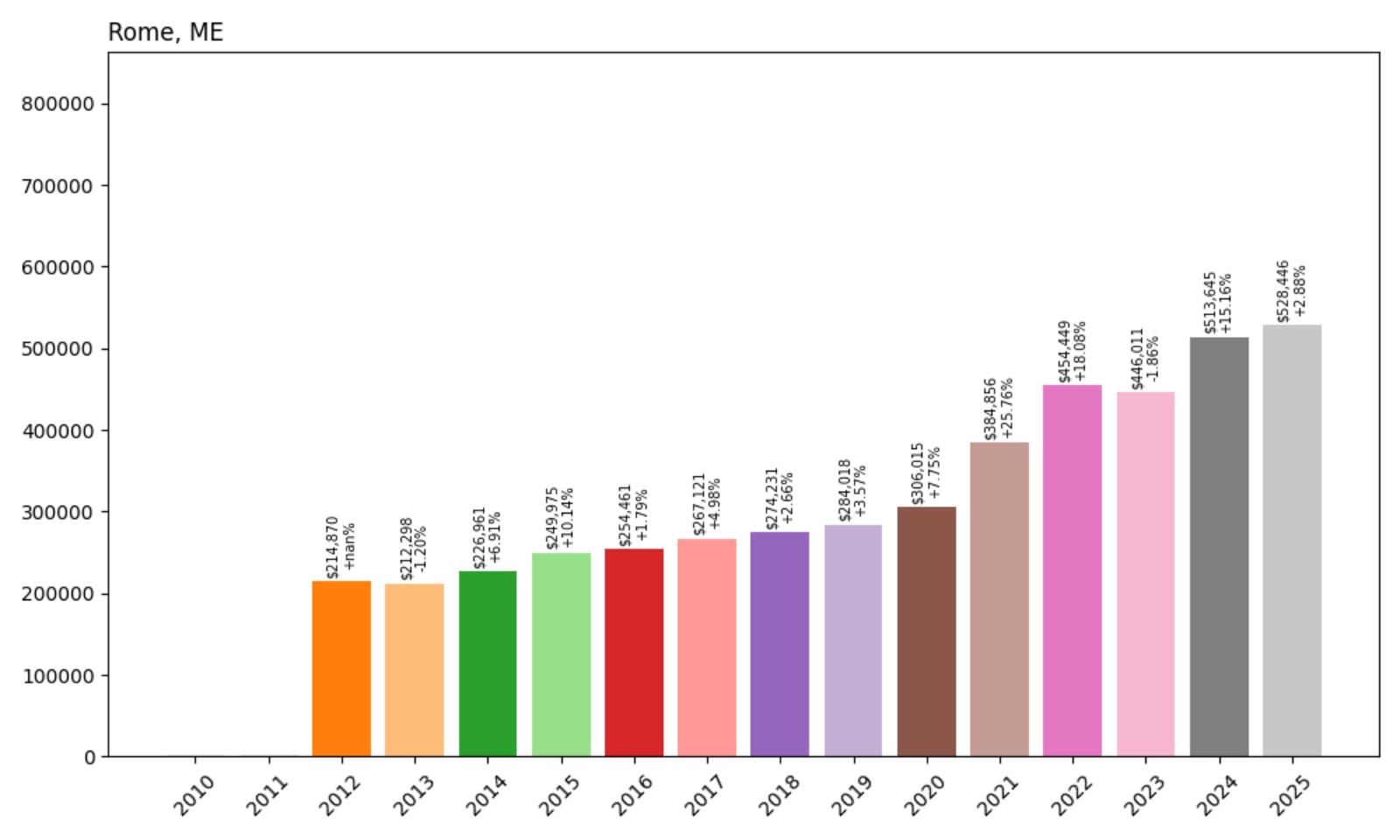
- 2010: N/A
- 2011: N/A
- 2012: $214,870
- 2013: $212,298 (−$2,573, −1.20% from previous year)
- 2014: $226,961 (+$14,663, +6.91% from previous year)
- 2015: $249,975 (+$23,014, +10.14% from previous year)
- 2016: $254,461 (+$4,486, +1.79% from previous year)
- 2017: $267,121 (+$12,660, +4.98% from previous year)
- 2018: $274,231 (+$7,110, +2.66% from previous year)
- 2019: $284,018 (+$9,787, +3.57% from previous year)
- 2020: $306,015 (+$21,997, +7.75% from previous year)
- 2021: $384,856 (+$78,841, +25.76% from previous year)
- 2022: $454,449 (+$69,593, +18.08% from previous year)
- 2023: $446,011 (−$8,438, −1.86% from previous year)
- 2024: $513,645 (+$67,634, +15.16% from previous year)
- 2025: $528,446 (+$14,802, +2.88% from previous year)
Rome’s housing market demonstrates the strong appeal of Maine’s lake country, with home values more than doubling since 2012 to reach $528,446 in 2025. The most dramatic growth occurred during the pandemic years of 2021 and 2022, when prices surged by over 25% and 18% respectively. Even after a brief decline in 2023, the market rebounded strongly with a 15% increase in 2024, showing sustained demand for properties in this Belgrade Lakes region community.
Rome – Belgrade Lakes Region Retreat
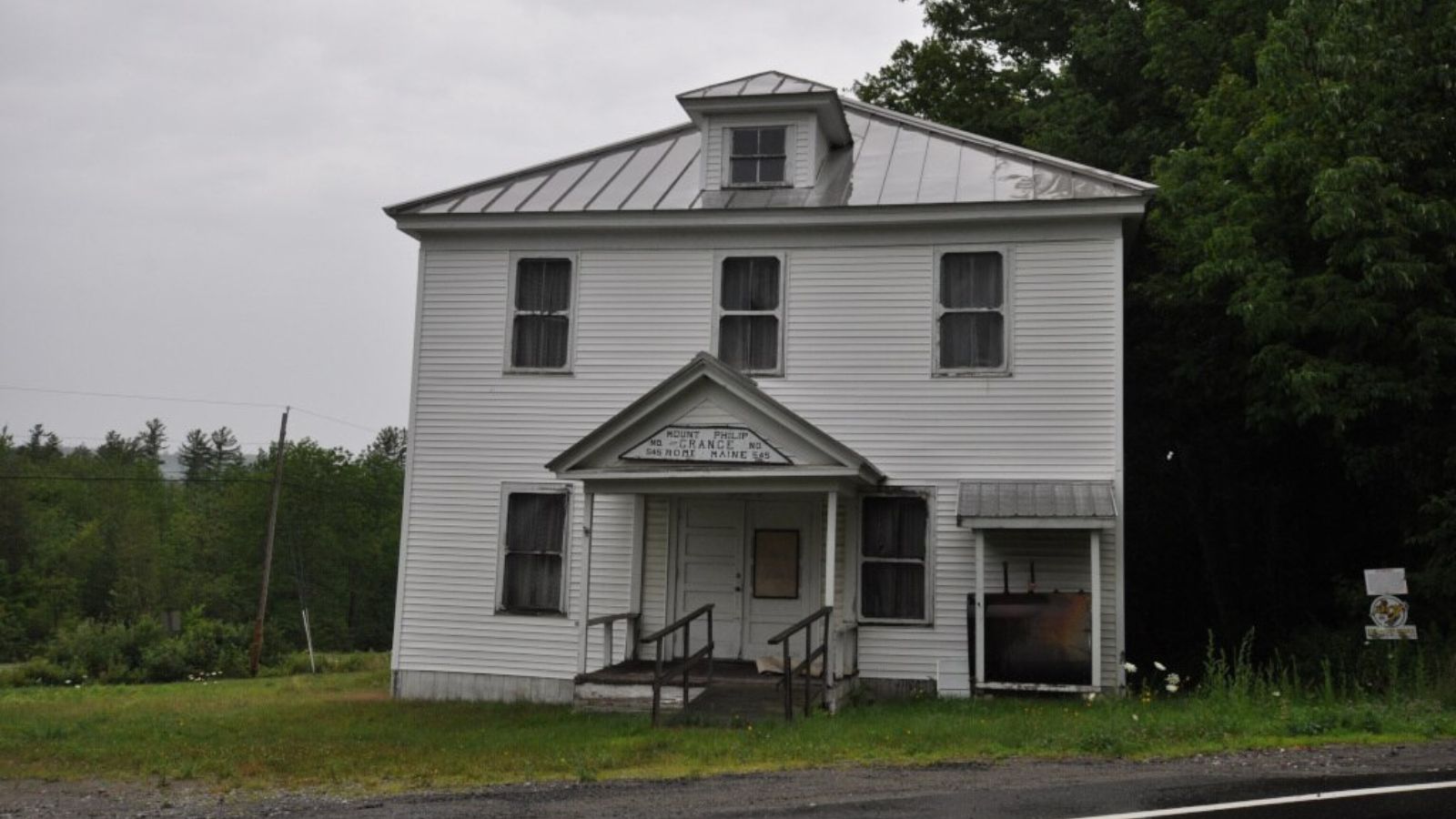
Situated in Kennebec County, Rome occupies a prime position in Maine’s famous Belgrade Lakes region, offering substantial frontage on both Long Pond and Great Pond. This small town of approximately 1,187 residents serves as part of the Belgrade Lakes area, known for exceptional outdoor recreation including fishing, sailing, and swimming opportunities. The town’s geography creates what locals describe as “two Romes” – waterfront areas with upscale homes and water access, and inland sections featuring rural residential clusters.
Rome’s appeal extends beyond its natural beauty to include Pine Tree Camp on North Pond, a barrier-free facility where children and adults with disabilities can participate in Maine’s recreational activities including swimming, fishing, kayaking, hiking, and camping. The community lacks a traditional downtown center but maintains essential services and is well-connected via Maine Routes 8, 27, 137, and 225. The median household income of $54,191 reflects a mix of year-round residents and seasonal property owners.
The town’s transformation from a quiet rural community to a sought-after destination reflects broader trends in Maine’s lake regions, where proximity to pristine waters and outdoor recreation drives significant real estate appreciation. Rome’s location near Oakland and easy access to central Maine’s employment centers, combined with its recreational amenities, positions it as an attractive option for both primary and secondary residences.
38. St George – 92% Home Price Increase Since 2010
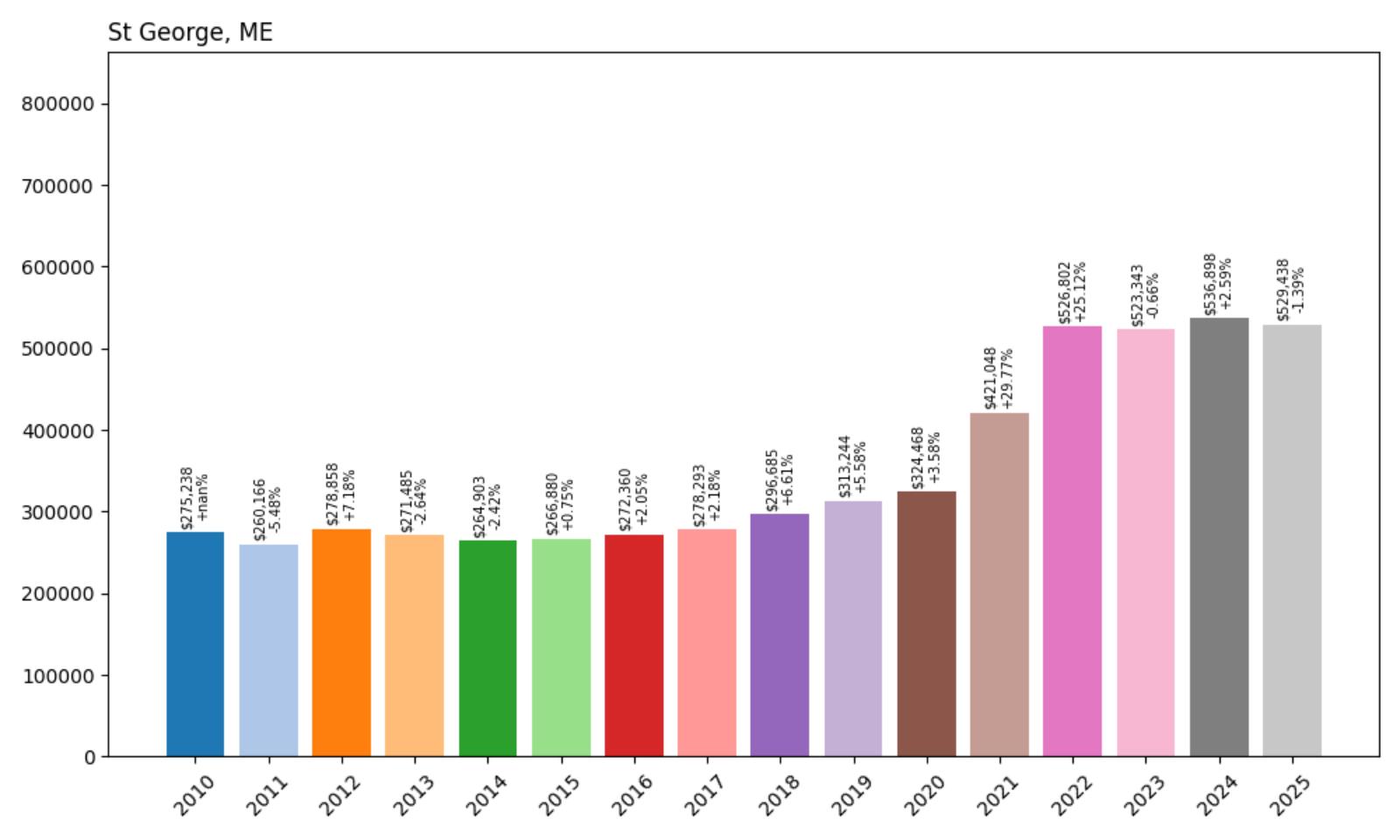
- 2010: $275,238
- 2011: $260,166 (−$15,072, −5.48% from previous year)
- 2012: $278,858 (+$18,692, +7.18% from previous year)
- 2013: $271,485 (−$7,373, −2.64% from previous year)
- 2014: $264,903 (−$6,582, −2.42% from previous year)
- 2015: $266,880 (+$1,977, +0.75% from previous year)
- 2016: $272,360 (+$5,479, +2.05% from previous year)
- 2017: $278,293 (+$5,933, +2.18% from previous year)
- 2018: $296,685 (+$18,392, +6.61% from previous year)
- 2019: $313,244 (+$16,559, +5.58% from previous year)
- 2020: $324,468 (+$11,224, +3.58% from previous year)
- 2021: $421,048 (+$96,580, +29.77% from previous year)
- 2022: $526,802 (+$105,754, +25.12% from previous year)
- 2023: $523,343 (−$3,459, −0.66% from previous year)
- 2024: $536,898 (+$13,554, +2.59% from previous year)
- 2025: $529,438 (−$7,459, −1.39% from previous year)
St George’s coastal real estate market shows the measured growth typical of established Maine communities, with home values nearly doubling since 2010 to reach $529,438 in 2025. The town experienced relatively modest growth through the 2010s, followed by the dramatic pandemic-era surge that saw prices jump nearly 30% in 2021 and 25% in 2022. Recent stabilization with slight declines in 2023 and 2025 suggests the market has found a sustainable price level after the pandemic boom.
St George – Historic Coastal Peninsula
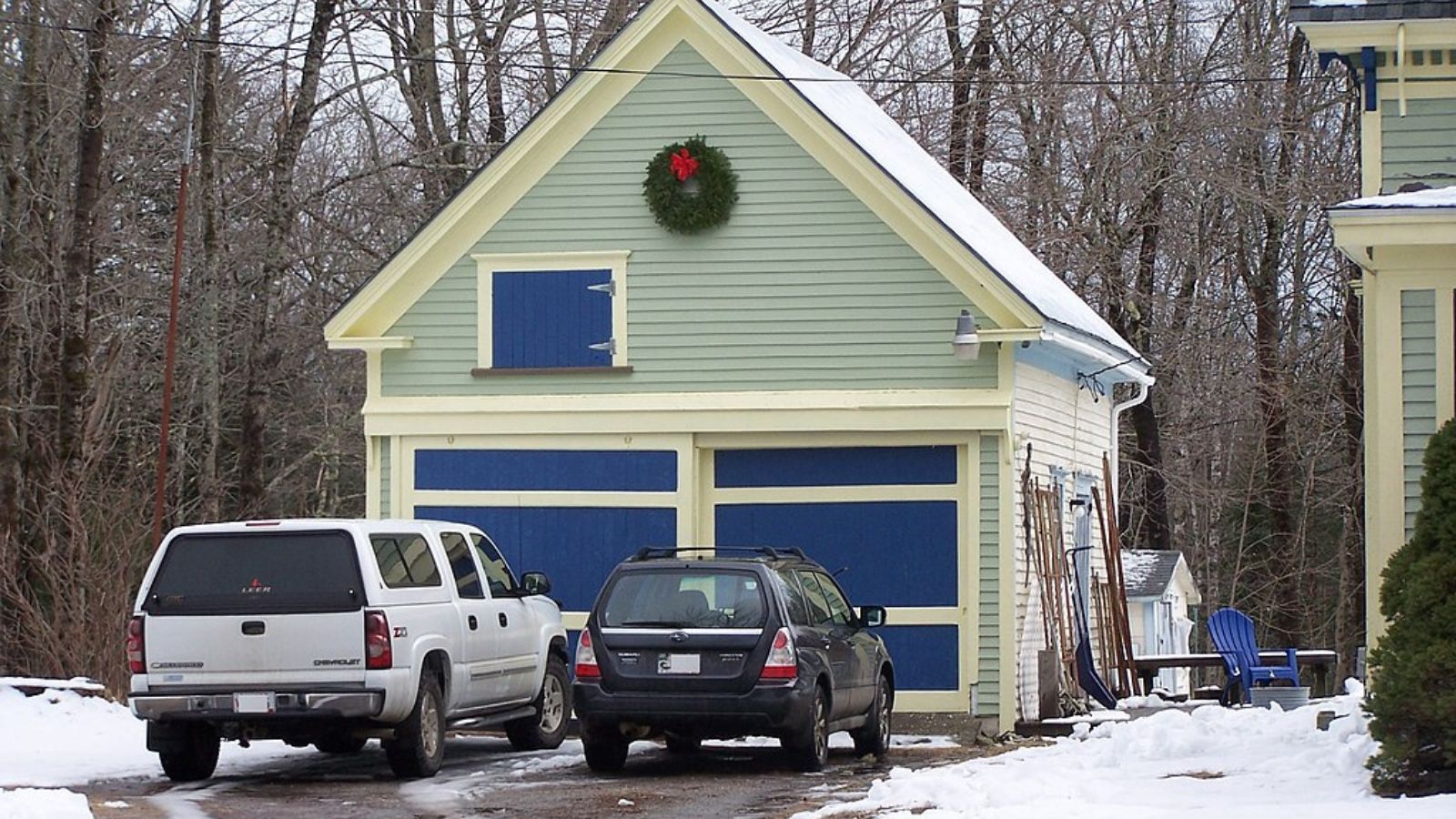
St George encompasses a peninsula extending into the Gulf of Maine in Knox County, incorporating the well-known villages of Port Clyde and Tenants Harbor. This fishing and lobstering community consists of several distinct villages including Clark Island, Wiley’s Corner, Martinsville, Tenants Harbor, and Port Clyde, with Tenants Harbor serving as the administrative center. The town’s substantial coastline and island territories create a unique geography where the municipal boundaries extend far into the ocean, reaching toward Monhegan Island.
St George holds significant historical importance as the site of granite quarries and the birthplace of Maine’s first Granite Cutters Union in 1877. The community is perhaps best known for Marshall Point Lighthouse in Port Clyde, famously featured in the film Forrest Gump, and serves as the departure point for the ferry to Monhegan Island. Port Clyde, at the peninsula’s southern tip, remains a classic Maine fishing village devoted primarily to lobstering while offering galleries, restaurants, and limited lodging.
The town’s appeal to buyers stems from its authentic coastal character, working waterfront heritage, and proximity to artistic communities. With a population of approximately 2,600 residents and a median household income estimated at $82,779, St George attracts both year-round residents and seasonal property owners drawn to its scenic beauty, maritime culture, and access to island communities. The combination of working waterfront authenticity and recreational opportunities continues to drive steady demand for real estate in this historic coastal peninsula.
37. Arundel – 119% Home Price Increase Since 2010
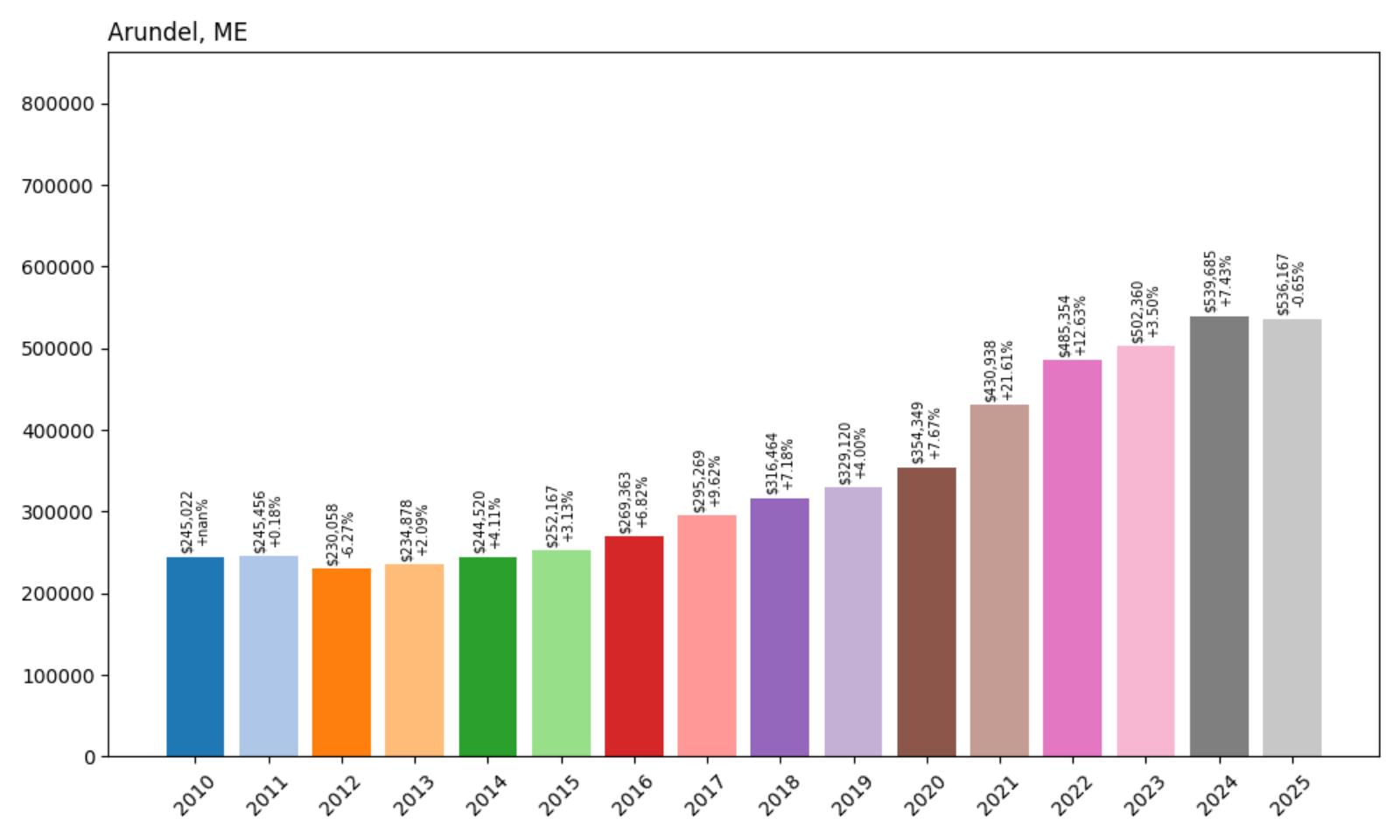
- 2010: $245,022
- 2011: $245,456 (+$433, +0.18% from previous year)
- 2012: $230,058 (−$15,398, −6.27% from previous year)
- 2013: $234,878 (+$4,819, +2.09% from previous year)
- 2014: $244,520 (+$9,642, +4.11% from previous year)
- 2015: $252,167 (+$7,647, +3.13% from previous year)
- 2016: $269,363 (+$17,197, +6.82% from previous year)
- 2017: $295,269 (+$25,905, +9.62% from previous year)
- 2018: $316,464 (+$21,196, +7.18% from previous year)
- 2019: $329,120 (+$12,656, +4.00% from previous year)
- 2020: $354,349 (+$25,229, +7.67% from previous year)
- 2021: $430,938 (+$76,589, +21.61% from previous year)
- 2022: $485,354 (+$54,416, +12.63% from previous year)
- 2023: $502,360 (+$17,005, +3.50% from previous year)
- 2024: $539,685 (+$37,326, +7.43% from previous year)
- 2025: $536,167 (−$3,518, −0.65% from previous year)
Arundel’s home price trajectory reflects consistent growth over the past decade and a half, with values more than doubling from $245,022 in 2010 to $536,167 in 2025. The town experienced steady appreciation through the 2010s, accelerating during the pandemic years with a 21% jump in 2021. Unlike many Maine communities, Arundel maintained upward momentum through 2024 with a notable 7.4% increase, showing the continued appeal of this York County location.
Arundel – Gateway Between Kennebunk Communities
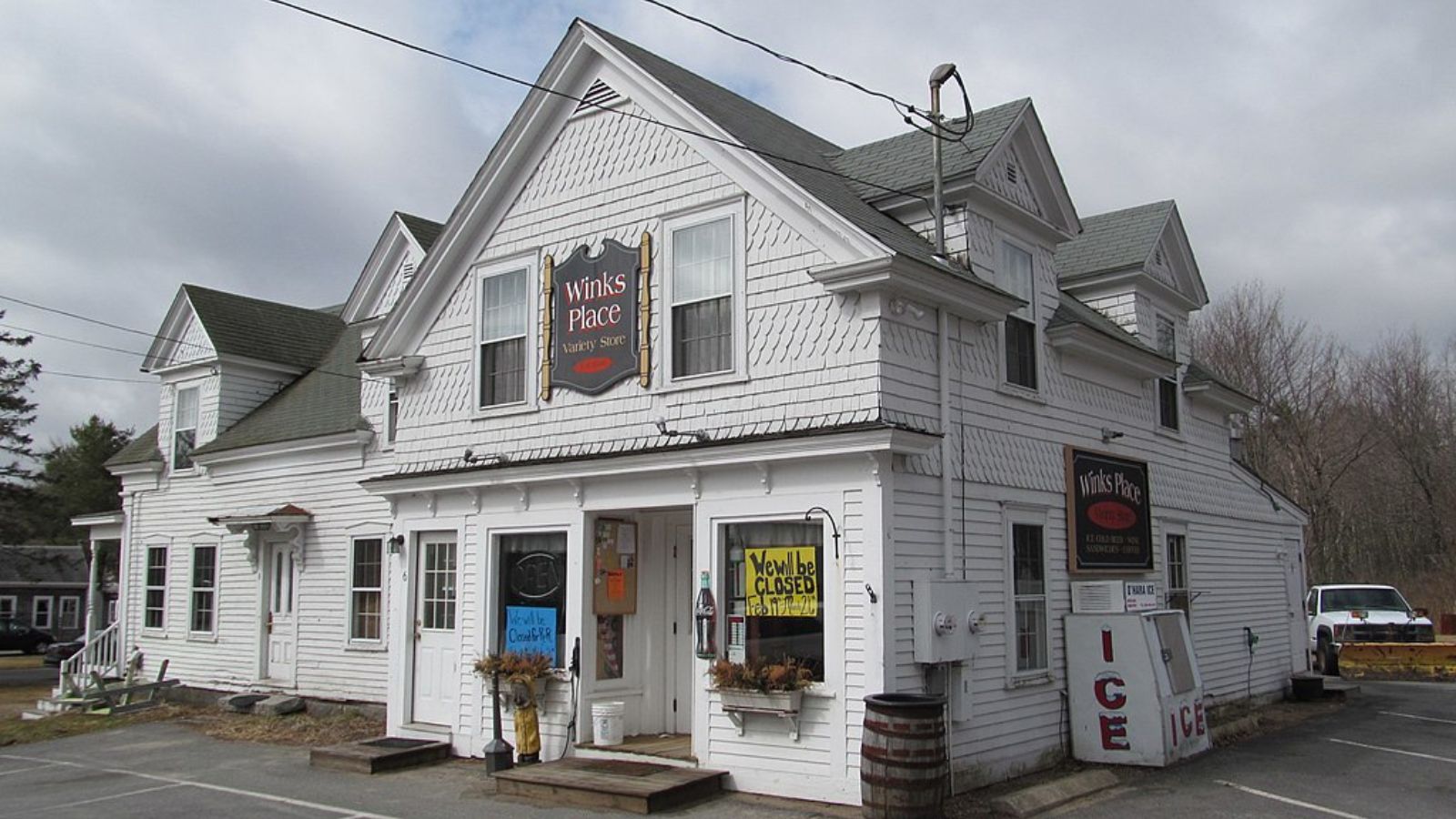
Located in York County, Arundel serves as a strategic inland community positioned between the more famous coastal towns of Kennebunk and Kennebunkport. This town of approximately 4,500 residents was originally part of Kennebunkport until 1915, when it was set off as North Kennebunkport, later renamed Arundel in 1957 after Kenneth Roberts’s Chronicles of Arundel. In 2014, Downeast Magazine recognized Arundel as the “Best Place to Live in Maine,” highlighting its appeal as a balanced community offering rural character with suburban amenities.
Arundel’s geography places it advantageously within the Portland metropolitan area while maintaining easy access to Interstate 95, U.S. Route 1, and various state routes. The town’s median household income of $92,386 reflects its status as an affluent community that attracts both families and professionals seeking proximity to employment centers and coastal recreation. Housing in Arundel consists primarily of single-family owner-occupied homes, with minimal multi-family development, contributing to its suburban-rural character.
The community benefits from excellent educational opportunities through RSU 21, which encompasses Arundel, Kennebunk, and Kennebunkport, providing access to some of Maine’s highest-performing schools. Arundel’s appeal lies in its combination of convenience, quality infrastructure, and small-town atmosphere, making it particularly attractive to buyers seeking a community that offers both rural tranquility and access to coastal Maine’s recreational and economic opportunities.
36. Gorham – 128% Home Price Increase Since 2010
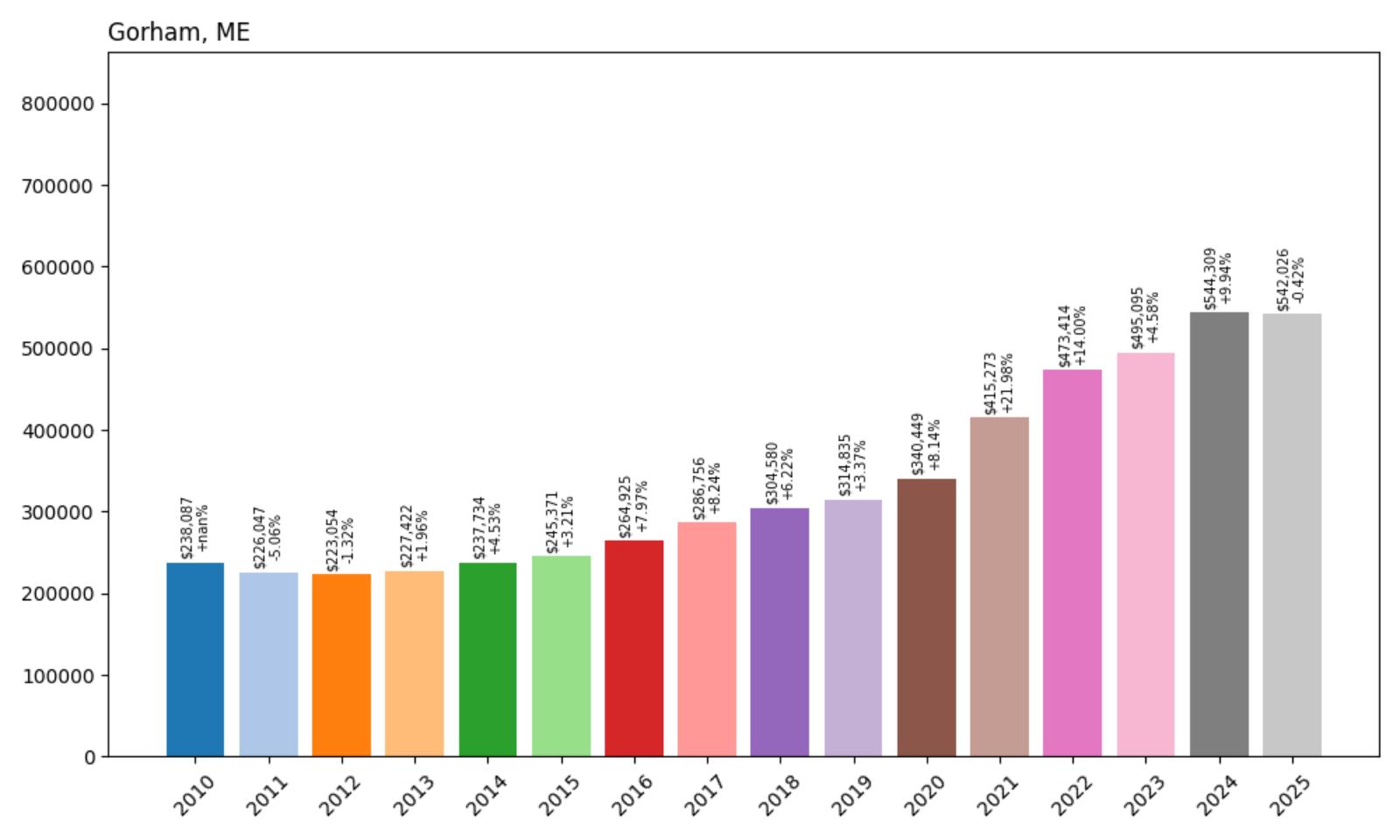
- 2010: $238,087
- 2011: $226,047 (−$12,041, −5.06% from previous year)
- 2012: $223,054 (−$2,992, −1.32% from previous year)
- 2013: $227,422 (+$4,367, +1.96% from previous year)
- 2014: $237,734 (+$10,312, +4.53% from previous year)
- 2015: $245,371 (+$7,637, +3.21% from previous year)
- 2016: $264,925 (+$19,554, +7.97% from previous year)
- 2017: $286,756 (+$21,831, +8.24% from previous year)
- 2018: $304,580 (+$17,824, +6.22% from previous year)
- 2019: $314,835 (+$10,255, +3.37% from previous year)
- 2020: $340,449 (+$25,615, +8.14% from previous year)
- 2021: $415,273 (+$74,824, +21.98% from previous year)
- 2022: $473,414 (+$58,141, +14.00% from previous year)
- 2023: $495,095 (+$21,681, +4.58% from previous year)
- 2024: $544,309 (+$49,214, +9.94% from previous year)
- 2025: $542,026 (−$2,283, −0.42% from previous year)
Gorham’s real estate market exemplifies the transformation of Maine’s suburban communities, with home values more than doubling from $238,087 in 2010 to $542,026 in 2025. The town experienced steady growth through the 2010s, followed by accelerated appreciation during the pandemic years, including a remarkable 22% jump in 2021. Recent market activity shows continued strength with a nearly 10% increase in 2024, indicating sustained demand for this well-positioned Cumberland County community.
Gorham – University Town and Growing Suburb
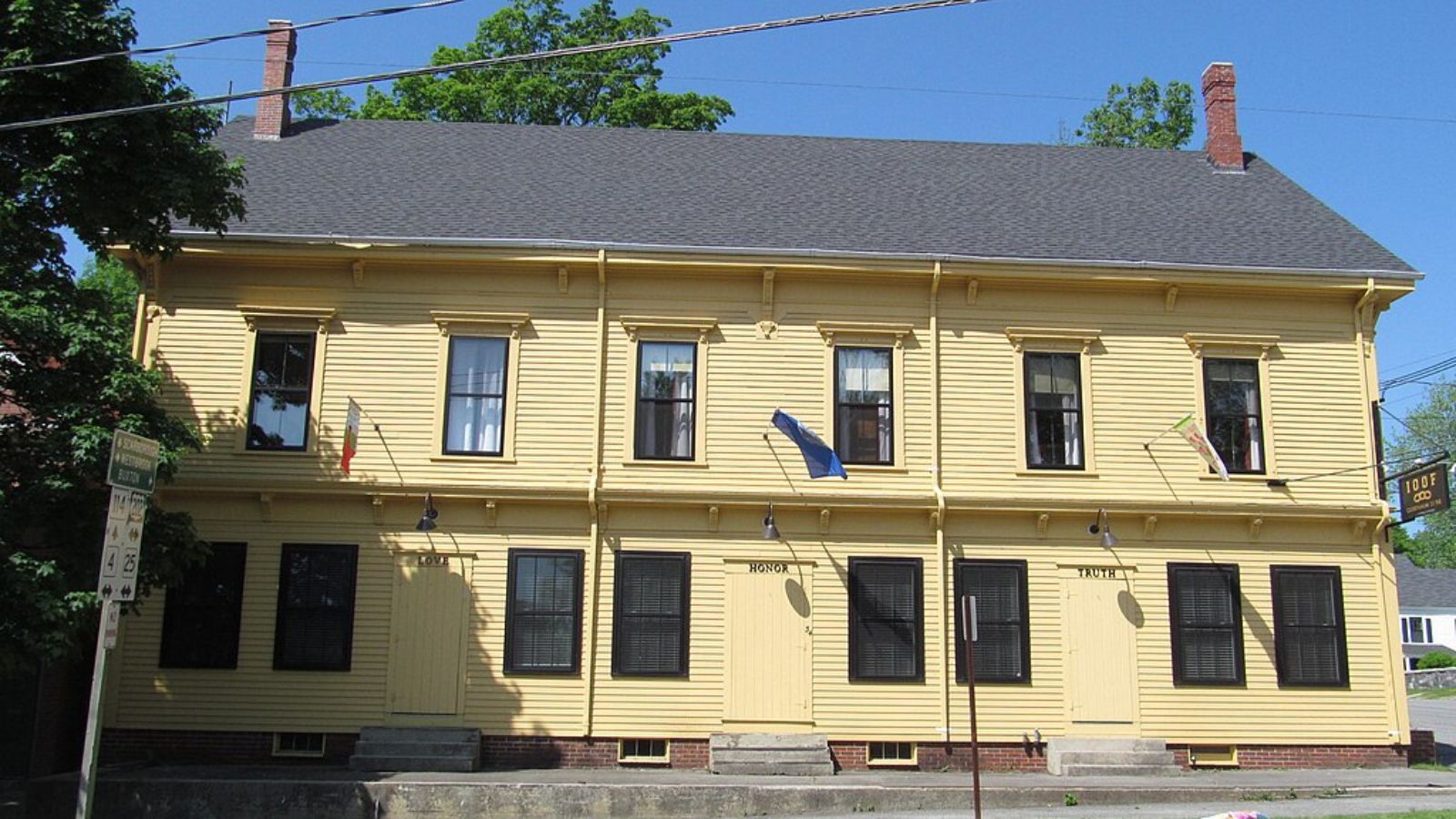
Gorham stands as one of Cumberland County’s largest communities, with a population of approximately 18,400 residents and a strategic location that has transformed it from a historical manufacturing center into a thriving bedroom community for Portland. The town encompasses numerous villages including Gorham Village, South Gorham, West Gorham, Little Falls, White Rock, and North Gorham, each maintaining distinct historical identities while contributing to the community’s overall character. Gorham’s proximity to Portland, combined with direct access to major transportation routes including U.S. Route 202 and multiple state routes, makes it highly attractive to commuters.
The town’s economic landscape reflects its evolution from its 19th-century industrial roots to its current role as a modern suburban community. Historical industries including textiles, lumber, and manufacturing have given way to a diverse economy anchored by education, with the University of Southern Maine’s Gorham campus serving as a major employer and cultural center. The expanding Gorham Industrial Park, ranked as the fourth largest in Southern Maine, attracts businesses across multiple sectors including construction, warehouse distribution, and manufacturing, while also hosting successful enterprises like Sebago Brewing Company and Lone Pine Brewing Company.
Gorham’s appeal to homebuyers stems from its combination of excellent schools, recreational opportunities near Sebago Lake, and strong community infrastructure. The median household income of $110,181 reflects the community’s economic strength and educated workforce. With well-maintained roads, comprehensive municipal services, and a proactive approach to economic development, Gorham successfully balances suburban growth with preservation of its rural character, making it one of Maine’s fastest-growing communities and an increasingly expensive place to buy a home.
35. Lovell – 117% Home Price Increase Since 2012
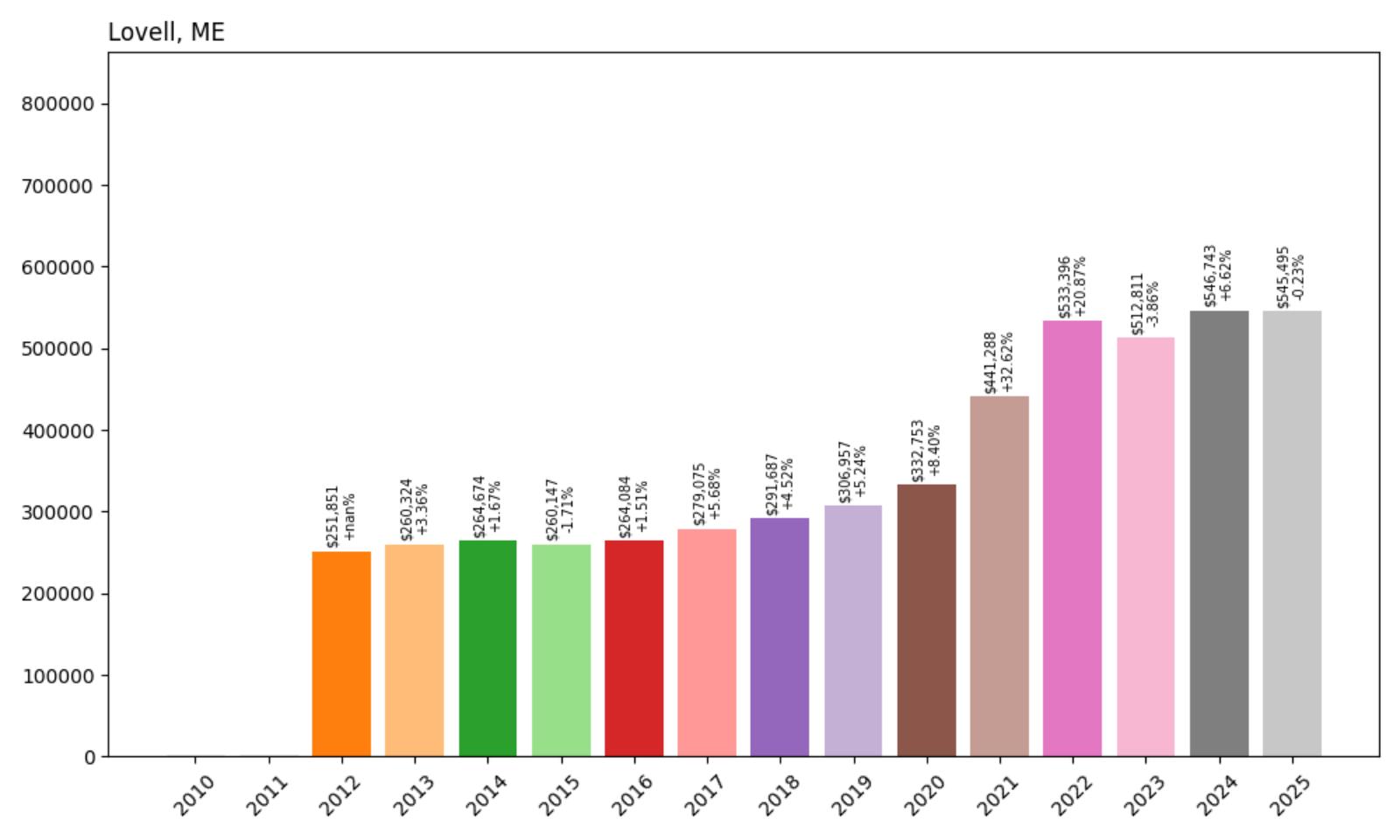
- 2010: N/A
- 2011: N/A
- 2012: $251,851
- 2013: $260,324 (+$8,473, +3.36% from previous year)
- 2014: $264,674 (+$4,350, +1.67% from previous year)
- 2015: $260,147 (−$4,527, −1.71% from previous year)
- 2016: $264,084 (+$3,938, +1.51% from previous year)
- 2017: $279,075 (+$14,990, +5.68% from previous year)
- 2018: $291,687 (+$12,612, +4.52% from previous year)
- 2019: $306,957 (+$15,270, +5.24% from previous year)
- 2020: $332,753 (+$25,796, +8.40% from previous year)
- 2021: $441,288 (+$108,535, +32.62% from previous year)
- 2022: $533,396 (+$92,108, +20.87% from previous year)
- 2023: $512,811 (−$20,585, −3.86% from previous year)
- 2024: $546,743 (+$33,931, +6.62% from previous year)
- 2025: $545,495 (−$1,248, −0.23% from previous year)
Lovell’s home price evolution showcases the remarkable appeal of Maine’s mountain lake communities, with values more than doubling since 2012 to reach $545,495 in 2025. The community experienced modest but steady growth through the late 2010s before the pandemic-era explosion that drove prices up by an extraordinary 33% in 2021 and 21% in 2022. After a brief correction in 2023, the market stabilized near current levels, reflecting strong underlying demand for properties in this scenic Oxford County location.
Lovell – White Mountains Lake Country
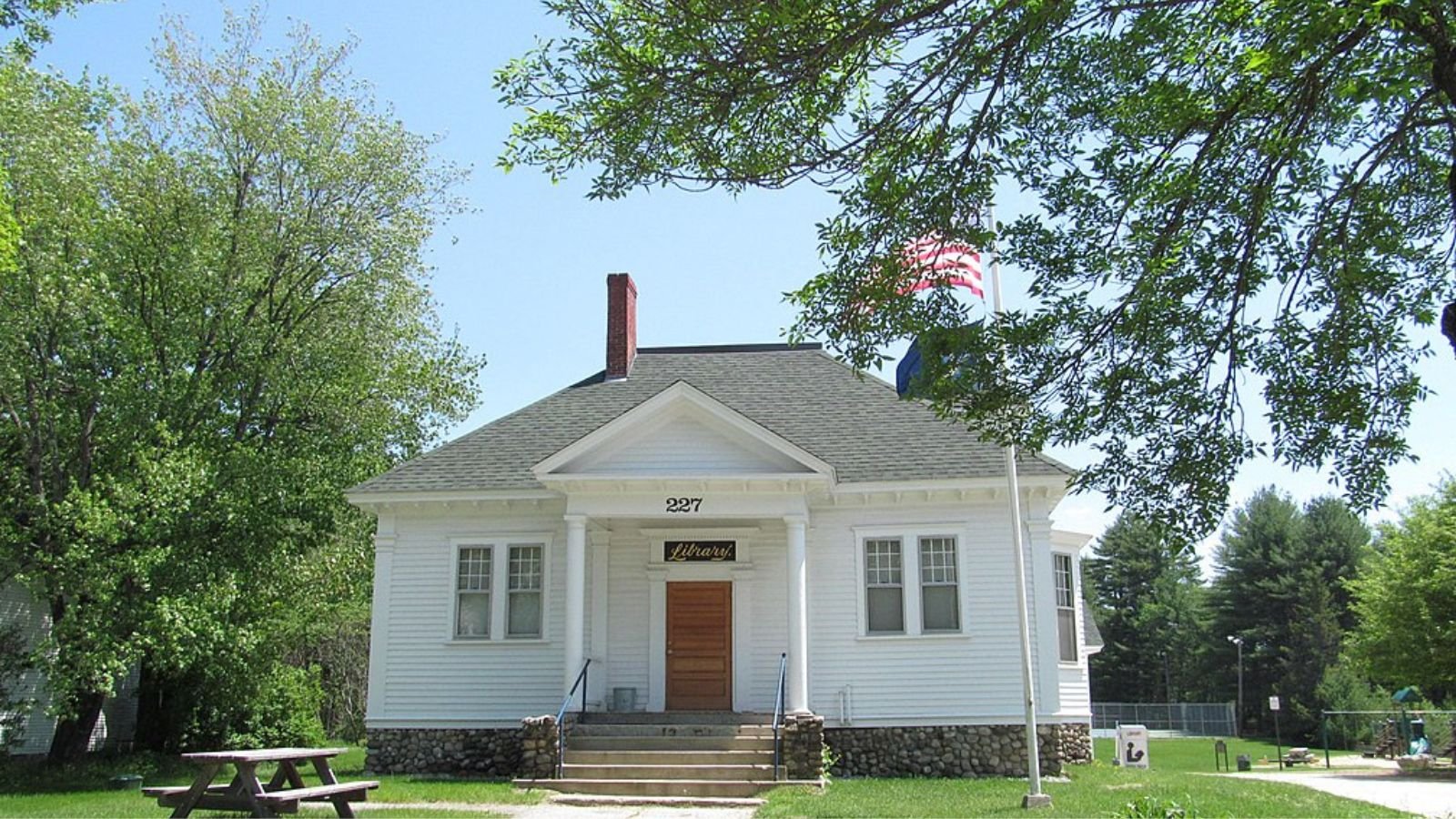
Nestled in the foothills of the White Mountains in Oxford County, Lovell represents the quintessential Maine lakes and mountains experience that has attracted vacationers and seasonal residents for over a century. The town of approximately 1,100 year-round residents swells to more than three times that size during summer months, as visitors are drawn to the pristine beauty of Kezar Lake, a 4.74-square-mile body of crystal-clear water surrounded by rolling hills and mountain vistas. Lovell’s four distinct sections – Lovell Village, Center Lovell, North Lovell, and West Lovell – all flank this stunning lake, creating multiple waterfront communities.
Lovell’s real estate market reflects its status as a premier destination for those seeking privacy, natural beauty, and outdoor recreation. Waterfront properties on Kezar Lake command some of the highest prices in Maine’s lakes region, attracting buyers from major metropolitan areas who value the community’s rustic charm and natural setting. The town’s rich history, dating back to its incorporation in 1800 and its connection to Captain John Lovewell’s famous 1725 battle, adds cultural depth to its appeal as a retreat destination where famous residents have included Stephen King, crooner Rudy Vallée, and painter Marsden Hartley.
34. Wells – 124% Home Price Increase Since 2010
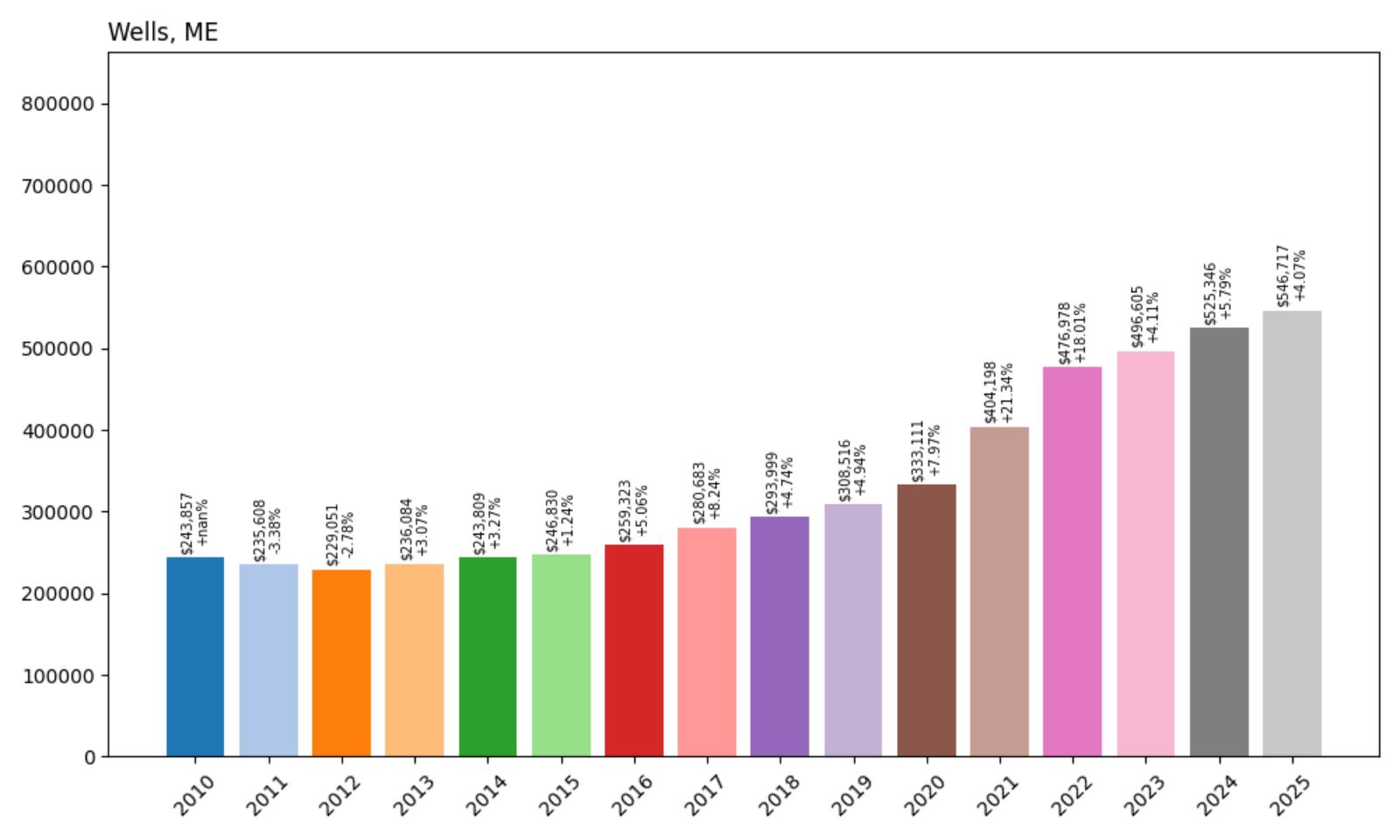
- 2010: $243,857
- 2011: $235,608 (−$8,249, −3.38% from previous year)
- 2012: $229,051 (−$6,557, −2.78% from previous year)
- 2013: $236,084 (+$7,032, +3.07% from previous year)
- 2014: $243,809 (+$7,726, +3.27% from previous year)
- 2015: $246,830 (+$3,021, +1.24% from previous year)
- 2016: $259,323 (+$12,492, +5.06% from previous year)
- 2017: $280,683 (+$21,360, +8.24% from previous year)
- 2018: $293,999 (+$13,316, +4.74% from previous year)
- 2019: $308,516 (+$14,517, +4.94% from previous year)
- 2020: $333,111 (+$24,595, +7.97% from previous year)
- 2021: $404,198 (+$71,087, +21.34% from previous year)
- 2022: $476,978 (+$72,780, +18.01% from previous year)
- 2023: $496,605 (+$19,627, +4.11% from previous year)
- 2024: $525,346 (+$28,741, +5.79% from previous year)
- 2025: $546,717 (+$21,371, +4.07% from previous year)
Wells demonstrates remarkable consistency in its real estate appreciation, with home values more than doubling from $243,857 in 2010 to $546,717 in 2025. The coastal community experienced steady growth through the 2010s, accelerating significantly during the pandemic years with consecutive increases of 21% in 2021 and 18% in 2022. Unlike many Maine markets that have plateaued, Wells continues to show strong momentum with increases of nearly 6% in 2024 and over 4% in 2025, reflecting sustained demand for this popular York County destination.
Wells – Classic Maine Beach Community
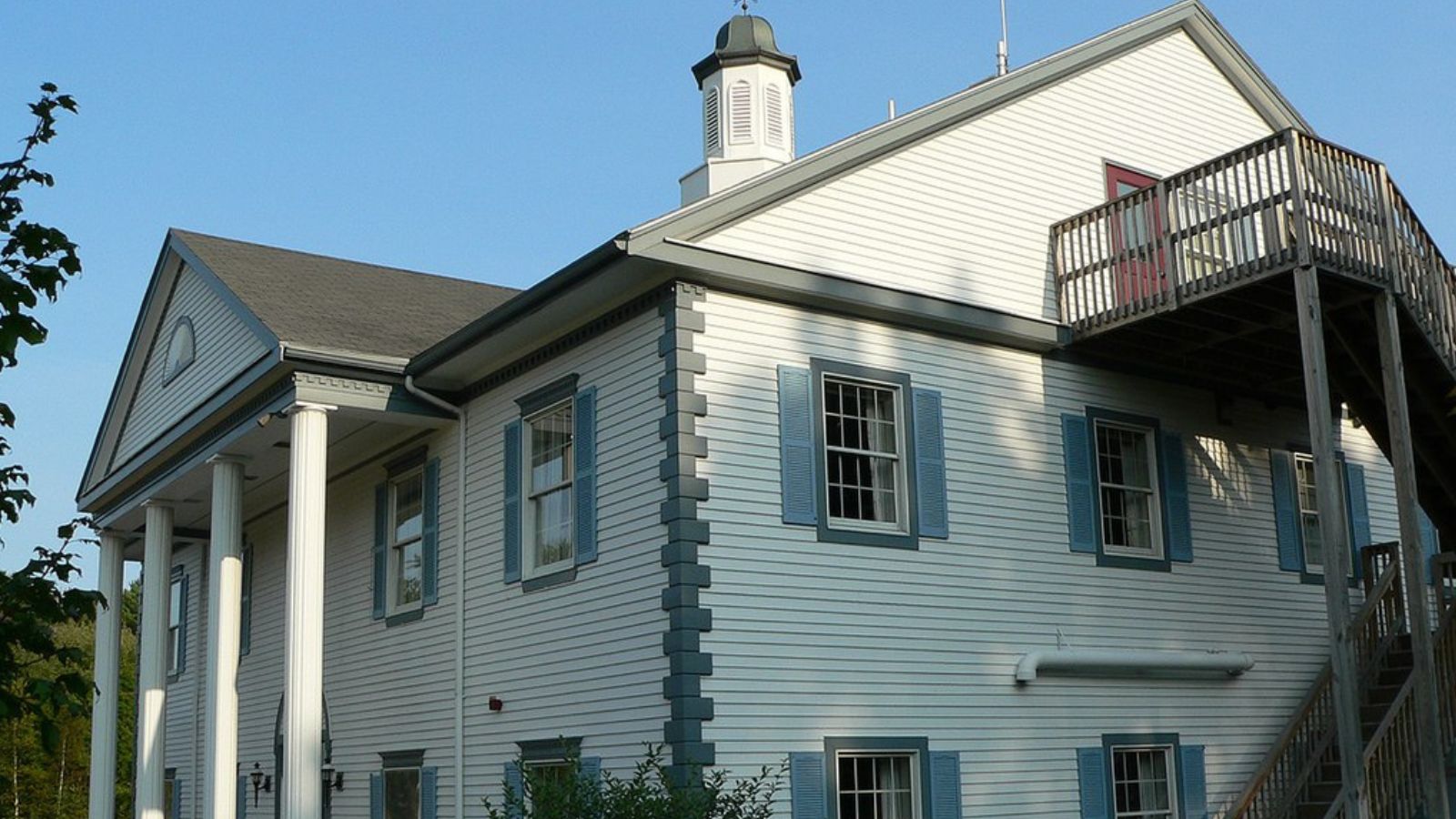
Wells stands as one of Maine’s premier coastal destinations, combining seven miles of pristine sandy beaches with rich historical significance as the state’s third-oldest incorporated town, founded in 1653. Located in York County between Kennebunkport and Ogunquit, Wells bills itself as the “Friendliest Town in Maine” and offers an ideal blend of natural beauty, recreational opportunities, and authentic coastal charm. The community of approximately 11,300 residents welcomes visitors to Wells Beach, Moody Beach, Crescent Beach, and Drakes Island Beach, each offering unique experiences from family-friendly swimming to secluded coastal exploration.
The town’s appeal extends beyond its beaches to include world-class natural attractions such as the Rachel Carson National Wildlife Refuge and the Wells Reserve at Laudholm Farm, which together provide over 2,000 acres of diverse ecosystems including salt marshes, forests, and pristine coastline. Wells has earned recognition as Maine’s “Antiques Capital” with Route 1 featuring numerous barn-style shops and showrooms, while the working harbor at Wells Harbor offers boat launching, fishing opportunities, and scenic waterfront dining.
Wells’ real estate market reflects its status as a highly desirable coastal community that successfully balances year-round residential appeal with seasonal tourism. The town’s proximity to major transportation routes including Amtrak’s Downeaster service, combined with its excellent schools, recreational facilities, and maintained infrastructure, continues to attract both primary and secondary homebuyers. The sustained appreciation in home values demonstrates Wells’ enduring appeal as a community that offers authentic Maine coastal living with modern amenities and accessibility.
33. West Bath – 155% Home Price Increase Since 2010
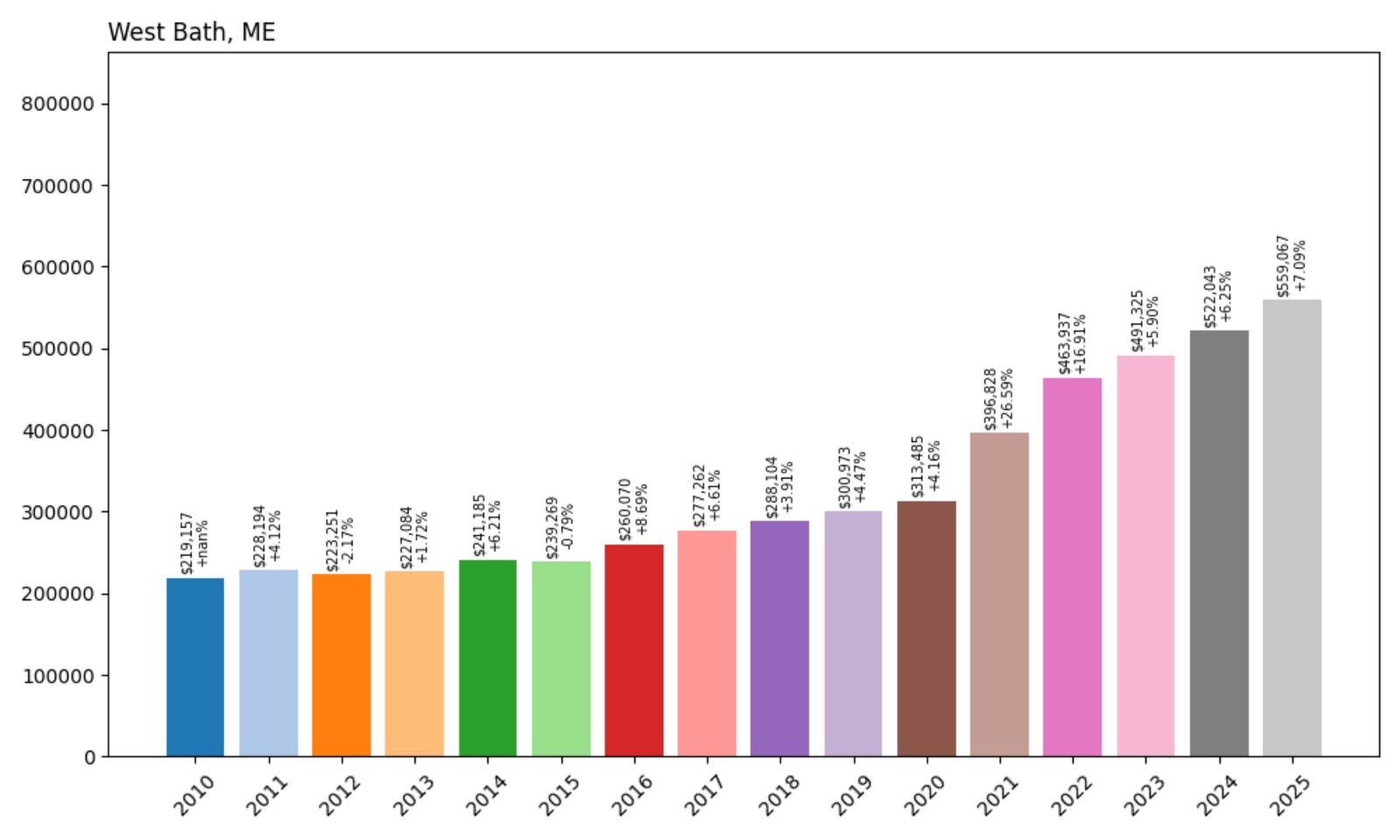
- 2010: $219,157
- 2011: $228,194 (+$9,037, +4.12% from previous year)
- 2012: $223,251 (−$4,943, −2.17% from previous year)
- 2013: $227,084 (+$3,832, +1.72% from previous year)
- 2014: $241,185 (+$14,101, +6.21% from previous year)
- 2015: $239,269 (−$1,916, −0.79% from previous year)
- 2016: $260,070 (+$20,801, +8.69% from previous year)
- 2017: $277,262 (+$17,193, +6.61% from previous year)
- 2018: $288,104 (+$10,841, +3.91% from previous year)
- 2019: $300,973 (+$12,869, +4.47% from previous year)
- 2020: $313,485 (+$12,512, +4.16% from previous year)
- 2021: $396,828 (+$83,343, +26.59% from previous year)
- 2022: $463,937 (+$67,109, +16.91% from previous year)
- 2023: $491,325 (+$27,387, +5.90% from previous year)
- 2024: $522,043 (+$30,718, +6.25% from previous year)
- 2025: $559,067 (+$37,024, +7.09% from previous year)
West Bath exemplifies the dramatic transformation of Maine’s midcoast real estate market, with home values surging 155% from $219,157 in 2010 to $559,067 in 2025. The Sagadahoc County community experienced steady but modest growth through the 2010s before the pandemic-era acceleration that saw prices jump 27% in 2021 and 17% in 2022. Unlike many Maine markets that have stabilized, West Bath continues to show strong momentum with sustained increases of over 6% in both 2024 and over 7% in 2025, indicating exceptional buyer demand for this coastal location.
West Bath – Emerging Midcoast Destination
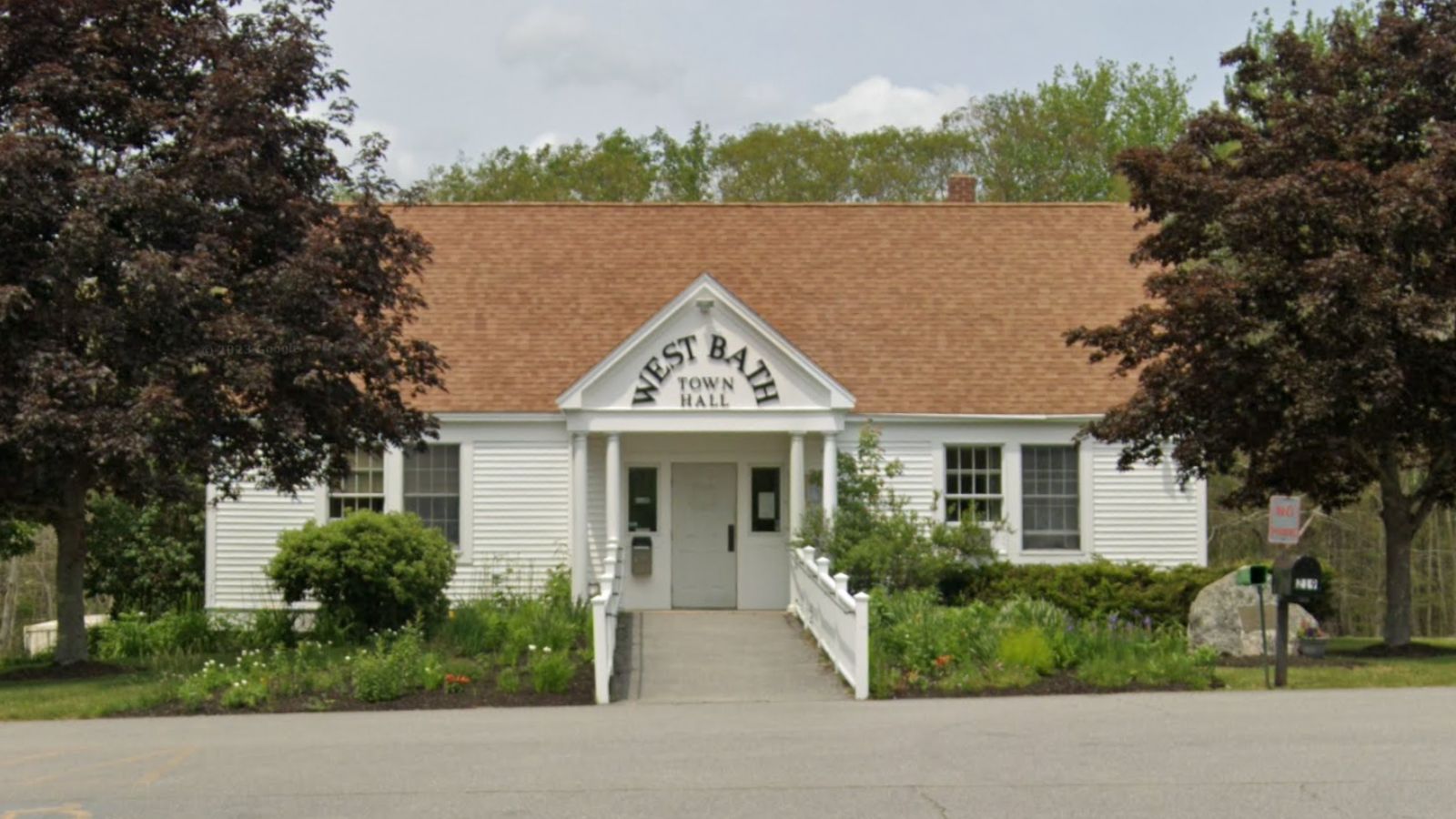
Located in Sagadahoc County along Maine’s midcoast, West Bath represents one of the state’s most rapidly appreciating real estate markets, driven by its strategic position between the maritime heritage of Bath and the recreational appeal of Brunswick. This community of approximately 1,960 residents serves as a gateway to Sagadahoc County for travelers on Route 1 North, offering a scenic crossing over the New Meadows River. West Bath’s history traces back to its 1844 incorporation when it separated from Bath, reportedly because West Bath farmers objected to paying taxes for Bath’s sidewalks while they contended with muddy roads.
The town’s appeal stems from its combination of coastal access, rural character, and proximity to major employment centers. West Bath features some of the region’s best clam flats, a bustling commercial district along Route 1, and easy access to both the Kennebec River and New Meadows River waterways. The median household income of $113,750 reflects the community’s affluent population, while the town maintains essential municipal services including West Bath School for K-5 students, an incorporated volunteer fire department, and well-maintained infrastructure.
West Bath’s dramatic home price appreciation reflects broader trends affecting Maine’s midcoast region, where proximity to Portland, Bath Iron Works, and recreational amenities drives significant buyer demand. The community successfully balances residential growth with preservation of its working waterfront character, making it particularly attractive to buyers seeking coastal Maine living with convenient access to employment and cultural centers.
32. Tremont – 61% Home Price Increase Since 2018
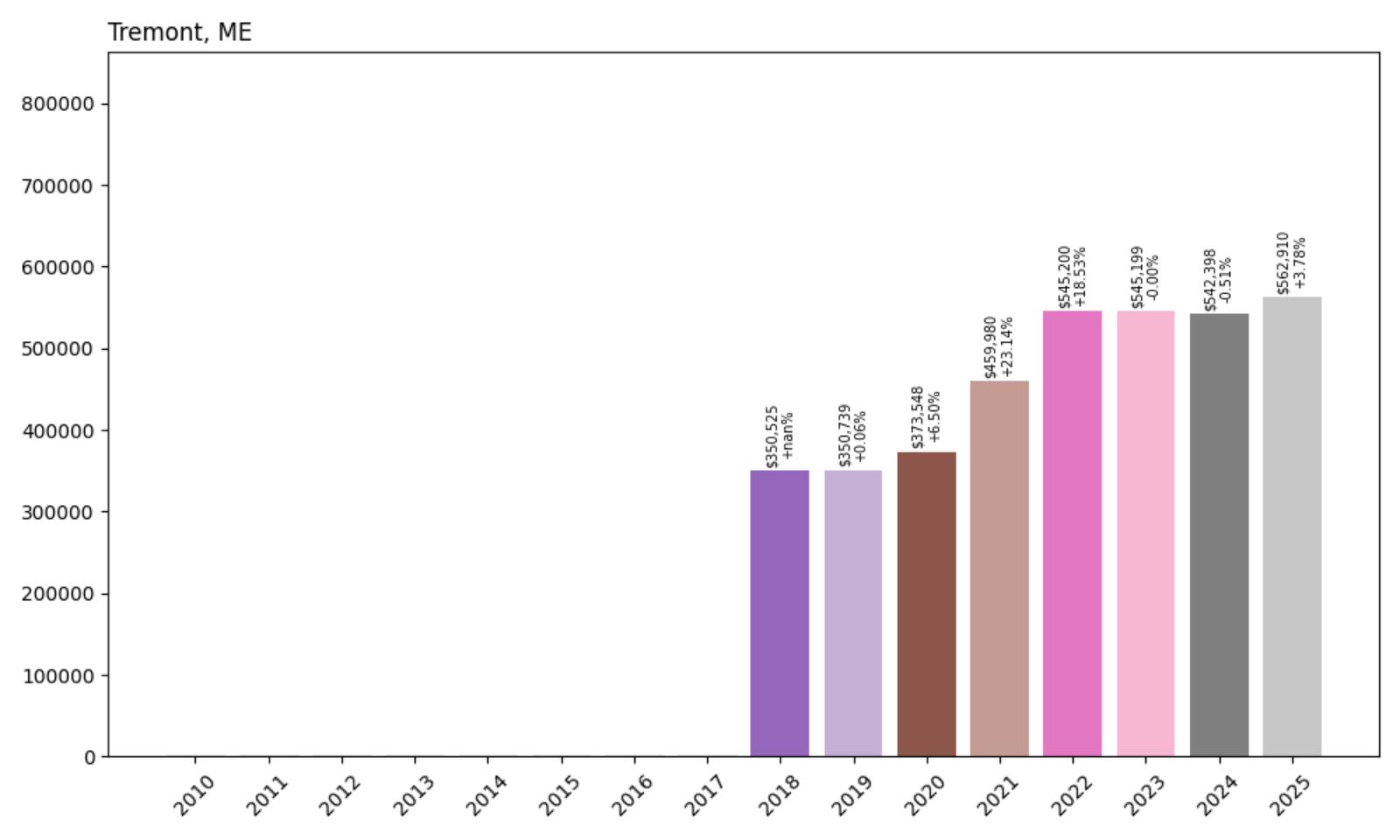
- 2010: N/A
- 2011: N/A
- 2012: N/A
- 2013: N/A
- 2014: N/A
- 2015: N/A
- 2016: N/A
- 2017: N/A
- 2018: $350,525
- 2019: $350,739 (+$214, +0.06% from previous year)
- 2020: $373,548 (+$22,809, +6.50% from previous year)
- 2021: $459,980 (+$86,432, +23.14% from previous year)
- 2022: $545,200 (+$85,219, +18.53% from previous year)
- 2023: $545,199 (−$0, −0.00% from previous year)
- 2024: $542,398 (−$2,801, −0.51% from previous year)
- 2025: $562,910 (+$20,512, +3.78% from previous year)
Tremont’s real estate market illustrates the dramatic impact of the pandemic-era surge on Maine’s island communities, with home values jumping 61% from $350,525 in 2018 to $562,910 in 2025. The Mount Desert Island community experienced minimal growth through 2019 before the pandemic-driven explosion of 2021 and 2022, when prices increased by 23% and 19% respectively. After a brief stabilization period in 2023 and 2024, the market showed renewed momentum in 2025, reflecting sustained demand for properties on Acadia National Park’s “quiet side.”
Tremont – Mount Desert Island’s Quiet Side
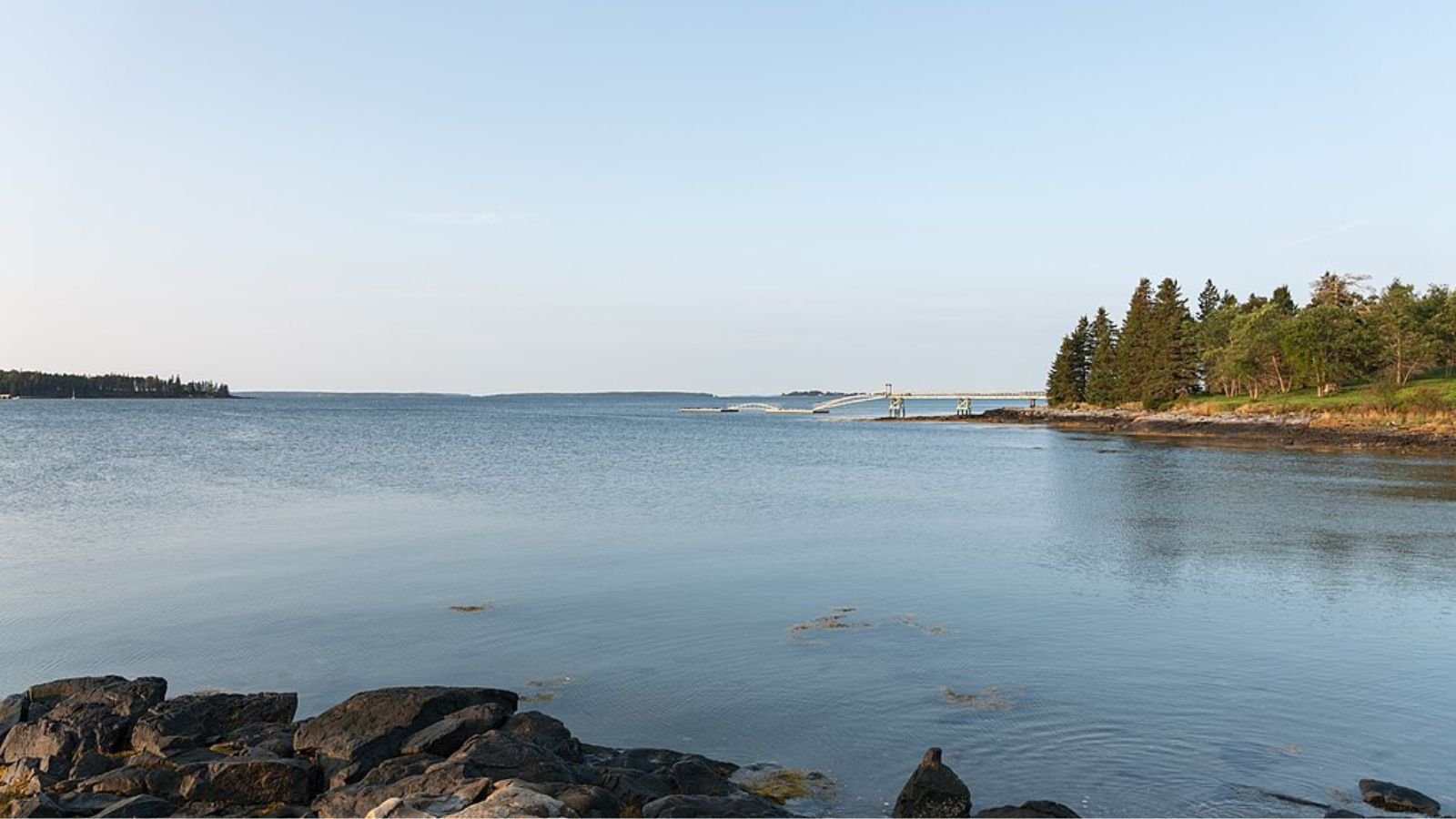
Positioned on the southwestern side of Mount Desert Island, Tremont embodies the authentic Maine fishing village experience that has become increasingly rare along the state’s developed coastline. This Hancock County town of approximately 1,544 residents encompasses five distinct villages – Bass Harbor, Bernard, Seal Cove, West Tremont, and Center – along with jurisdiction over numerous small islands including Gott’s Island. Originally incorporated in 1848 as Mansel and renamed Tremont (French for “three mountains”), the community maintains its maritime heritage through working waterfronts that support commercial fisheries, boat building, and ferry services to Swans Island and Frenchboro.
The community’s working waterfront remains vital to both its economy and identity, with lobster boats, fish houses, and traditional maritime activities continuing to define village life in Bass Harbor and Bernard. This authentic character, combined with access to world-class recreational opportunities and relatively easy access via Route 102, positions Tremont as an increasingly sought-after destination for buyers seeking genuine Maine coastal living. The town’s commitment to preserving its maritime traditions while accommodating tourism and residential growth creates a unique market dynamic that continues to drive real estate appreciation.
31. Bristol – 147% Home Price Increase Since 2012
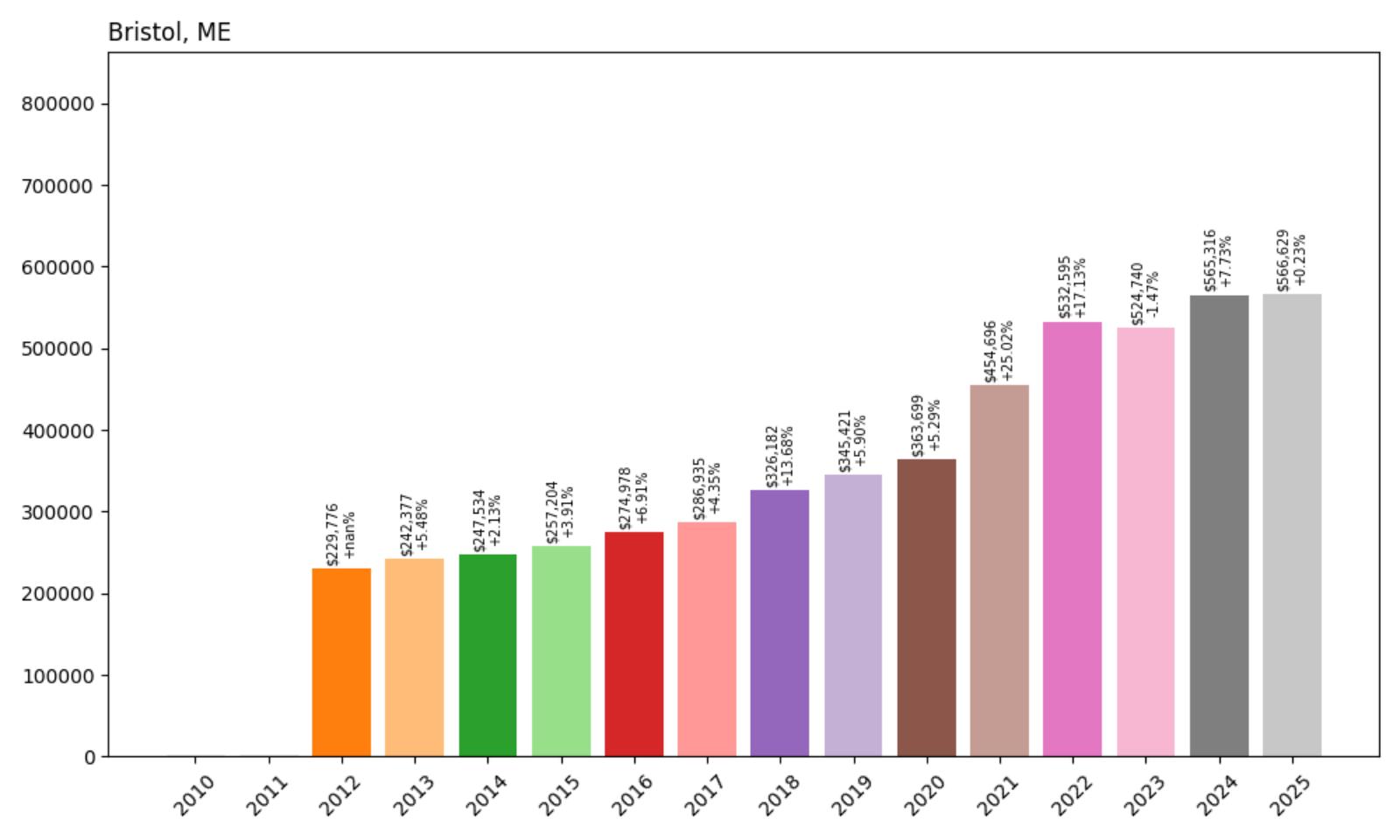
- 2010: N/A
- 2011: N/A
- 2012: $229,776
- 2013: $242,377 (+$12,600, +5.48% from previous year)
- 2014: $247,534 (+$5,157, +2.13% from previous year)
- 2015: $257,204 (+$9,671, +3.91% from previous year)
- 2016: $274,978 (+$17,774, +6.91% from previous year)
- 2017: $286,935 (+$11,957, +4.35% from previous year)
- 2018: $326,182 (+$39,246, +13.68% from previous year)
- 2019: $345,421 (+$19,239, +5.90% from previous year)
- 2020: $363,699 (+$18,278, +5.29% from previous year)
- 2021: $454,696 (+$90,997, +25.02% from previous year)
- 2022: $532,595 (+$77,899, +17.13% from previous year)
- 2023: $524,740 (−$7,855, −1.47% from previous year)
- 2024: $565,316 (+$40,576, +7.73% from previous year)
- 2025: $566,629 (+$1,314, +0.23% from previous year)
Bristol’s remarkable price appreciation reflects the surging demand for properties on Maine’s historic Pemaquid Peninsula, with values increasing 147% from $229,776 in 2012 to $566,629 in 2025. The Lincoln County community experienced steady growth through the late 2010s, accelerating dramatically in 2018 with a 14% jump, followed by the pandemic-era surge of 25% in 2021 and 17% in 2022. After a brief correction in 2023, the market rebounded strongly with nearly 8% growth in 2024, demonstrating the enduring appeal of this coastal destination.
Bristol – Historic Pemaquid Peninsula

Bristol encompasses some of Maine’s most storied coastal territory on the scenic Pemaquid Peninsula, approximately 60 miles north of Portland, incorporating five distinct villages: Bristol Mills, Round Pond, Chamberlain, New Harbor, and Pemaquid. This Lincoln County town of approximately 2,800 residents sits at the heart of one of America’s oldest continuously occupied settlements, with European presence dating to 1625 and Native American habitation stretching back over 7,000 years. The community’s rich history includes multiple forts, colonial settlements, and the famous Pemaquid Point Lighthouse, which graces the Maine state quarter.
The town’s appeal to modern homebuyers stems from its exceptional combination of historical significance, natural beauty, and recreational opportunities. Bristol offers direct access to the Atlantic Ocean through several harbors and is home to world-class attractions including the Colonial Pemaquid State Historic Site, Fort William Henry, and the iconic Pemaquid Point Lighthouse perched dramatically on rocky ledges. The area serves as a departure point for Monhegan Island and features multiple nature preserves managed by organizations including The Nature Conservancy, providing residents with pristine coastal and forest environments.
Bristol’s real estate market reflects its status as one of Maine’s premier coastal destinations, where authentic maritime culture meets exceptional recreational amenities. The community successfully balances preservation of its working waterfront heritage with growth in tourism and residential development, creating sustained demand from buyers seeking both primary and seasonal residences. The town’s location on the Pemaquid Peninsula, combined with its wealth of historical sites, natural preserves, and coastal access, positions Bristol as an increasingly expensive but highly desirable destination for those seeking authentic Maine coastal living with deep historical roots.
30. Boothbay – 114% Home Price Increase Since 2010
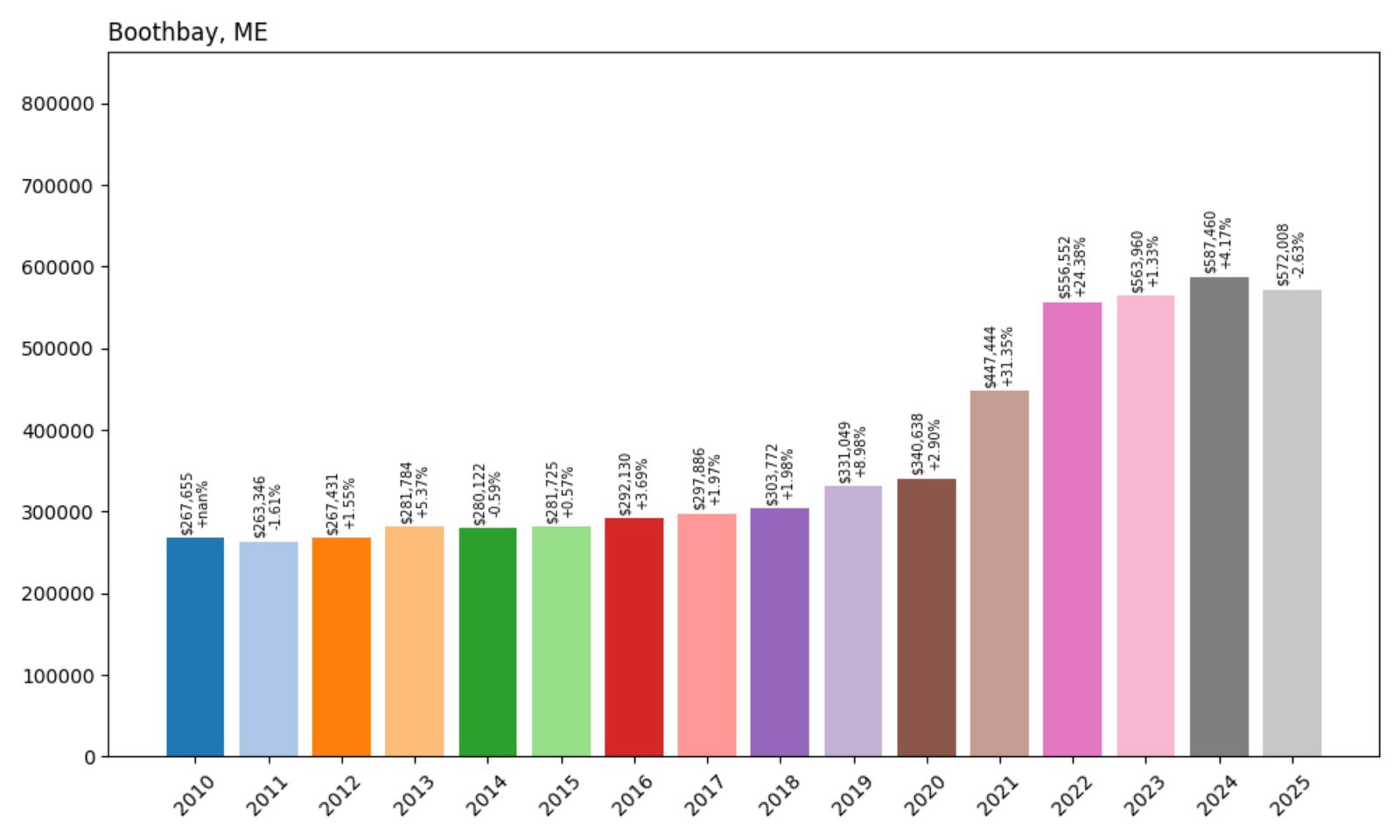
- 2010: $267,655
- 2011: $263,346 (−$4,309, −1.61% from previous year)
- 2012: $267,431 (+$4,085, +1.55% from previous year)
- 2013: $281,784 (+$14,353, +5.37% from previous year)
- 2014: $280,122 (−$1,662, −0.59% from previous year)
- 2015: $281,725 (+$1,602, +0.57% from previous year)
- 2016: $292,130 (+$10,405, +3.69% from previous year)
- 2017: $297,886 (+$5,756, +1.97% from previous year)
- 2018: $303,772 (+$5,886, +1.98% from previous year)
- 2019: $331,049 (+$27,277, +8.98% from previous year)
- 2020: $340,638 (+$9,589, +2.90% from previous year)
- 2021: $447,444 (+$106,806, +31.35% from previous year)
- 2022: $556,552 (+$109,108, +24.38% from previous year)
- 2023: $563,960 (+$7,408, +1.33% from previous year)
- 2024: $587,460 (+$23,500, +4.17% from previous year)
- 2025: $572,008 (−$15,451, −2.63% from previous year)
Boothbay demonstrates the steady appreciation typical of established Maine coastal communities, with home values more than doubling from $267,655 in 2010 to $572,008 in 2025. The Lincoln County town experienced modest but consistent growth through the 2010s before the dramatic pandemic-era acceleration that saw prices surge 31% in 2021 and 24% in 2022. The recent slight decline in 2025 suggests market stabilization after the unprecedented growth period, though values remain substantially elevated from pre-pandemic levels.
Boothbay – Coastal Community Gateway
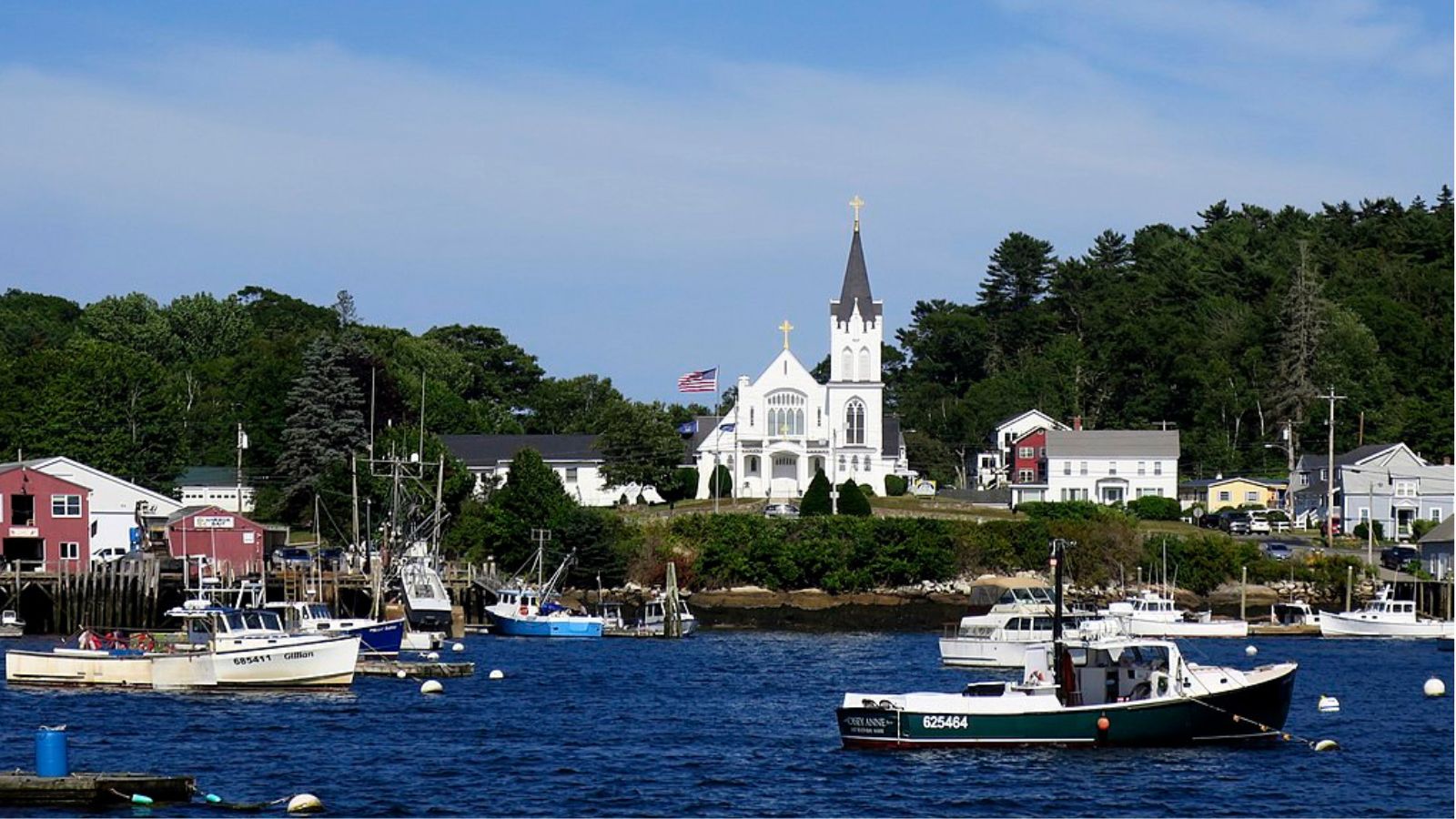
Situated on the Cape Newagen peninsula in Lincoln County, Boothbay serves as both a historical coastal settlement and a modern gateway to the popular Boothbay Harbor region. This community of approximately 3,100 residents encompasses a substantial area of 71.80 square miles, with nearly 70% consisting of water, reflecting its deep connection to Maine’s maritime heritage. The town lies strategically between the Sheepscot and Damariscotta Rivers, providing exceptional access to coastal waters and numerous protected harbors that have supported fishing, boatbuilding, and tourism for centuries.
Boothbay’s appeal to homebuyers stems from its combination of authentic coastal character and proximity to the bustling tourist destination of Boothbay Harbor, which was carved out as a separate municipality in 1889. The town retains much of its historical charm while offering residents the benefits of a less densely developed community with extensive natural areas and water access. The area’s deep, protected harbors historically sheltered hundreds of vessels during storms and continue to attract recreational boaters and fishing operations.
The community’s real estate market reflects its status as a desirable coastal location that offers both year-round residential opportunities and seasonal retreat potential. Boothbay’s large geographic area provides residents with diverse housing options from waterfront properties to inland homes with rural character, while its proximity to Boothbay Harbor ensures access to restaurants, cultural attractions, and marine services. The town’s sustained price appreciation demonstrates the continued appeal of authentic Maine coastal communities that successfully balance residential development with preservation of working waterfront heritage.
29. Portland – 141% Home Price Increase Since 2010
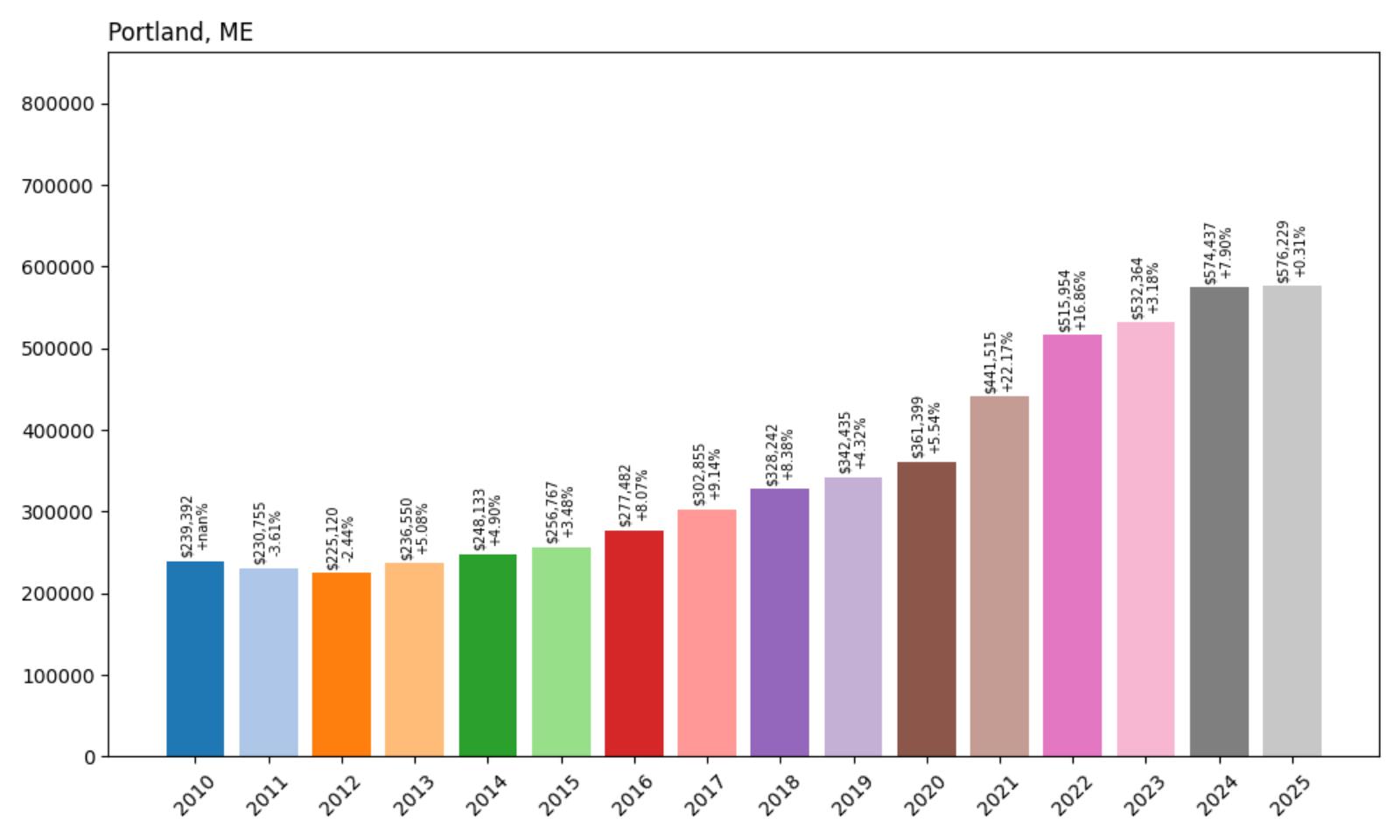
- 2010: $239,392
- 2011: $230,755 (−$8,637, −3.61% from previous year)
- 2012: $225,120 (−$5,635, −2.44% from previous year)
- 2013: $236,550 (+$11,430, +5.08% from previous year)
- 2014: $248,133 (+$11,582, +4.90% from previous year)
- 2015: $256,767 (+$8,635, +3.48% from previous year)
- 2016: $277,482 (+$20,714, +8.07% from previous year)
- 2017: $302,855 (+$25,373, +9.14% from previous year)
- 2018: $328,242 (+$25,387, +8.38% from previous year)
- 2019: $342,435 (+$14,193, +4.32% from previous year)
- 2020: $361,399 (+$18,964, +5.54% from previous year)
- 2021: $441,515 (+$80,117, +22.17% from previous year)
- 2022: $515,954 (+$74,439, +16.86% from previous year)
- 2023: $532,364 (+$16,410, +3.18% from previous year)
- 2024: $574,437 (+$42,072, +7.90% from previous year)
- 2025: $576,229 (+$1,793, +0.31% from previous year)
Portland’s housing market exemplifies the dramatic transformation of Maine’s largest city, with home values more than doubling from $239,392 in 2010 to $576,229 in 2025. The Cumberland County city experienced a brief decline in the early 2010s before beginning steady appreciation that accelerated significantly from 2016 onward. The pandemic-era surge saw remarkable increases of 22% in 2021 and 17% in 2022, followed by continued strong growth of nearly 8% in 2024, demonstrating Portland’s emergence as one of New England’s most dynamic real estate markets.
Portland – Maine’s Cultural and Economic Capital
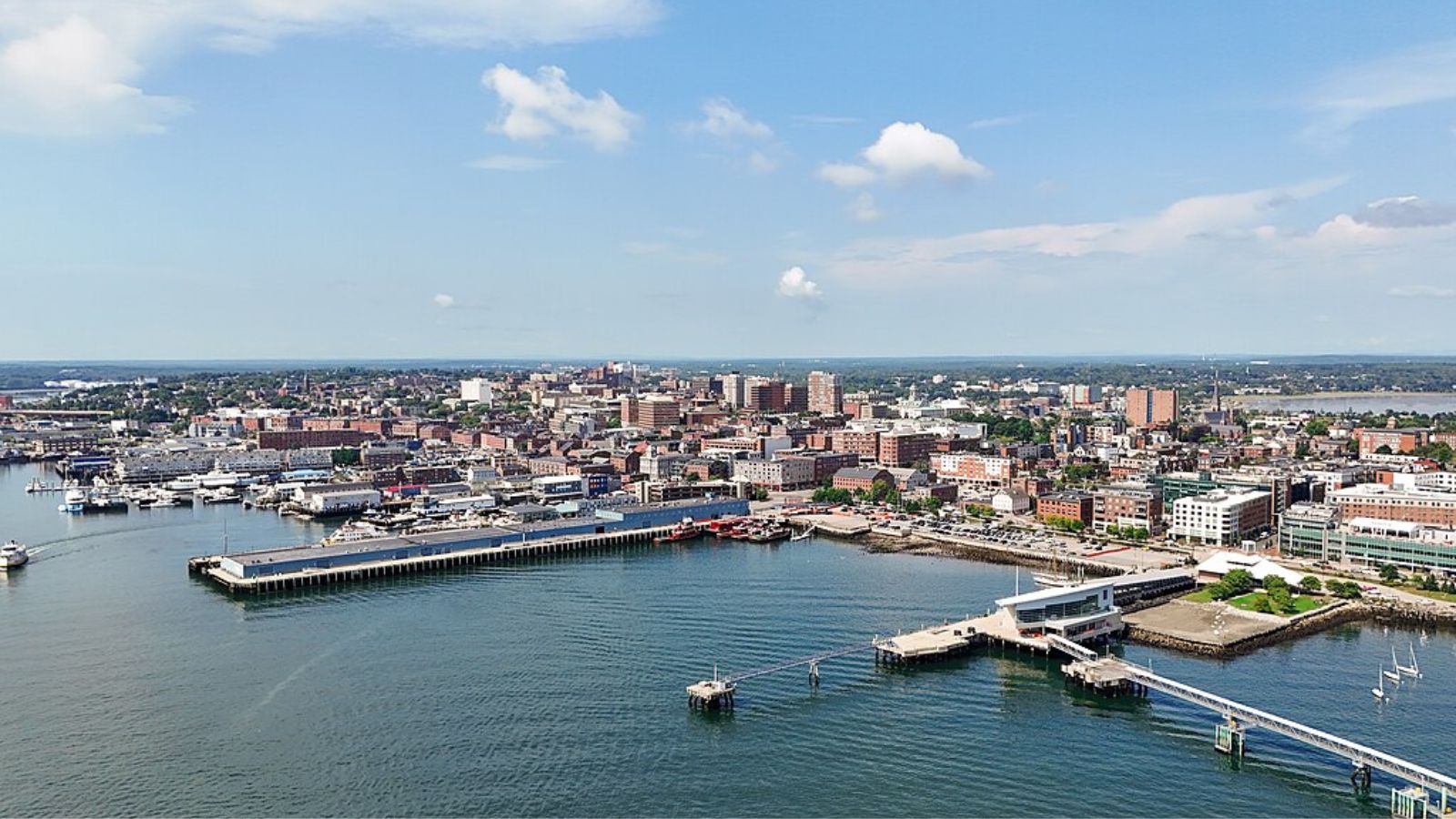
As Maine’s largest city and Cumberland County seat, Portland stands as the cultural and economic heart of the state, with a population of approximately 69,100 residents and a metropolitan area exceeding 550,000 people. The city has undergone remarkable transformation over the past two decades, evolving from a declining industrial port into a thriving center for technology, finance, healthcare, and tourism. Portland’s revitalized downtown, anchored by the historic Old Port district, now features award-winning restaurants, craft breweries, arts venues, and technology companies that have earned the city national recognition as one of America’s most livable small cities.
Portland’s real estate market reflects its emergence as a major regional destination, driven by job growth, cultural amenities, and quality of life improvements. The city serves as headquarters for major corporations including IDEXX Laboratories, Unum, and TD Bank, while its port remains the second-largest oil port on the East Coast. The revitalization of neighborhoods like the Arts District, East Bayside, and Munjoy Hill has created diverse housing options from historic brownstones to modern condominiums, attracting young professionals, empty nesters, and families seeking urban amenities with coastal access.
The city’s housing challenges include limited inventory and rapid price appreciation that has outpaced income growth, leading to innovative policy responses including inclusionary zoning and rent stabilization measures. Portland’s combination of economic opportunity, cultural vibrancy, excellent restaurants, walkable neighborhoods, and proximity to both mountains and ocean continues to drive strong demand from buyers seeking urban sophistication in a manageable-scale New England city setting.
28. Southwest Harbor – 82% Home Price Increase Since 2010
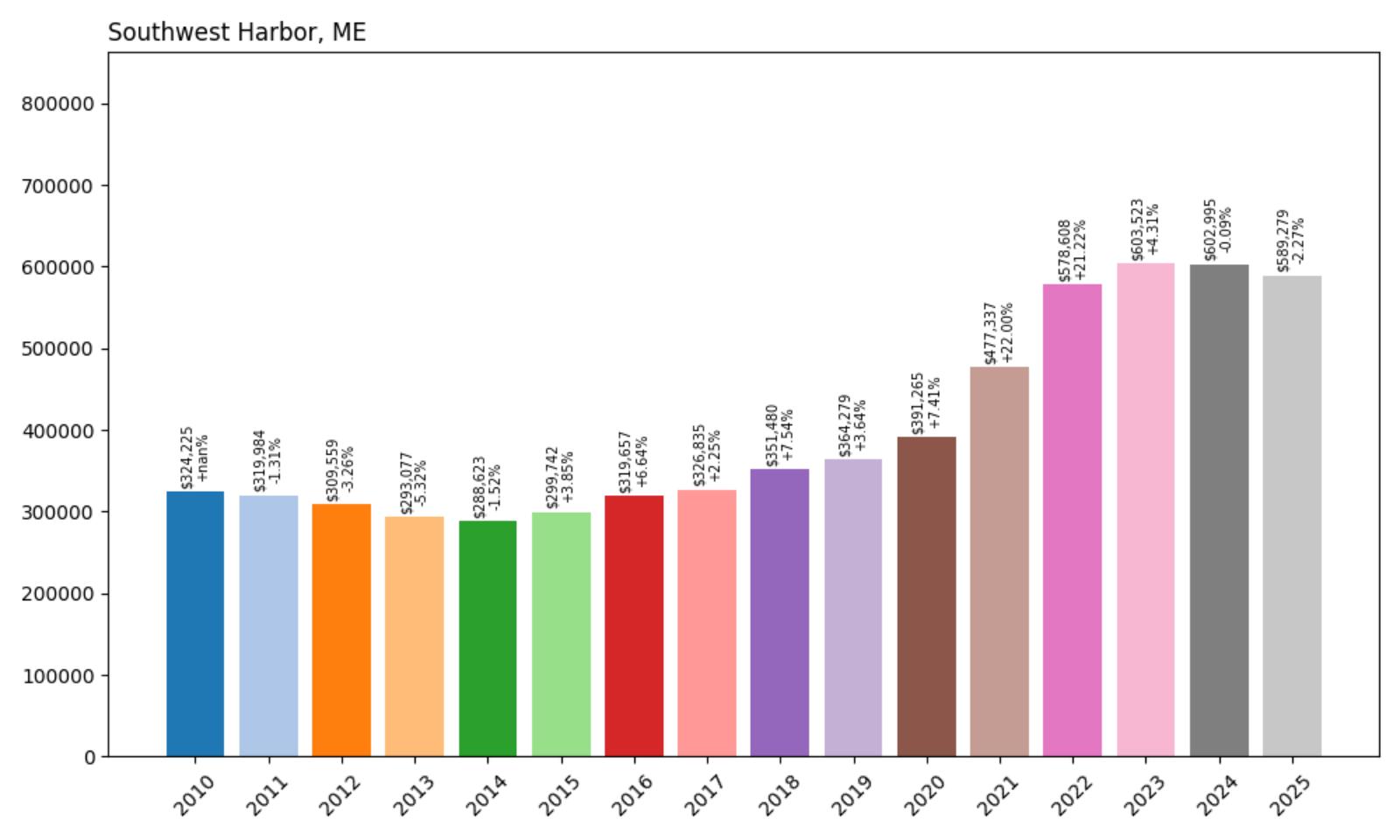
- 2010: $324,225
- 2011: $319,984 (−$4,241, −1.31% from previous year)
- 2012: $309,559 (−$10,424, −3.26% from previous year)
- 2013: $293,077 (−$16,482, −5.32% from previous year)
- 2014: $288,623 (−$4,455, −1.52% from previous year)
- 2015: $299,742 (+$11,119, +3.85% from previous year)
- 2016: $319,657 (+$19,916, +6.64% from previous year)
- 2017: $326,835 (+$7,177, +2.25% from previous year)
- 2018: $351,480 (+$24,645, +7.54% from previous year)
- 2019: $364,279 (+$12,799, +3.64% from previous year)
- 2020: $391,265 (+$26,986, +7.41% from previous year)
- 2021: $477,337 (+$86,072, +22.00% from previous year)
- 2022: $578,608 (+$101,271, +21.22% from previous year)
- 2023: $603,523 (+$24,916, +4.31% from previous year)
- 2024: $602,995 (−$529, −0.09% from previous year)
- 2025: $589,279 (−$13,716, −2.27% from previous year)
Southwest Harbor’s home price trajectory showcases the unique dynamics of Mount Desert Island’s real estate market, with values increasing 82% from $324,225 in 2010 to $589,279 in 2025. The Hancock County community experienced a significant decline through the mid-2010s before recovering and then participating in the dramatic pandemic-era surge that saw consecutive increases of 22% in 2021 and 21% in 2022. Recent slight declines suggest market stabilization at elevated levels, reflecting the sustained premium for properties on this premier section of Mount Desert Island.
Southwest Harbor – Premier Mount Desert Island Community

Southwest Harbor represents the pinnacle of Mount Desert Island living, serving as the largest municipality on the island’s southwestern “quiet side” and home to approximately 1,756 year-round residents. Located at the southwest entrance to Somes Sound – the only fjord on the East Coast – this Hancock County community has evolved from a 19th-century fishing and shipbuilding center into one of Maine’s most prestigious coastal destinations. The town encompasses the picturesque villages of Southwest Harbor, Manset, Seawall, Wonderland, and Pemetic Hills, each offering distinct character while sharing access to Acadia National Park’s pristine landscapes.
The community’s appeal stems from its unique combination of maritime heritage, world-class boatbuilding industry, and proximity to Acadia National Park. Southwest Harbor hosts renowned yacht manufacturers including Hinckley Yachts, Morris Yachts, and Ellis Boat Company, whose craftsmanship defines excellence in recreational boating. The historic Claremont Hotel, built in 1883 and listed on the National Register of Historic Places, epitomizes the area’s tradition of elegant summer hospitality that has attracted wealthy families for over a century.
Southwest Harbor’s real estate market reflects its status as one of New England’s most exclusive seasonal destinations, where waterfront properties command premium prices and year-round homes benefit from the town’s exceptional natural setting. The community offers unparalleled access to Acadia National Park, world-class hiking and sailing opportunities, and cultural attractions including the Wendell Gilley Museum. With views of Bear Island Lighthouse, the Cranberry Islands, and the open Atlantic, Southwest Harbor continues to attract discerning buyers seeking the ultimate Maine coastal experience in a setting that successfully balances exclusivity with authentic maritime character.
27. Pownal – 53% Home Price Increase Since 2019
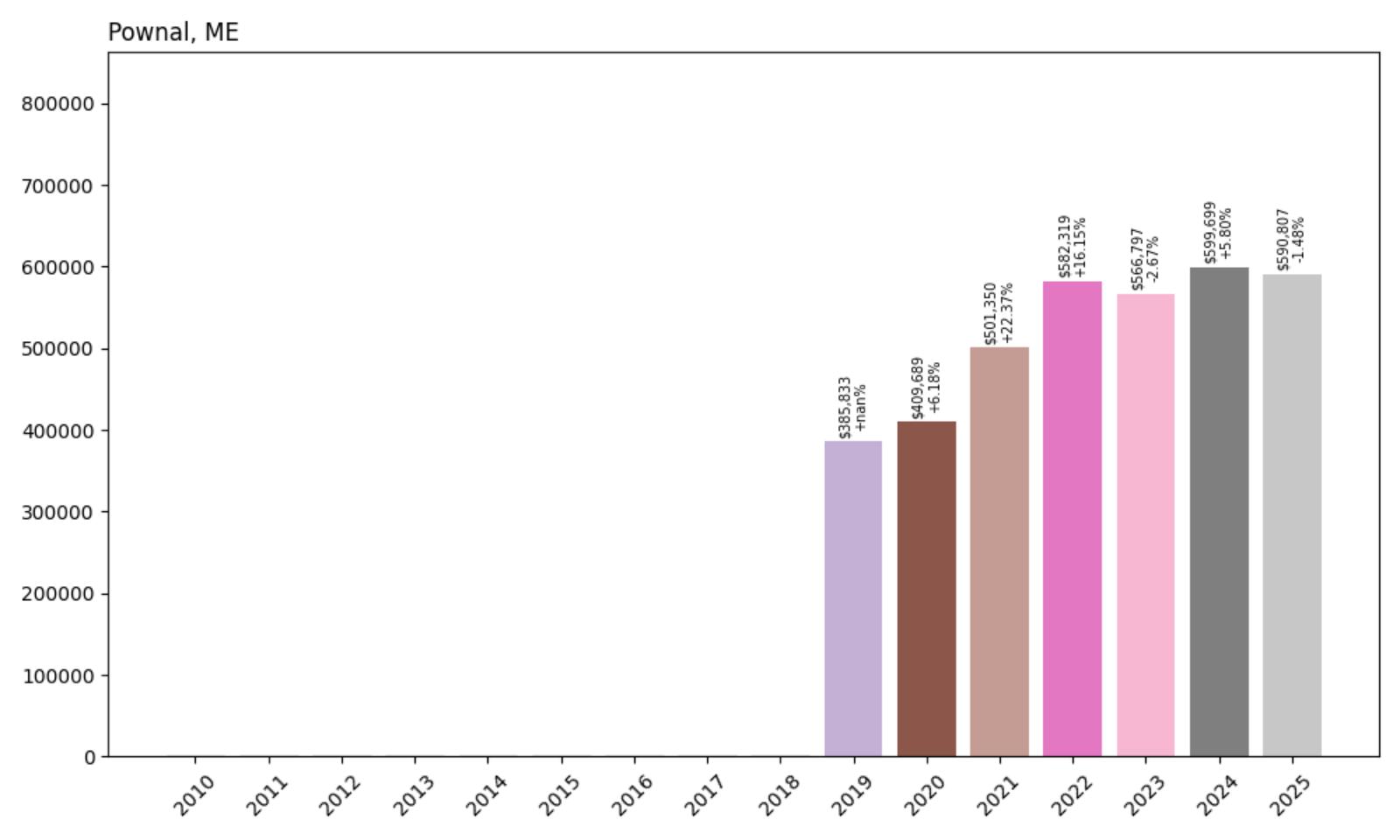
- 2010: N/A
- 2011: N/A
- 2012: N/A
- 2013: N/A
- 2014: N/A
- 2015: N/A
- 2016: N/A
- 2017: N/A
- 2018: N/A
- 2019: $385,833
- 2020: $409,689 (+$23,856, +6.18% from previous year)
- 2021: $501,350 (+$91,661, +22.37% from previous year)
- 2022: $582,319 (+$80,969, +16.15% from previous year)
- 2023: $566,797 (−$15,521, −2.67% from previous year)
- 2024: $599,699 (+$32,902, +5.80% from previous year)
- 2025: $590,807 (−$8,892, −1.48% from previous year)
Pownal’s limited data shows dramatic appreciation since 2019, with home values increasing 53% from $385,833 to $590,807 in 2025. This Cumberland County community experienced the typical pandemic-era surge with consecutive increases of 22% in 2021 and 16% in 2022, followed by a brief decline and subsequent recovery. The town’s emergence in the expensive home market reflects growing demand for rural properties within commuting distance of Portland while maintaining access to recreational amenities and high-quality schools.
Pownal – Rural Cumberland County Retreat
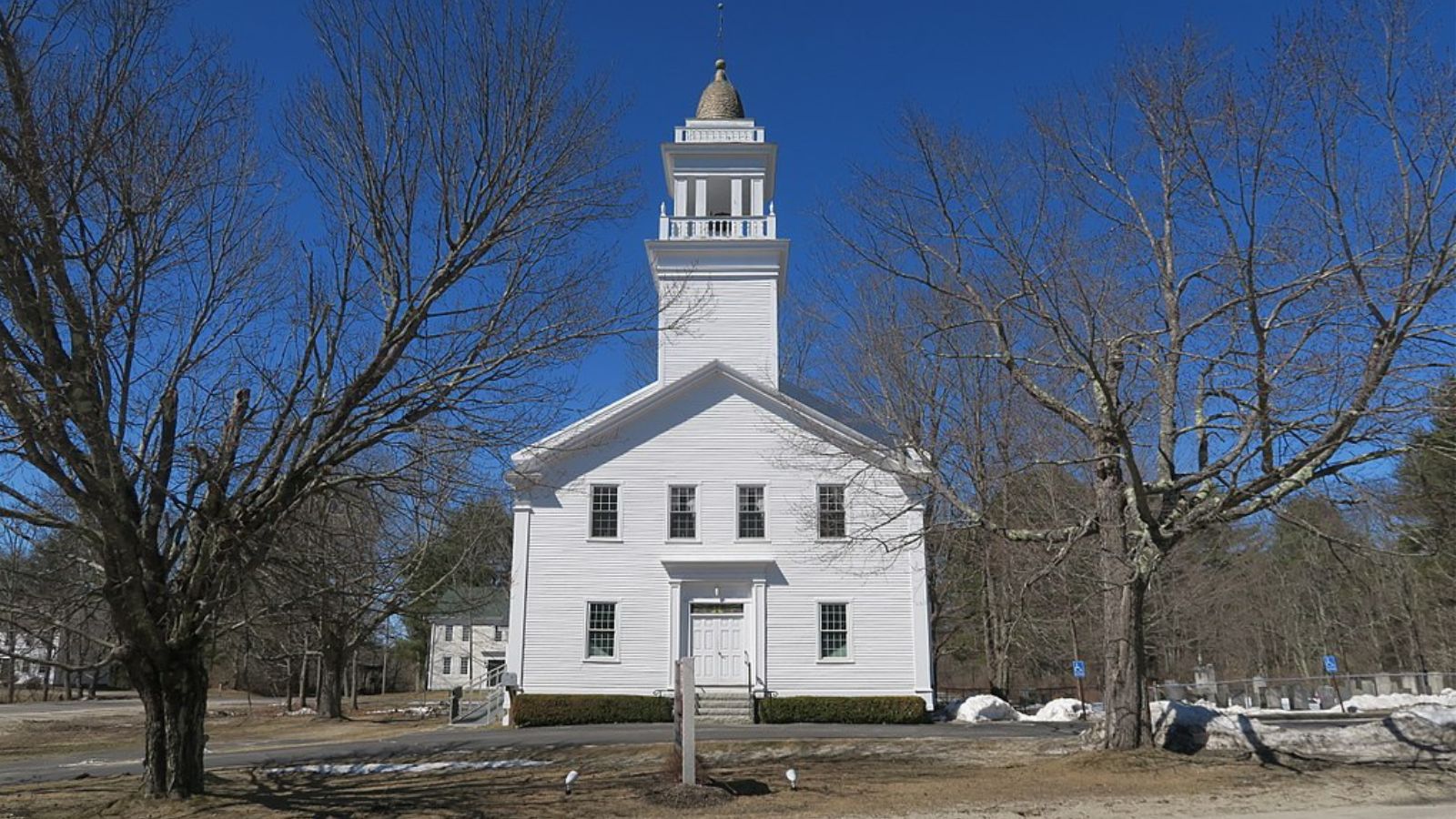
Nestled in northern Cumberland County, Pownal represents the quintessential rural Maine experience while maintaining convenient access to Portland’s metropolitan amenities. This community of approximately 1,566 residents encompasses 22.88 square miles of dense Maine forests, rolling pastures, and historic farmland, where properties typically range from five to ten acres and traditional New England farmhouses dot quiet country roads. Originally settled in 1680 and incorporated in 1808 from a portion of Freeport, Pownal was named in honor of former Massachusetts Governor Thomas Pownall and has maintained its agricultural and rural character for over two centuries.
Pownal’s appeal stems from its unique combination of rural tranquility and strategic location, positioned just seven miles from Freeport’s shopping and nine miles from Yarmouth, with Portland only 24 miles south via Interstate 295. The town is home to Bradbury Mountain State Park, which offers hiking trails, picnicking areas, and panoramic views of the surrounding countryside. The community maintains its close-knit character through events at the historic 1886 Mallett Hall, including the annual Pownal Pumpkin Festival and Bradbury Mountain Arts Show, while the Pineland Center houses numerous non-profits and local businesses.
The town’s real estate market reflects growing demand from buyers seeking rural properties that offer both privacy and convenience to urban centers. Pownal’s comprehensive plan emphasizes rural preservation and limited development, with officials working to maintain the community’s agricultural character while accommodating moderate growth – approximately 11 new homes per year since 2016. The town’s median home price of $749,999 reflects its desirability among buyers seeking spacious properties with acreage, excellent schools through MSAD 51, and a genuine neighbor-helping-neighbor community atmosphere that has become increasingly rare in Cumberland County.
26. Carrabassett Valley – 113% Home Price Increase Since 2010
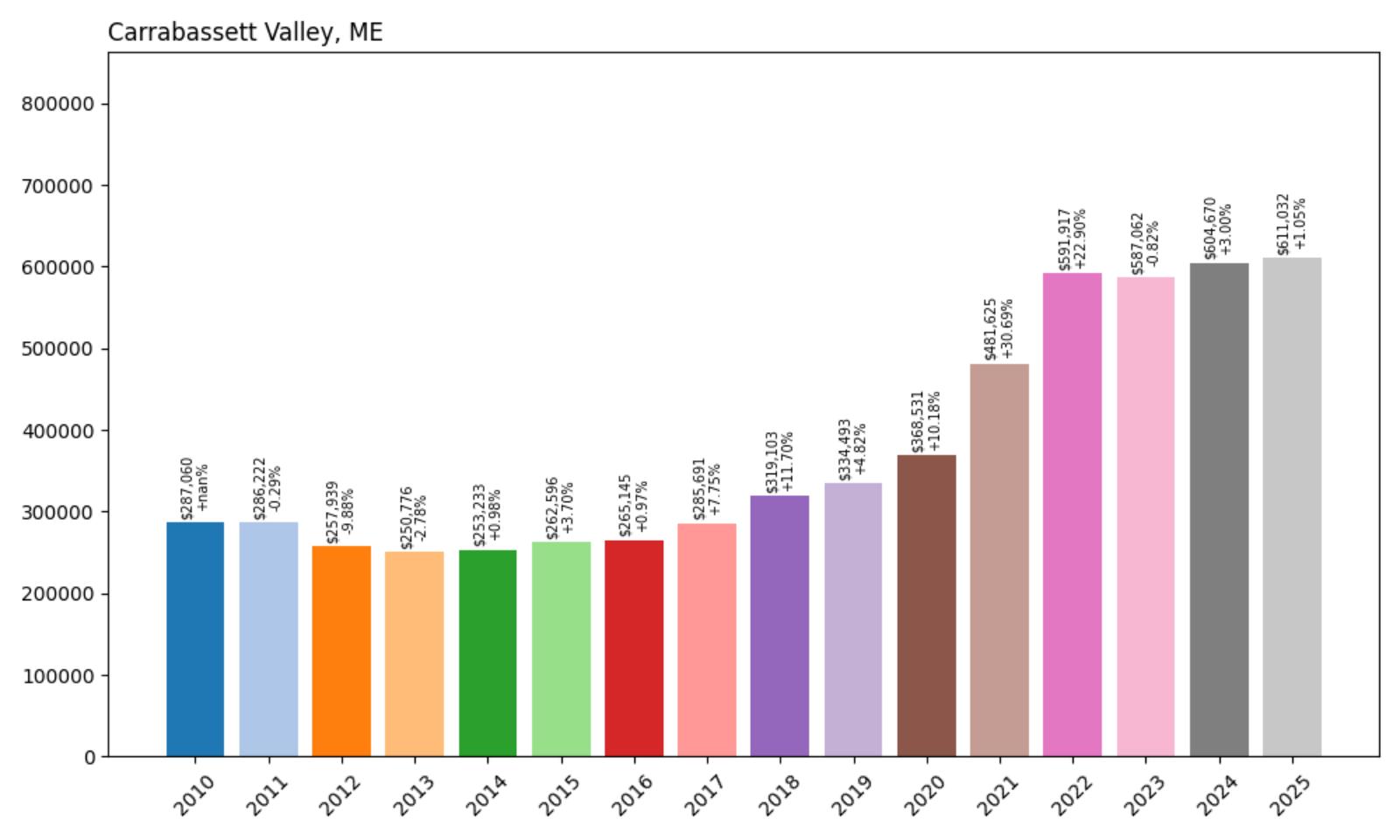
- 2010: $287,060
- 2011: $286,222 (−$838, −0.29% from previous year)
- 2012: $257,939 (−$28,283, −9.88% from previous year)
- 2013: $250,776 (−$7,163, −2.78% from previous year)
- 2014: $253,233 (+$2,457, +0.98% from previous year)
- 2015: $262,596 (+$9,363, +3.70% from previous year)
- 2016: $265,145 (+$2,549, +0.97% from previous year)
- 2017: $285,691 (+$20,546, +7.75% from previous year)
- 2018: $319,103 (+$33,412, +11.70% from previous year)
- 2019: $334,493 (+$15,390, +4.82% from previous year)
- 2020: $368,531 (+$34,038, +10.18% from previous year)
- 2021: $481,625 (+$113,094, +30.69% from previous year)
- 2022: $591,917 (+$110,292, +22.90% from previous year)
- 2023: $587,062 (−$4,855, −0.82% from previous year)
- 2024: $604,670 (+$17,607, +3.00% from previous year)
- 2025: $611,032 (+$6,362, +1.05% from previous year)
Carrabassett Valley’s home price evolution showcases the dramatic transformation of Maine’s premier skiing destination, with values increasing 113% from $287,060 in 2010 to $611,032 in 2025. The Franklin County community experienced significant decline through the mid-2010s before beginning steady recovery in 2017, followed by explosive pandemic-era growth that saw prices surge 31% in 2021 and 23% in 2022. The sustained high values reflect the exceptional demand for mountain properties near Sugarloaf Mountain Resort and the area’s transformation into a year-round recreational destination.
Carrabassett Valley – Mountain Resort Paradise

Carrabassett Valley stands as Maine’s premier mountain resort destination, home to Sugarloaf Mountain Resort and some of the most spectacular alpine scenery in New England. This Franklin County community was incorporated in 1972 specifically to support the development of Sugarloaf, making it one of Maine’s newest municipalities. At 4,237 feet, Sugarloaf Mountain ranks as the third highest peak in Maine and offers the only lift-serviced above-treeline skiing in the Northeast, with 1,360 skiable acres making it the second largest ski resort east of the Mississippi River.
The valley’s transformation from remote wilderness to world-class resort destination reflects the vision of combining exceptional natural resources with sophisticated recreational amenities. Sugarloaf offers year-round activities including skiing, snowboarding, golf at Robert Trent Jones Jr.’s acclaimed course, mountain biking, hiking, and access to 80+ miles of cross-country trails. The resort’s continuous vertical drop of 2,820 feet ranks as the second longest in New England, while its 95% snowmaking capability ensures reliable conditions throughout the ski season.
Carrabassett Valley’s real estate market serves buyers seeking mountain properties that provide both recreational access and investment potential in one of New England’s most established resort communities. The area attracts second-home owners, vacation rental investors, and year-round residents who value access to world-class skiing, championship golf, and endless outdoor recreation opportunities. Properties range from slope-side condominiums to luxury mountain homes, all benefiting from the valley’s unique combination of natural beauty, recreational amenities, and the economic stability provided by Sugarloaf’s reputation as a premier destination resort.
25. Eliot – 104% Home Price Increase Since 2010
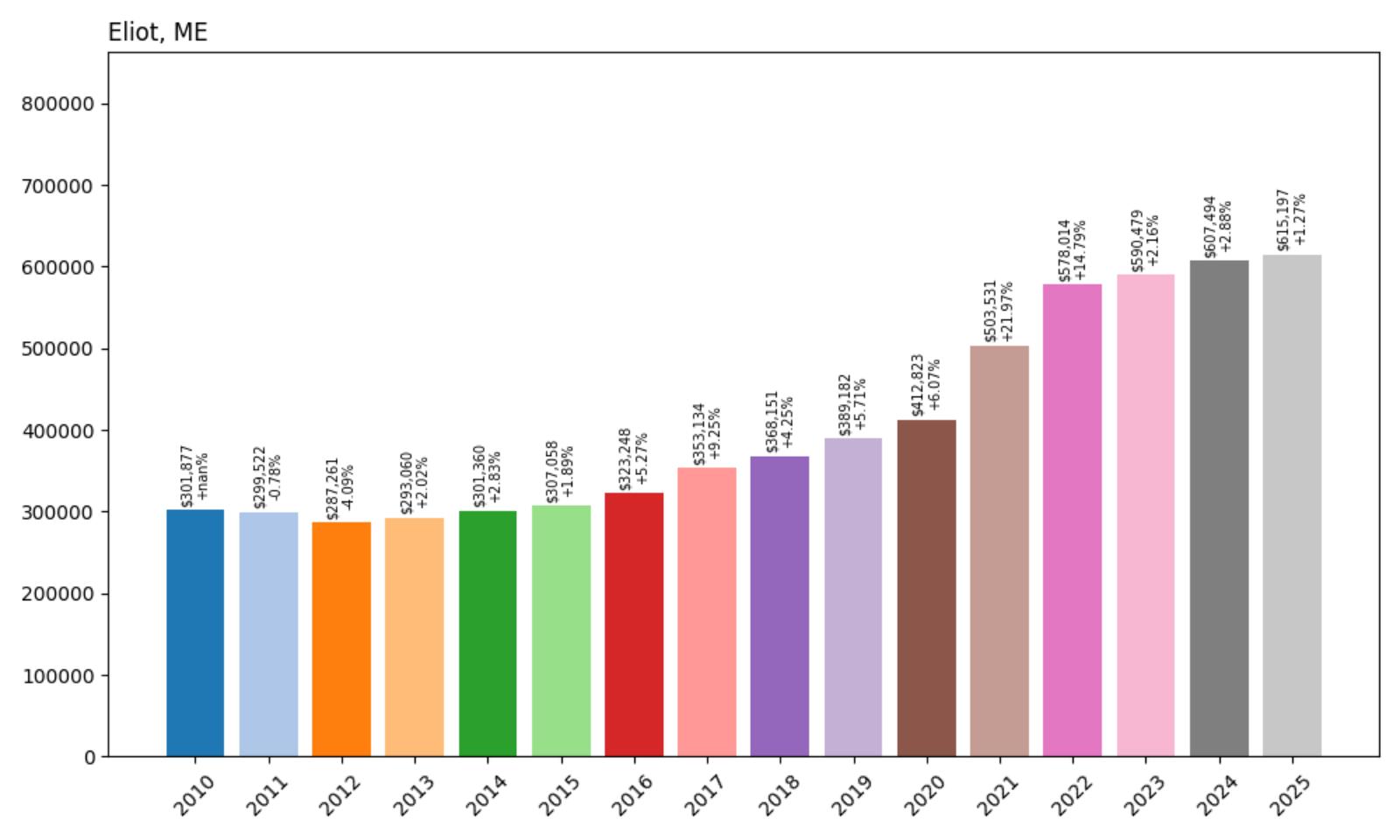
- 2010: $301,877
- 2011: $299,522 (−$2,356, −0.78% from previous year)
- 2012: $287,261 (−$12,261, −4.09% from previous year)
- 2013: $293,060 (+$5,800, +2.02% from previous year)
- 2014: $301,360 (+$8,299, +2.83% from previous year)
- 2015: $307,058 (+$5,698, +1.89% from previous year)
- 2016: $323,248 (+$16,190, +5.27% from previous year)
- 2017: $353,134 (+$29,887, +9.25% from previous year)
- 2018: $368,151 (+$15,016, +4.25% from previous year)
- 2019: $389,182 (+$21,032, +5.71% from previous year)
- 2020: $412,823 (+$23,640, +6.07% from previous year)
- 2021: $503,531 (+$90,709, +21.97% from previous year)
- 2022: $578,014 (+$74,483, +14.79% from previous year)
- 2023: $590,479 (+$12,464, +2.16% from previous year)
- 2024: $607,494 (+$17,015, +2.88% from previous year)
- 2025: $615,197 (+$7,703, +1.27% from previous year)
Eliot’s steady home price appreciation demonstrates the consistent appeal of southern Maine communities that offer both rural character and strategic location advantages. With values more than doubling from $301,877 in 2010 to $615,197 in 2025, this York County town experienced the typical pandemic-era acceleration with increases of 22% in 2021 and 15% in 2022. The community’s sustained growth reflects its position as an attractive option for buyers seeking small-town amenities with convenient access to both Portsmouth, New Hampshire, and the greater Seacoast region.
Eliot – Seacoast Border Community
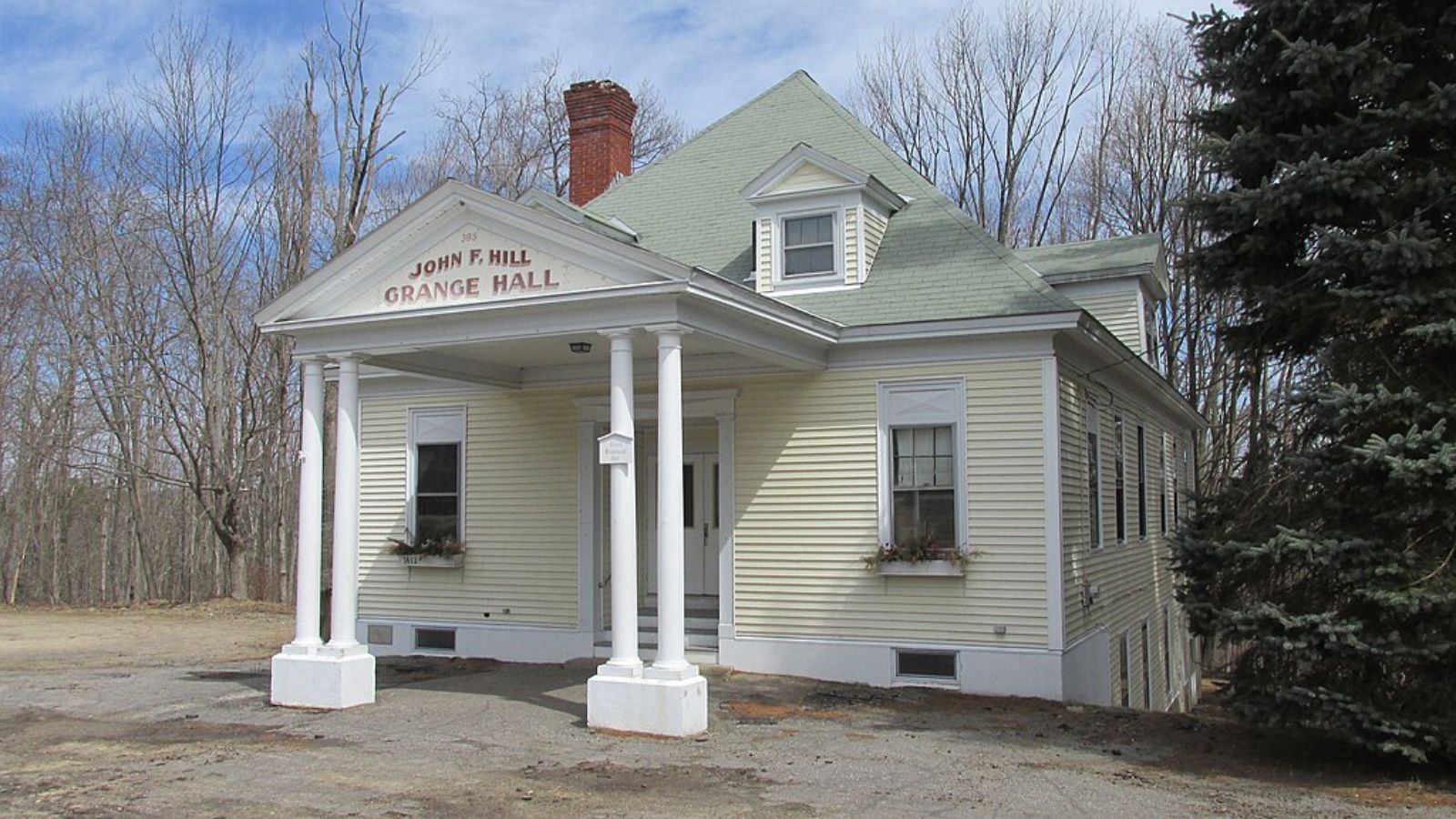
Strategically positioned on the Piscataqua River directly across from Portsmouth, New Hampshire, Eliot represents one of Maine’s most southerly communities and serves as a gateway between the Pine Tree State and the thriving Seacoast region. This York County town of approximately 6,700 residents combines rural New England character with convenient access to major employment centers, educational institutions, and cultural amenities in both Maine and New Hampshire. Originally settled in 1623 and incorporated in 1810 after separating from Kittery, Eliot maintains its historical charm while serving as an attractive residential community for commuters and families seeking small-town living with metropolitan access.
Eliot’s appeal stems from its unique combination of rural tranquility and strategic location, offering residents the benefits of Maine’s quality of life while providing easy access to Portsmouth’s job market, cultural attractions, and urban amenities. The town features numerous historical sites including Ambush Rock, Green Acre, and the Raitt Homestead Farm Museum, while maintaining extensive open spaces and agricultural lands that preserve its rural character. The median household income of $93,231 reflects the community’s success in attracting professionals who value the ability to live in Maine while working in the broader Seacoast economy.
The town’s real estate market benefits from its position as a border community that offers lower Maine property taxes compared to New Hampshire while maintaining excellent access to Portsmouth and the greater Seacoast region via multiple state routes and proximity to Interstate 95. Eliot’s commitment to preserving its rural feel while accommodating moderate growth makes it particularly attractive to buyers seeking a small-town atmosphere with convenient access to employment, education, and recreational opportunities in both states. The community’s above-average schools and low crime rates further enhance its appeal to families and professionals seeking a high quality of life in southern Maine.
24. Kennebunk – 134% Home Price Increase Since 2010
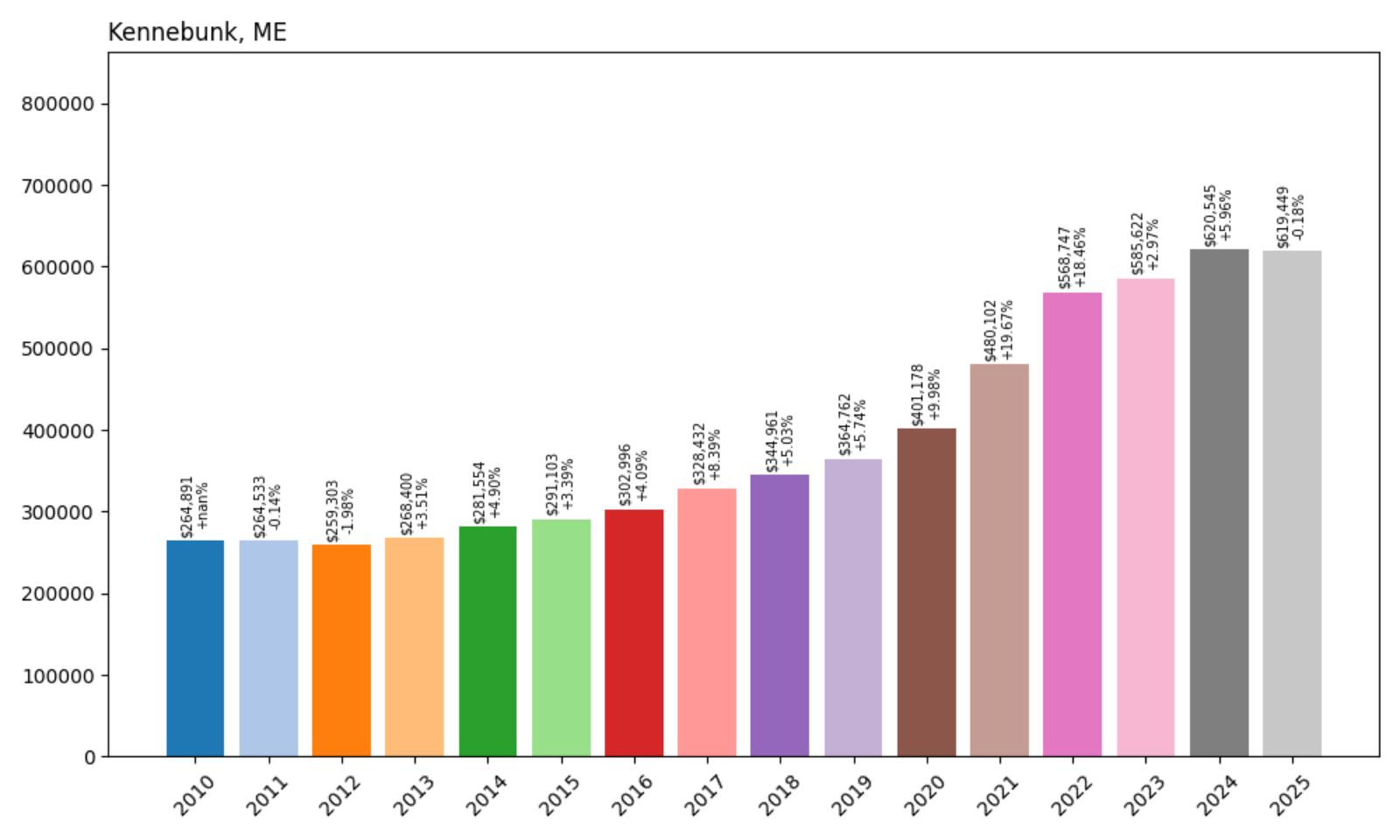
- 2010: $264,891
- 2011: $264,533 (−$358, −0.14% from previous year)
- 2012: $259,303 (−$5,231, −1.98% from previous year)
- 2013: $268,400 (+$9,097, +3.51% from previous year)
- 2014: $281,554 (+$13,154, +4.90% from previous year)
- 2015: $291,103 (+$9,549, +3.39% from previous year)
- 2016: $302,996 (+$11,893, +4.09% from previous year)
- 2017: $328,432 (+$25,435, +8.39% from previous year)
- 2018: $344,961 (+$16,530, +5.03% from previous year)
- 2019: $364,762 (+$19,801, +5.74% from previous year)
- 2020: $401,178 (+$36,416, +9.98% from previous year)
- 2021: $480,102 (+$78,924, +19.67% from previous year)
- 2022: $568,747 (+$88,645, +18.46% from previous year)
- 2023: $585,622 (+$16,875, +2.97% from previous year)
- 2024: $620,545 (+$34,923, +5.96% from previous year)
- 2025: $619,449 (−$1,096, −0.18% from previous year)
Kennebunk’s impressive home price growth demonstrates the strong market dynamics affecting Maine’s most desirable coastal communities, with values increasing 134% from $264,891 in 2010 to $619,449 in 2025. This York County town experienced steady appreciation through the 2010s before accelerating significantly during the pandemic years with increases of nearly 20% in 2021 and 18% in 2022. The market has stabilized at elevated levels, with slight declines in 2025 following continued growth in 2024, reflecting the premium buyers are willing to pay for authentic Maine coastal living with small-town charm.
Kennebunk – Historic Coastal Village
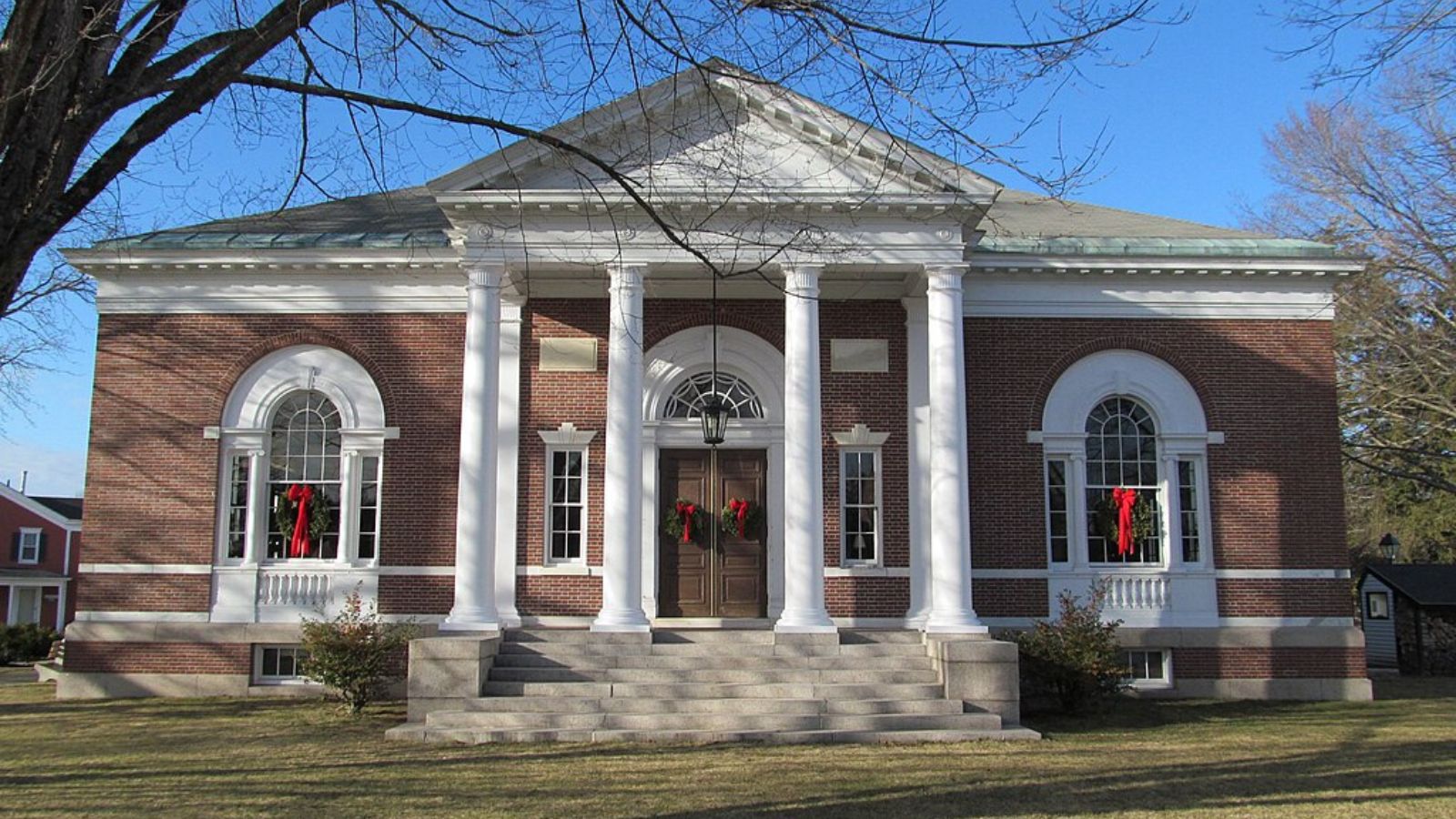
Kennebunk embodies the quintessential Maine coastal experience, combining rich maritime heritage with contemporary amenities and serving as the commercial and cultural heart of the famous Kennebunk-Kennebunkport region. This historic York County community offers residents and visitors an authentic New England coastal lifestyle with charming downtown shops, excellent restaurants, pristine beaches, and well-preserved 19th-century architecture that reflects its prosperous shipbuilding and maritime trading past.
The town’s enduring appeal stems from its perfect balance of historical authenticity and modern convenience, featuring walkable village centers, quality schools, recreational facilities, and proximity to some of Maine’s most beautiful beaches. Kennebunk’s location provides easy access to both the cultural attractions of neighboring Kennebunkport and the employment opportunities of the greater Portland metropolitan area, making it attractive to both year-round residents and seasonal property owners seeking genuine Maine coastal living.
23. Rockport – 133% Home Price Increase Since 2010
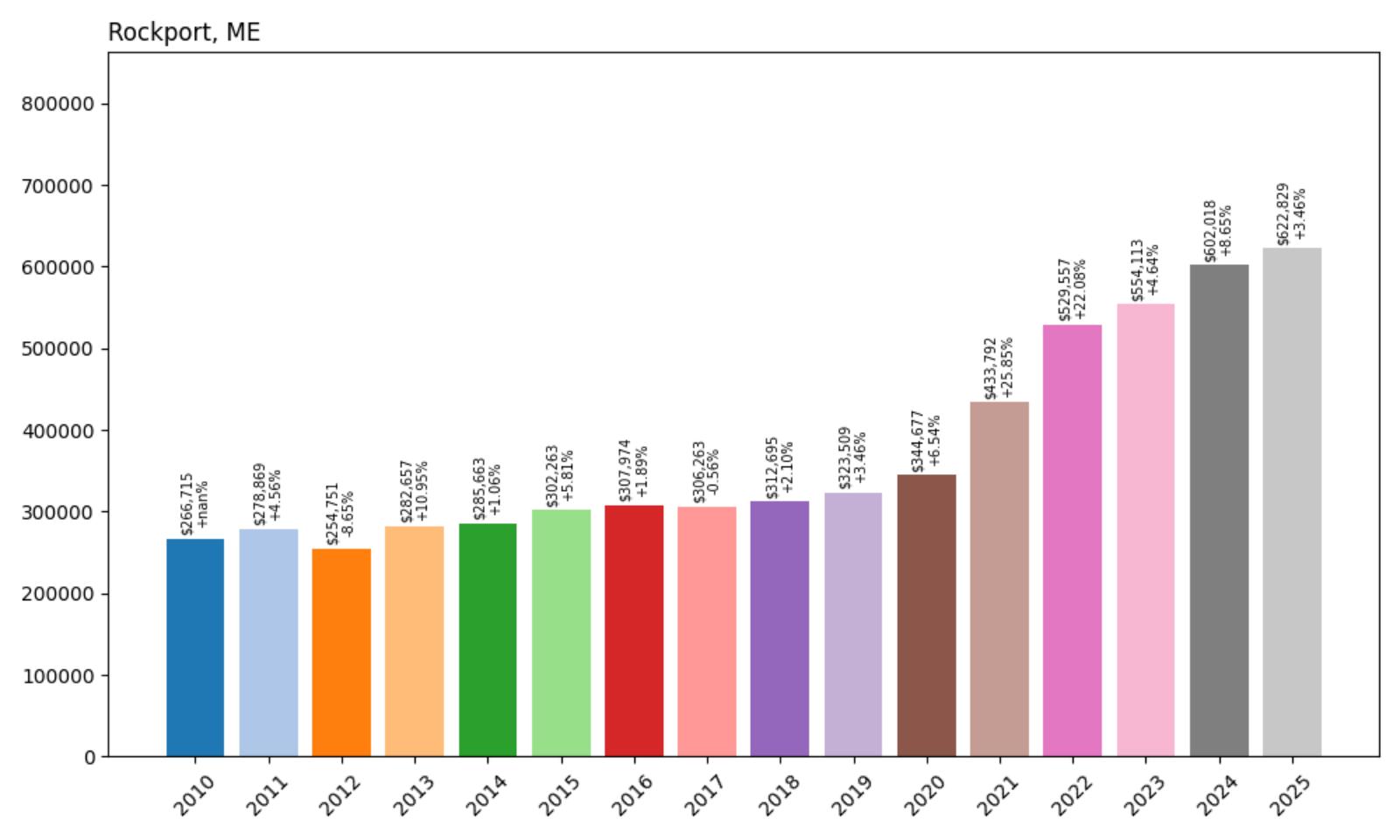
- 2010: $266,715
- 2011: $278,869 (+$12,154, +4.56% from previous year)
- 2012: $254,751 (−$24,119, −8.65% from previous year)
- 2013: $282,657 (+$27,907, +10.95% from previous year)
- 2014: $285,663 (+$3,006, +1.06% from previous year)
- 2015: $302,263 (+$16,600, +5.81% from previous year)
- 2016: $307,974 (+$5,711, +1.89% from previous year)
- 2017: $306,263 (−$1,712, −0.56% from previous year)
- 2018: $312,695 (+$6,432, +2.10% from previous year)
- 2019: $323,509 (+$10,815, +3.46% from previous year)
- 2020: $344,677 (+$21,168, +6.54% from previous year)
- 2021: $433,792 (+$89,115, +25.85% from previous year)
- 2022: $529,557 (+$95,765, +22.08% from previous year)
- 2023: $554,113 (+$24,556, +4.64% from previous year)
- 2024: $602,018 (+$47,905, +8.65% from previous year)
- 2025: $622,829 (+$20,810, +3.46% from previous year)
Rockport’s real estate market showcases the dramatic appreciation experienced by Maine’s midcoast communities, with home values increasing 133% from $266,715 in 2010 to $622,829 in 2025. This Knox County town experienced volatile growth through the 2010s before the pandemic-era acceleration that saw consecutive increases of 26% in 2021 and 22% in 2022. Unlike many Maine markets that have plateaued, Rockport continues showing strong momentum with nearly 9% growth in 2024 and over 3% in 2025, reflecting sustained demand for properties in this picturesque coastal community.
Rockport – Midcoast Arts and Harbor Community
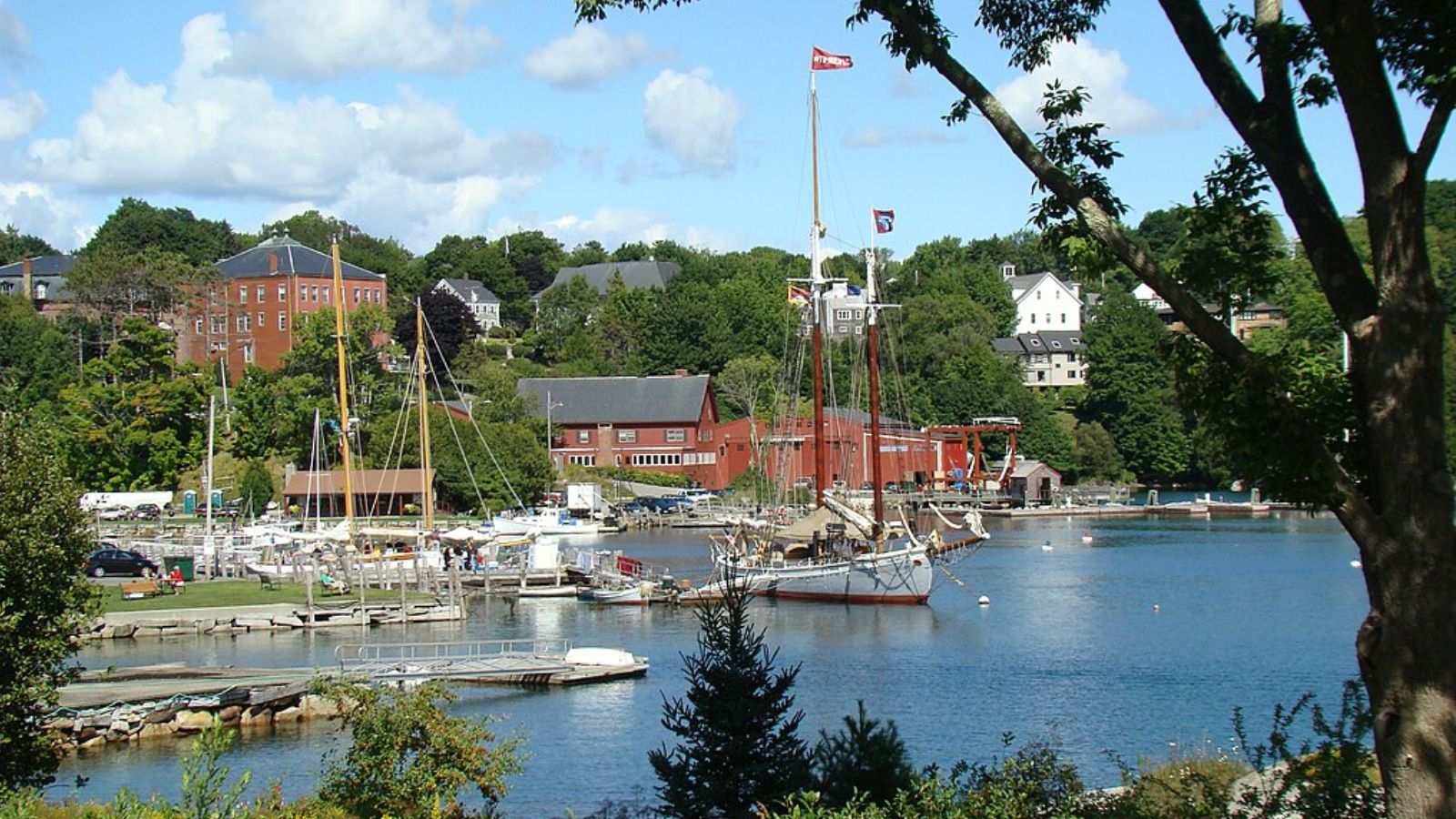
Rockport represents the authentic charm of Maine’s midcoast region, combining working harbor traditions with a thriving arts community and scenic beauty that has attracted visitors and residents for generations. This Knox County town of approximately 3,400 residents offers an ideal blend of maritime heritage, cultural sophistication, and natural beauty, featuring a protected harbor, historic downtown district, and proximity to Camden Hills State Park. The community’s transformation from a 19th-century lime and ice shipping center into a celebrated arts destination reflects its ability to honor its past while embracing contemporary cultural and economic opportunities.
Rockport’s reputation as an artists’ community dates back decades, anchored by institutions like the Center for Maine Contemporary Art (CMCA), Bay Chamber Concerts, and numerous galleries that showcase both established and emerging artists. The town gained national recognition when Forbes magazine named it one of America’s prettiest towns in 2008, highlighting its perfect combination of working waterfront authenticity and cultural sophistication. The community’s scenic harbor, home to the famous Andre the Seal statue and the distinctive Belted Galloway cattle at Aldermere Farm, provides a picturesque backdrop for both residents and the thousands of visitors who come to experience genuine Maine coastal living.
The town’s real estate market reflects its status as a premier midcoast destination where artistic heritage meets exceptional natural beauty. Properties range from historic sea captains’ homes in the village center to contemporary residences with harbor views, all benefiting from Rockport’s unique combination of cultural amenities, recreational opportunities, and working waterfront character. The community’s continued price appreciation demonstrates the sustained demand for authentic Maine coastal living in a town that successfully balances preservation of its maritime traditions with growth as a world-class arts destination.
22. Westport – 75% Home Price Increase Since 2016
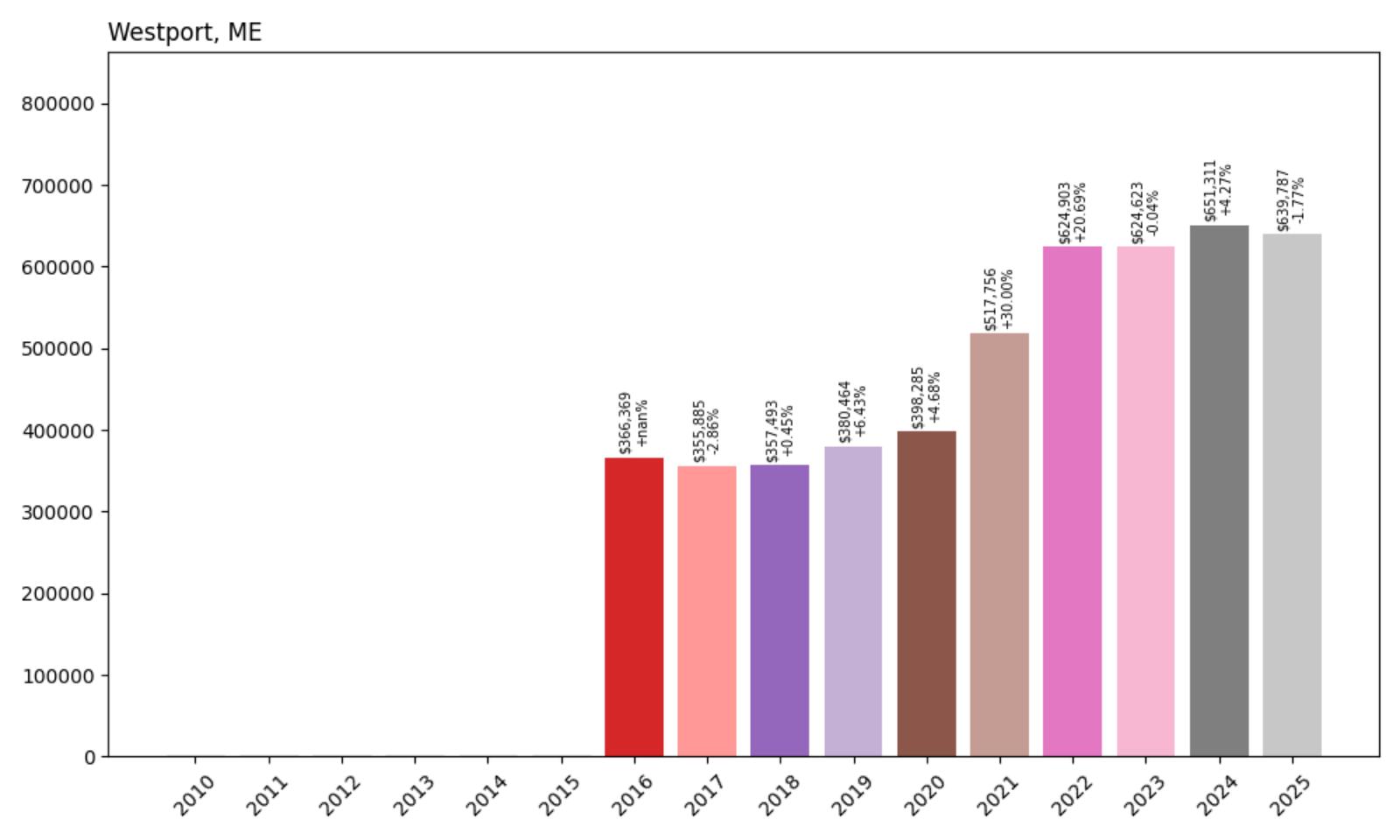
- 2010: N/A
- 2011: N/A
- 2012: N/A
- 2013: N/A
- 2014: N/A
- 2015: N/A
- 2016: $366,369
- 2017: $355,885 (−$10,484, −2.86% from previous year)
- 2018: $357,493 (+$1,608, +0.45% from previous year)
- 2019: $380,464 (+$22,971, +6.43% from previous year)
- 2020: $398,285 (+$17,821, +4.68% from previous year)
- 2021: $517,756 (+$119,471, +30.00% from previous year)
- 2022: $624,903 (+$107,147, +20.69% from previous year)
- 2023: $624,623 (−$280, −0.04% from previous year)
- 2024: $651,311 (+$26,688, +4.27% from previous year)
- 2025: $639,787 (−$11,524, −1.77% from previous year)
Westport has shown solid appreciation since data became available in 2016, with home values climbing from $366,369 to $639,787 in 2025, representing a 75% increase over nine years. After initial volatility in the late 2010s, the island community experienced dramatic pandemic-era growth, with values surging by over $225,000 during 2021 and 2022. The market has been more volatile recently, with modest gains in 2024 followed by a correction in 2025, but values remain well above pre-pandemic levels.
Westport – Island Heritage and Natural Beauty

Westport Island, formerly Westport, is a town in Lincoln County, Maine, originally known as Jeremysquam, a nickname islanders still use . Located on Maine’s mid-coast in Lincoln County in Sheepscot Bay, surrounded by the Sheepscot River to the East and the Back and Sasanoa Rivers to the West, Westport Island is a quiet and picture perfect small Maine community of about 720 year-around residents, which swells to about 1200 in the summer . The island community represents authentic Maine coastal living, where working waterfront traditions blend seamlessly with residential tranquility.
The island is connected to the mainland at the northwest by one modern bridge, built in 1972 over a slim gap in the Back River called Cowsegan Narrows. Originally known as Jeremysquam, Westport Island was incorporated as part of Freetown (now Edgecomb) in 1774, but in 1828, Westport became a separate town after residents desired independence because of the journey necessary to attend town meetings . The community has successfully preserved its maritime heritage while accommodating residential growth, creating an environment where historic buildings like the Squire Tarbox Inn, with sections dating back to 1763, coexist with modern amenities.
Fishing is a principal employer for residents of Westport Island, with fishermen commonly involved in trapping lobster and crabs, while other local employers include Bath Iron Works, a large shipyard where Aegis-class destroyers are built for the US Navy . The substantial price appreciation since 2016 reflects growing recognition of island communities as premium residential markets, where geographic constraints limit supply while authentic Maine character drives demand. With a median household income of $73,594 and strong community volunteer spirit, Westport Island offers an exclusive yet authentic coastal lifestyle that appeals to buyers seeking genuine Maine island living.
21. Long Island – 26% Home Price Increase Since 2020
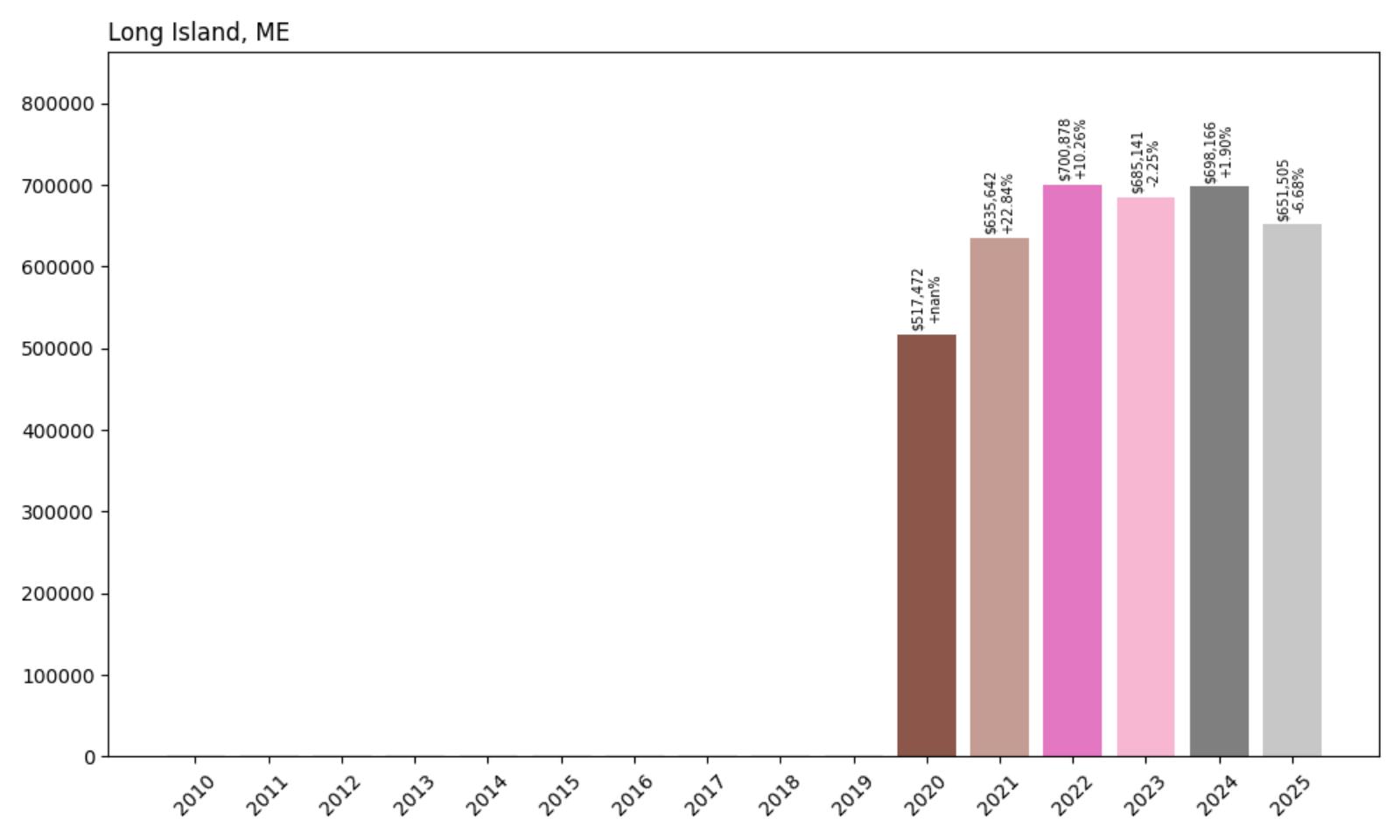
- 2010: N/A
- 2011: N/A
- 2012: N/A
- 2013: N/A
- 2014: N/A
- 2015: N/A
- 2016: N/A
- 2017: N/A
- 2018: N/A
- 2019: N/A
- 2020: $517,472
- 2021: $635,642 (+$118,170, +22.84% from previous year)
- 2022: $700,878 (+$65,236, +10.26% from previous year)
- 2023: $685,141 (−$15,737, −2.25% from previous year)
- 2024: $698,166 (+$13,025, +1.90% from previous year)
- 2025: $651,505 (−$46,662, −6.68% from previous year)
Long Island’s limited data shows strong appreciation followed by recent moderation, with values increasing 26% from $517,472 in 2020 to $651,505 in 2025. This Cumberland County island community experienced significant pandemic-era growth with a 23% increase in 2021 and 10% in 2022, before experiencing adjustments that brought prices back toward more sustainable levels. The community represents one of Maine’s accessible island destinations with regular ferry service from Portland.
Long Island – Independent Island Community

Long Island is a Casco Bay island and town in Cumberland County, Maine, which seceded from the city of Portland in 1993, with a population of 234 at the 2020 census . On July 1, 1993 the Town of Long Island became the first new town in Maine since 1925, after islanders decided that local control was the only way to preserve the year round community when the City of Portland reassessed all property and the tax rate tripled on Long Island . This historic secession created one of Maine’s most unique municipal success stories, where island residents took control of their destiny and created a thriving independent community.
Located six miles and approximately 45 minutes by ferry from Portland, Long Island is roughly three miles long and one mile wide, accessible by Casco Bay Lines ferry service with up to nine boats running daily from 5:00 a.m. until 8:30 p.m. The island is now a vibrant community where citizens take a strong and active role in improving the quality of life for all, with municipal services improved, an excellent school system, and taxes that have gone down by 30% . The community maintains authentic Maine island character while offering modern amenities including a K-5 school, brand new library and art gallery, and state-of-the-art fire and rescue department.
During WWII, Long Island served as a naval fuel annex and torpedo control officers school, with many historic military buildings still standing along the shore . Long Island’s economy is split among several different sectors, with some residents commuting to jobs on the mainland while others work in lobstering, healthcare, education, retail, construction, caretaking, remote positions, or hospitality on the island . The price appreciation since 2020 reflects the growing appeal of authentic island living with modern conveniences, though recent volatility suggests market adjustments as buyers reassess island living costs and lifestyle trade-offs in the post-pandemic era.
20. Chebeague Island – 74% Home Price Increase Since 2020
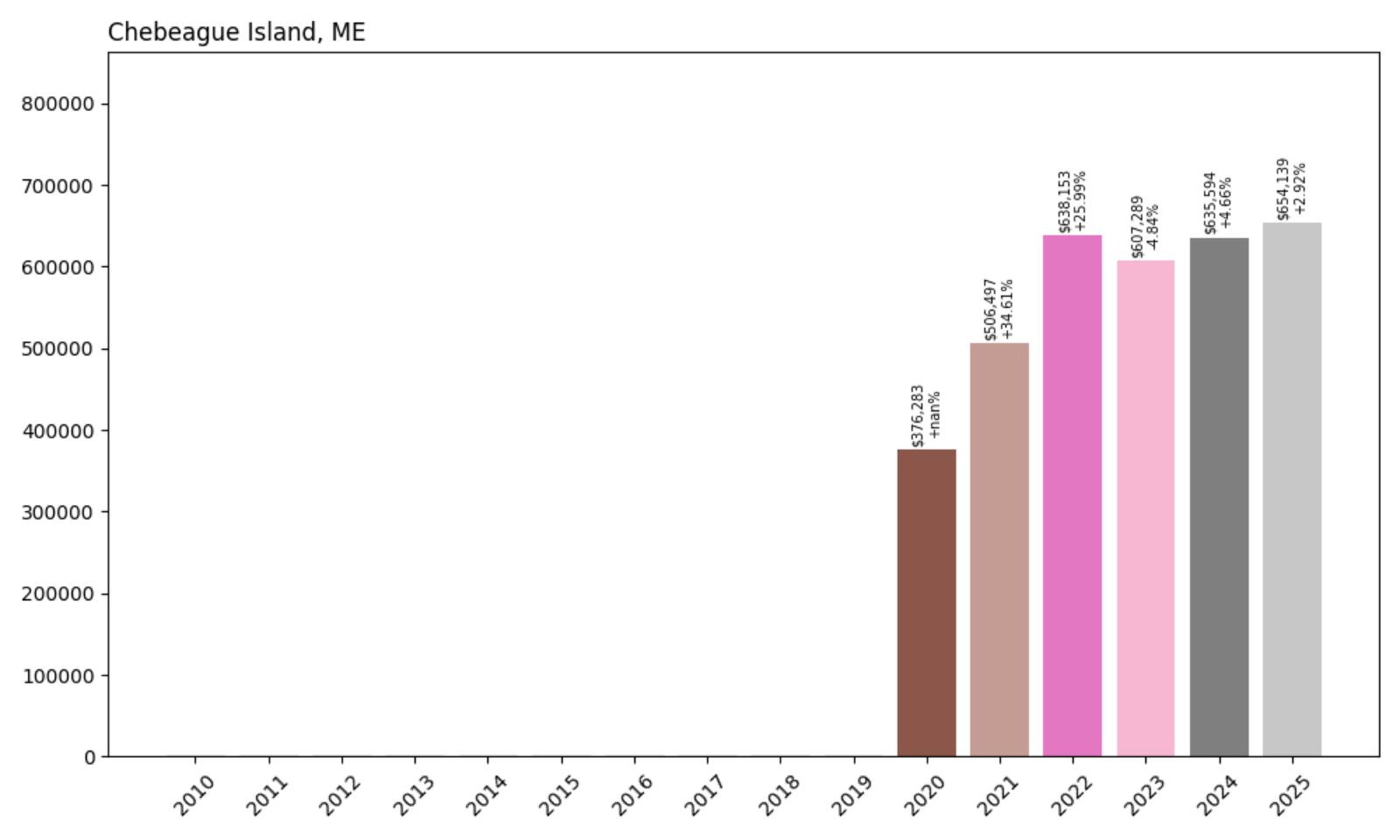
- 2010: N/A
- 2011: N/A
- 2012: N/A
- 2013: N/A
- 2014: N/A
- 2015: N/A
- 2016: N/A
- 2017: N/A
- 2018: N/A
- 2019: N/A
- 2020: $376,283
- 2021: $506,497 (+$130,214, +34.61% from previous year)
- 2022: $638,153 (+$131,657, +25.99% from previous year)
- 2023: $607,289 (−$30,864, −4.84% from previous year)
- 2024: $635,594 (+$28,304, +4.66% from previous year)
- 2025: $654,139 (+$18,546, +2.92% from previous year)
Chebeague Island’s dramatic price surge demonstrates the exceptional appeal of Maine’s accessible island communities, with values increasing 74% from $376,283 in 2020 to $654,139 in 2025. This Cumberland County island experienced remarkable pandemic-era growth with consecutive increases of 35% in 2021 and 26% in 2022, followed by market stabilization and renewed appreciation. The sustained high values reflect the premium buyers place on authentic island living with reliable ferry connections to the mainland.
Chebeague Island – Historic Casco Bay Community

Chebeague Island represents the quintessential Maine island experience, combining year-round community life with summer colony traditions in one of Casco Bay’s most accessible island destinations. This Cumberland County community of approximately 350 year-round residents swells to over 1,500 during summer months, creating a unique dynamic between authentic island culture and seasonal recreation. Originally part of Cumberland until incorporating as its own town in 2007, Chebeague Island maintains traditional Maine island character while benefiting from regular ferry service and proximity to Portland.
Real estate on Chebeague Island ranges from historic sea captains’ homes to contemporary summer cottages, all benefiting from the island’s exceptional natural setting and strong community bonds. The island’s real estate market reflects growing demand for properties that offer both recreational amenities and year-round livability, supported by reliable transportation connections and a thriving local economy based on fishing, tourism, and seasonal services.
19. Bar Harbor – 116% Home Price Increase Since 2010
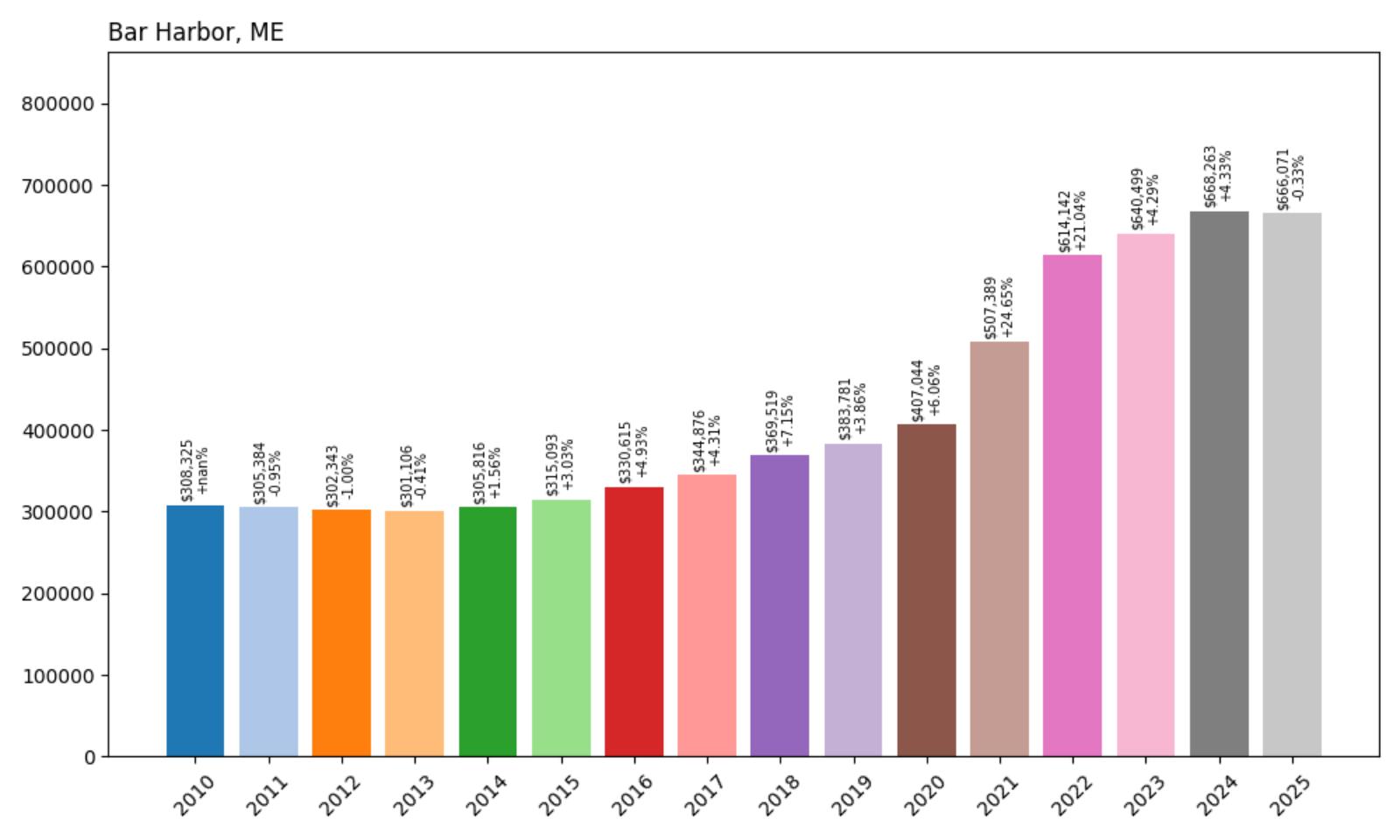
- 2010: $308,325
- 2011: $305,384 (−$2,942, −0.95% from previous year)
- 2012: $302,343 (−$3,041, −1.00% from previous year)
- 2013: $301,106 (−$1,236, −0.41% from previous year)
- 2014: $305,816 (+$4,710, +1.56% from previous year)
- 2015: $315,093 (+$9,277, +3.03% from previous year)
- 2016: $330,615 (+$15,522, +4.93% from previous year)
- 2017: $344,876 (+$14,261, +4.31% from previous year)
- 2018: $369,519 (+$24,643, +7.15% from previous year)
- 2019: $383,781 (+$14,262, +3.86% from previous year)
- 2020: $407,044 (+$23,263, +6.06% from previous year)
- 2021: $507,389 (+$100,345, +24.65% from previous year)
- 2022: $614,142 (+$106,753, +21.04% from previous year)
- 2023: $640,499 (+$26,357, +4.29% from previous year)
- 2024: $668,263 (+$27,764, +4.33% from previous year)
- 2025: $666,071 (−$2,191, −0.33% from previous year)
Bar Harbor’s impressive price appreciation reflects its status as Maine’s premier coastal destination and gateway to Acadia National Park, with home values more than doubling from $308,325 in 2010 to $666,071 in 2025. This Hancock County community experienced modest growth through the 2010s before accelerating dramatically during the pandemic years with increases of 25% in 2021 and 21% in 2022. The market has stabilized at elevated levels, with slight adjustments in 2025 following continued growth, demonstrating sustained demand for properties in this world-renowned destination.
Bar Harbor – Gateway to Acadia National Park

Bar Harbor stands as Maine’s most famous coastal destination, serving as the primary gateway to Acadia National Park and hosting nearly 3.5 million visitors annually. This Hancock County community of approximately 5,100 year-round residents transforms each summer into a bustling resort town that epitomizes Maine’s tourism industry. Located on Mount Desert Island’s northeastern shore, Bar Harbor combines spectacular natural beauty with sophisticated amenities, featuring world-class restaurants, luxury accommodations, and cultural attractions that have attracted wealthy summer visitors since the Gilded Age.
Bar Harbor’s real estate market serves buyers seeking properties in one of America’s most prestigious coastal resort communities, where proximity to Acadia National Park and exceptional recreational amenities command premium prices. The town offers diverse housing options from historic “cottages” built by wealthy industrialists to contemporary homes with ocean views, all benefiting from Bar Harbor’s reputation as a world-class destination. The sustained high property values reflect the community’s unique position as both a working town and an international tourist destination, creating exceptional demand for real estate in this incomparable coastal setting.
18. Camden – 106% Home Price Increase Since 2010
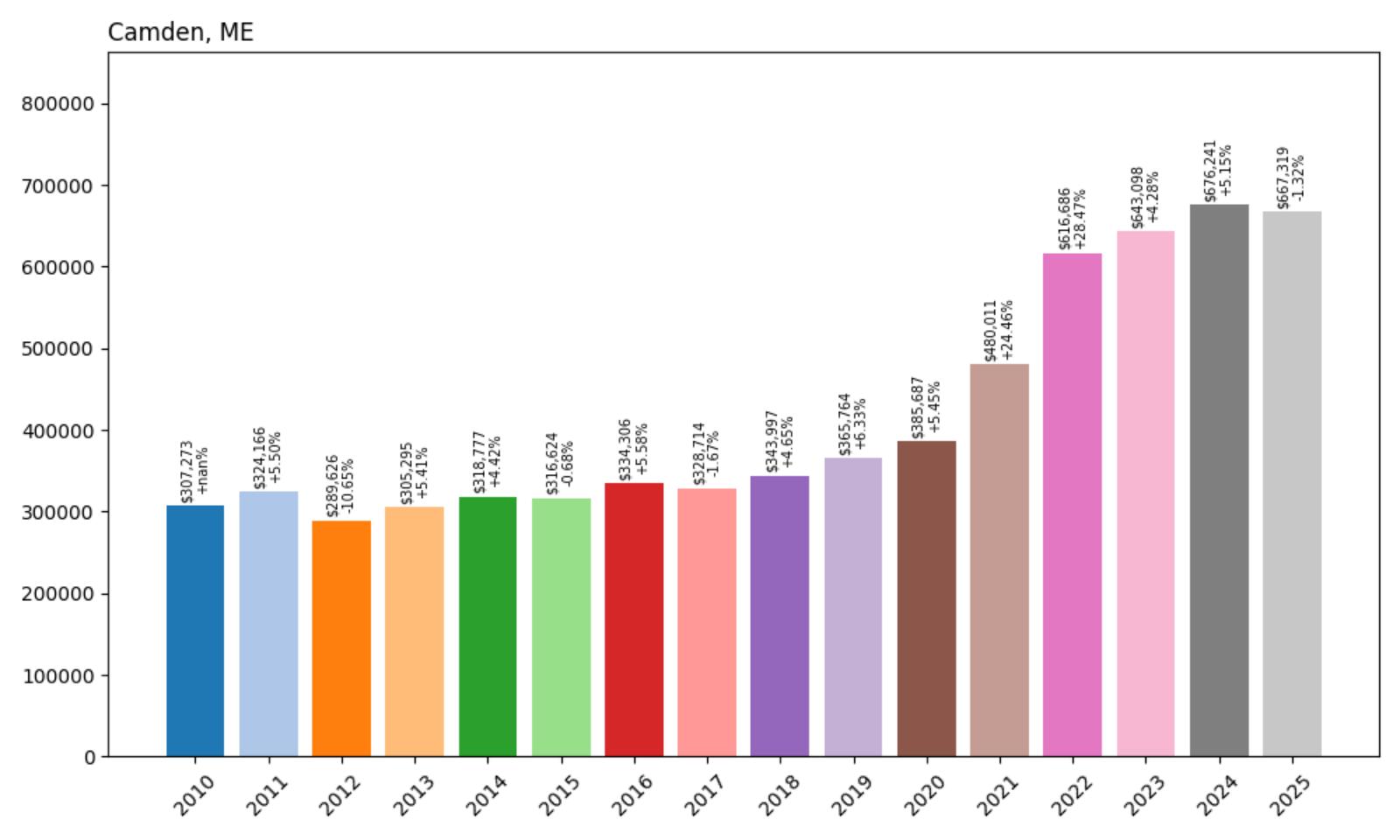
- 2010: $307,273
- 2011: $324,166 (+$16,894, +5.50% from previous year)
- 2012: $289,626 (−$34,540, −10.65% from previous year)
- 2013: $305,295 (+$15,668, +5.41% from previous year)
- 2014: $318,777 (+$13,482, +4.42% from previous year)
- 2015: $316,624 (−$2,152, −0.68% from previous year)
- 2016: $334,306 (+$17,682, +5.58% from previous year)
- 2017: $328,714 (−$5,592, −1.67% from previous year)
- 2018: $343,997 (+$15,283, +4.65% from previous year)
- 2019: $365,764 (+$21,768, +6.33% from previous year)
- 2020: $385,687 (+$19,923, +5.45% from previous year)
- 2021: $480,011 (+$94,324, +24.46% from previous year)
- 2022: $616,686 (+$136,675, +28.47% from previous year)
- 2023: $643,098 (+$26,412, +4.28% from previous year)
- 2024: $676,241 (+$33,143, +5.15% from previous year)
- 2025: $667,319 (−$8,922, −1.32% from previous year)
Camden’s remarkable price growth showcases the enduring appeal of Maine’s most picturesque coastal communities, with home values more than doubling from $307,273 in 2010 to $667,319 in 2025. This Knox County town experienced volatile growth through the 2010s before the dramatic pandemic-era surge that saw extraordinary increases of 24% in 2021 and 28% in 2022. Recent stabilization with slight declines suggests market adjustment at elevated levels, reflecting Camden’s established position as one of Maine’s most desirable coastal destinations.
Camden – Where Mountains Meet the Sea

Camden embodies the quintessential Maine coastal experience with its famous slogan “Where the Mountains Meet the Sea,” offering residents and visitors an unparalleled combination of harbor charm and mountain recreation. This Knox County community of approximately 5,000 residents serves as the jewel of Maine’s midcoast region, featuring a pristine harbor filled with windjammers and luxury yachts, a thriving downtown district, and direct access to Camden Hills State Park’s hiking trails and scenic overlooks. The town’s transformation from a 19th-century industrial center into a world-class resort destination reflects its exceptional natural setting and community commitment to preserving coastal Maine’s authentic character.
Camden’s real estate market reflects its status as one of New England’s most prestigious small coastal communities, where properties command premium prices for their proximity to both harbor activities and mountain recreation. The town offers diverse housing options from historic sea captains’ homes in the village center to contemporary residences with mountain or harbor views, all benefiting from Camden’s reputation for exceptional quality of life. The community’s sustained high property values demonstrate the continued demand for authentic Maine coastal living in a town that successfully balances small-town charm with sophisticated amenities and world-class natural beauty.
17. Kittery – 129% Home Price Increase Since 2015
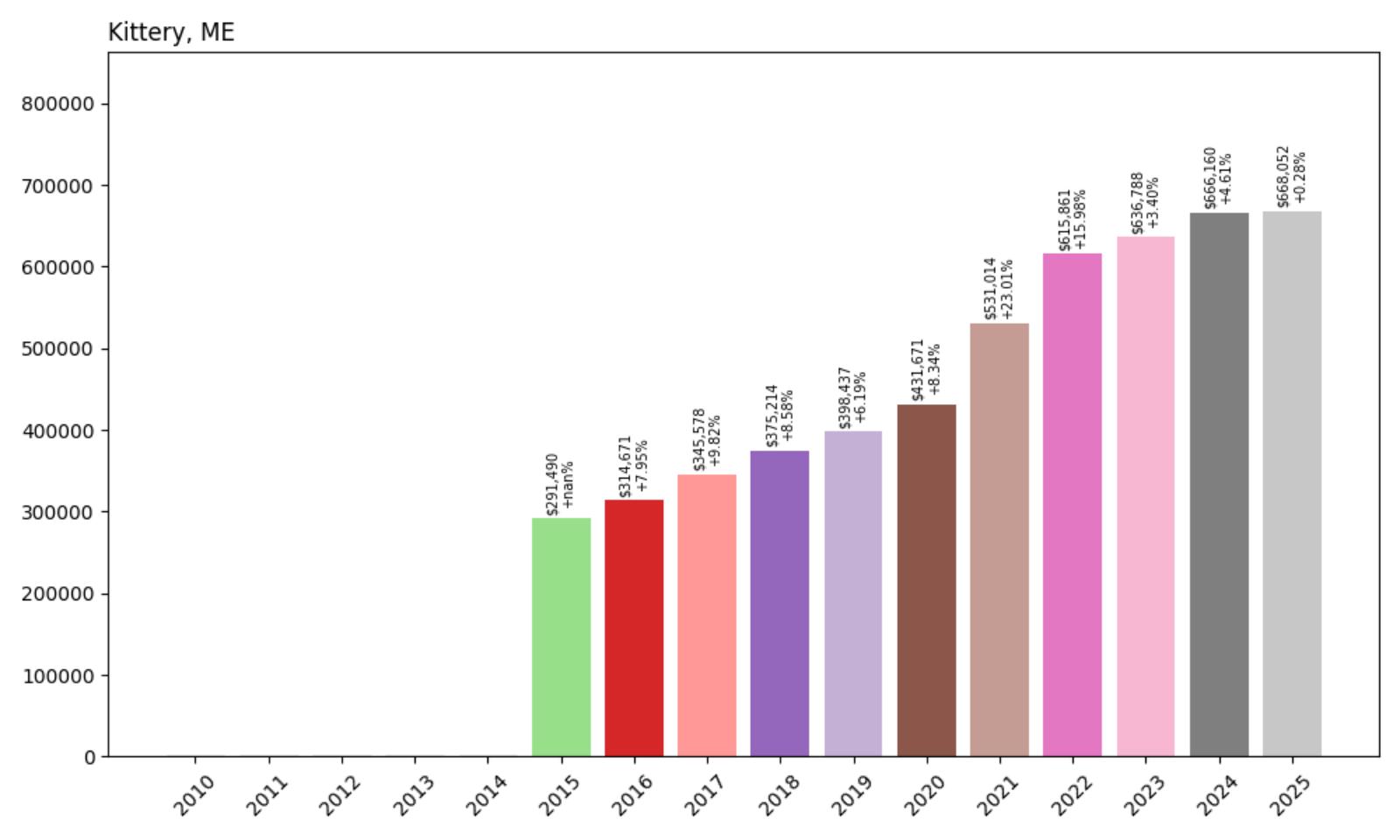
- 2010: N/A
- 2011: N/A
- 2012: N/A
- 2013: N/A
- 2014: N/A
- 2015: $291,490
- 2016: $314,671 (+$23,181, +7.95% from previous year)
- 2017: $345,578 (+$30,907, +9.82% from previous year)
- 2018: $375,214 (+$29,636, +8.58% from previous year)
- 2019: $398,437 (+$23,223, +6.19% from previous year)
- 2020: $431,671 (+$33,234, +8.34% from previous year)
- 2021: $531,014 (+$99,343, +23.01% from previous year)
- 2022: $615,861 (+$84,847, +15.98% from previous year)
- 2023: $636,788 (+$20,928, +3.40% from previous year)
- 2024: $666,160 (+$29,371, +4.61% from previous year)
- 2025: $668,052 (+$1,892, +0.28% from previous year)
Kittery has shown remarkable price appreciation since 2015, with home values climbing from $291,490 to $668,052 in 2025. The town experienced its most dramatic growth during the pandemic years of 2021 and 2022, when values jumped by nearly $185,000 in just two years. The market has stabilized recently, with minimal growth in 2025, but prices remain more than double their 2015 levels.
Kittery – Gateway to Maine’s Luxury Markets

Located at Maine’s southern border with New Hampshire, Kittery serves as the gateway to the Pine Tree State for many visitors and residents. This historic seaport town in York County has transformed from a working naval community into one of southern Maine’s most sought-after residential destinations. The town’s proximity to Portsmouth, New Hampshire, and the greater Boston metropolitan area makes it attractive to commuters seeking Maine’s coastal lifestyle without sacrificing career opportunities.
Kittery’s real estate market reflects its strategic location and growing appeal to affluent buyers. The town offers a blend of historic homes, waterfront properties, and new construction that appeals to diverse buyer preferences. Recent market data shows southern Maine communities like Kittery continue to experience strong demand despite broader market cooling , with buyers drawn to the area’s beaches, historic charm, and excellent dining scene.
The significant price increases since 2015 demonstrate Kittery’s evolution from an affordable alternative to pricier coastal communities into a premium market in its own right. With home values now approaching $700,000, the town has firmly established itself among Maine’s most expensive places to live, though it remains more accessible than neighboring communities like York and Ogunquit.
16. Georgetown – 118% Home Price Increase Since 2012
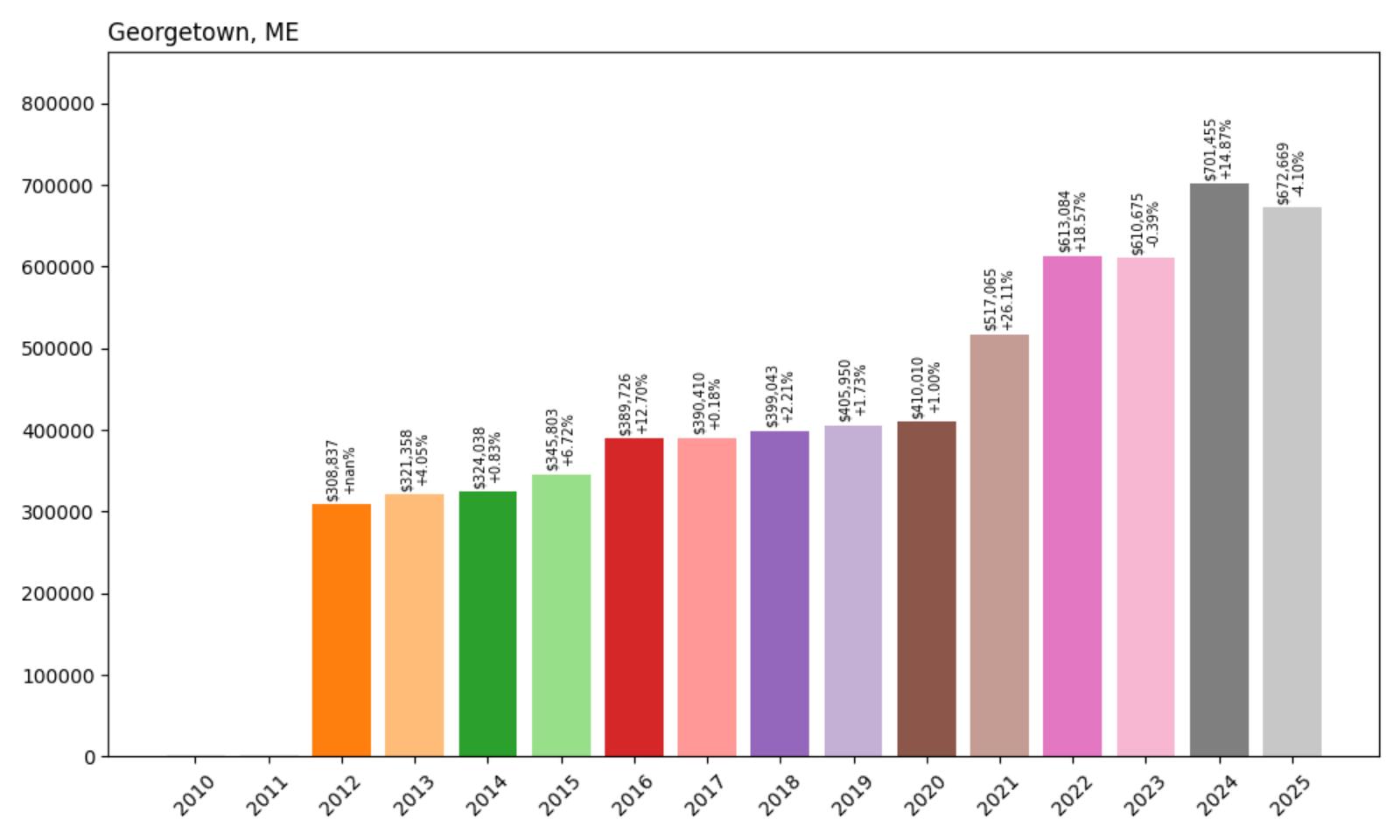
- 2010: N/A
- 2011: N/A
- 2012: $308,837
- 2013: $321,358 (+$12,522, +4.05% from previous year)
- 2014: $324,038 (+$2,680, +0.83% from previous year)
- 2015: $345,803 (+$21,765, +6.72% from previous year)
- 2016: $389,726 (+$43,923, +12.70% from previous year)
- 2017: $390,410 (+$684, +0.18% from previous year)
- 2018: $399,043 (+$8,633, +2.21% from previous year)
- 2019: $405,950 (+$6,907, +1.73% from previous year)
- 2020: $410,010 (+$4,061, +1.00% from previous year)
- 2021: $517,065 (+$107,055, +26.11% from previous year)
- 2022: $613,084 (+$96,018, +18.57% from previous year)
- 2023: $610,675 (−$2,409, −0.39% from previous year)
- 2024: $701,455 (+$90,780, +14.87% from previous year)
- 2025: $672,669 (−$28,786, −4.10% from previous year)
Georgetown has experienced substantial growth since 2012, with home values more than doubling from $308,837 to $672,669 in 2025. The town saw steady but modest appreciation through the 2010s, followed by explosive growth during the pandemic years. A notable surge occurred in 2024 when values jumped nearly $91,000, though 2025 brought a correction with prices declining by over $28,000.
Georgetown – Mid-Coast Island Living

Georgetown occupies a unique position in Maine’s real estate landscape as a true island community connected to the mainland by Route 127. Located in Sagadahoc County on Georgetown Island, this coastal town offers some of the most pristine and secluded living opportunities in the Mid-Coast region. The town’s geography creates natural scarcity in its housing market, with limited developable land and strict zoning regulations preserving its rural character.
The community is renowned for its working waterfront, lobstering tradition, and spectacular rocky coastline. Reid State Park, one of Maine’s most popular beaches, anchors the island’s southern tip and draws visitors year-round. This combination of natural beauty and recreational amenities has made Georgetown increasingly attractive to affluent buyers seeking authentic Maine coastal living away from the crowds of more developed resort areas.
Georgetown’s housing market reflects the broader trend of island and peninsula communities becoming premium destinations. The dramatic price increases since 2012, particularly the pandemic-era surge, demonstrate how buyers have increasingly valued isolation, natural beauty, and authentic Maine character. Despite the recent price correction in 2025, values remain more than double their 2012 levels, cementing Georgetown’s status as one of Maine’s most exclusive residential communities.
15. Freeport – 140% Home Price Increase Since 2012
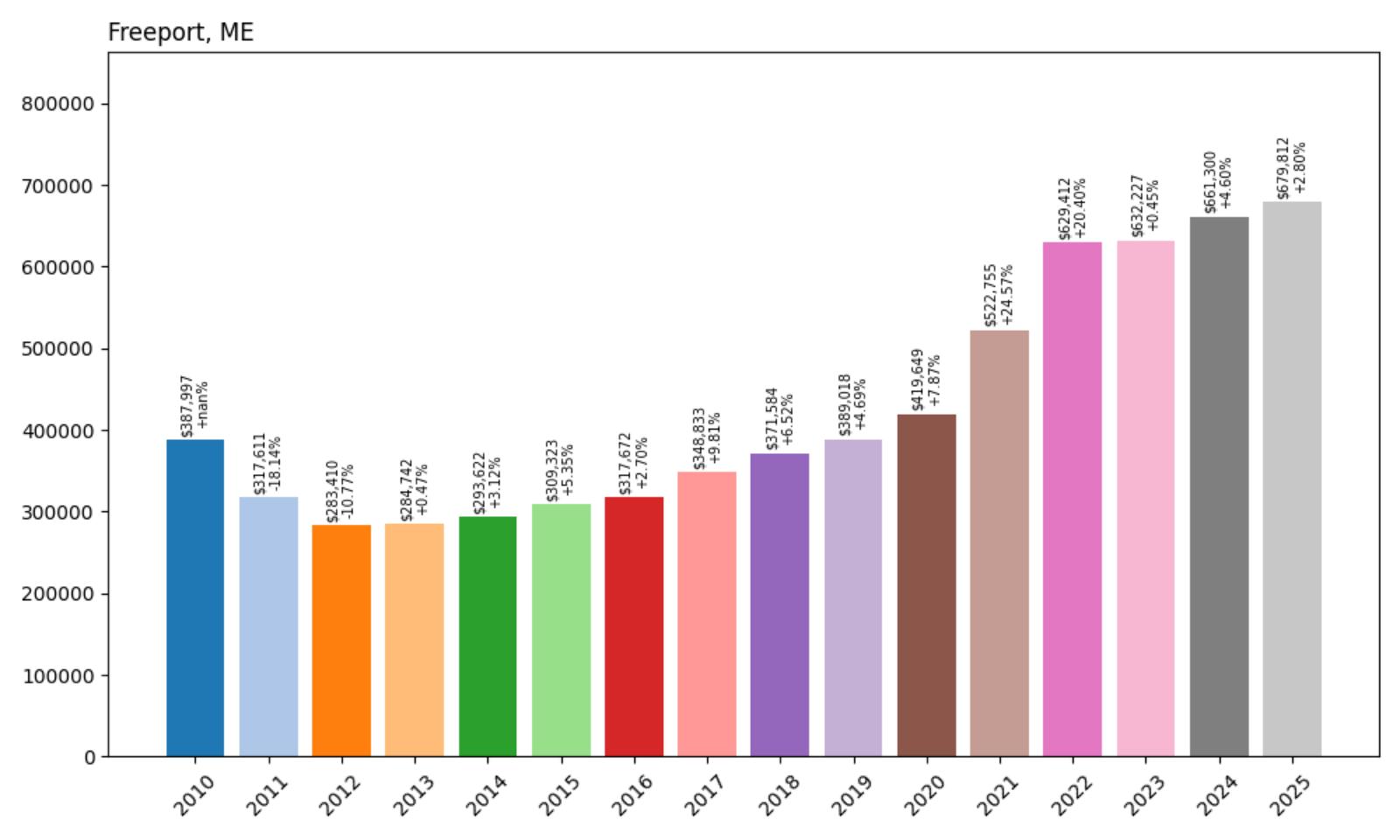
- 2010: $387,997
- 2011: $317,611 (−$70,386, −18.14% from previous year)
- 2012: $283,410 (−$34,201, −10.77% from previous year)
- 2013: $284,742 (+$1,332, +0.47% from previous year)
- 2014: $293,622 (+$8,880, +3.12% from previous year)
- 2015: $309,323 (+$15,701, +5.35% from previous year)
- 2016: $317,672 (+$8,349, +2.70% from previous year)
- 2017: $348,833 (+$31,161, +9.81% from previous year)
- 2018: $371,584 (+$22,751, +6.52% from previous year)
- 2019: $389,018 (+$17,434, +4.69% from previous year)
- 2020: $419,649 (+$30,631, +7.87% from previous year)
- 2021: $522,755 (+$103,106, +24.57% from previous year)
- 2022: $629,412 (+$106,657, +20.40% from previous year)
- 2023: $632,227 (+$2,815, +0.45% from previous year)
- 2024: $661,300 (+$29,074, +4.60% from previous year)
- 2025: $679,812 (+$18,512, +2.80% from previous year)
Freeport’s housing market tells a story of recovery and remarkable growth since hitting bottom in 2012 at $283,410. After several years of decline following the 2008 financial crisis, home values have surged to $679,812 by 2025, representing a 140% increase from the 2012 low. The most dramatic growth occurred during 2021 and 2022, when values jumped by over $200,000 in just two years, though growth has moderated since then.
Freeport – Retail Fame Meets Residential Appeal

Freeport is famous as the home of L.L. Bean, which has its headquarters on Casco Street and has had a presence in the town since it began in 1912 . This Cumberland County town has leveraged its retail prominence to become one of Maine’s most recognizable destinations, attracting millions of visitors annually to its outlet stores and flagship L.L. Bean campus. However, beyond its shopping reputation, Freeport has evolved into a highly desirable residential community for families seeking access to the Portland metropolitan area.
The community is seen as a widely livable town for families who want access to the Portland metropolitan area while maintaining a distinctly Maine character . Freeport’s location just 20 minutes north of Portland provides residents with easy access to urban amenities while enjoying a more relaxed coastal lifestyle. The town offers excellent schools, recreational opportunities, and a walkable downtown district that extends beyond retail to include restaurants, cultural venues, and community gathering spaces.
The substantial price recovery since 2012 reflects Freeport’s transformation from a recession-impacted market to one of Cumberland County’s most sought-after communities. The town’s Desert of Maine tourist attraction, combined with its retail scene and family-friendly reputation, continues to drive demand . With home values now approaching $680,000, Freeport represents the broader trend of greater Portland suburban communities becoming premium residential markets in their own right.
14. North Yarmouth – 124% Home Price Increase Since 2012
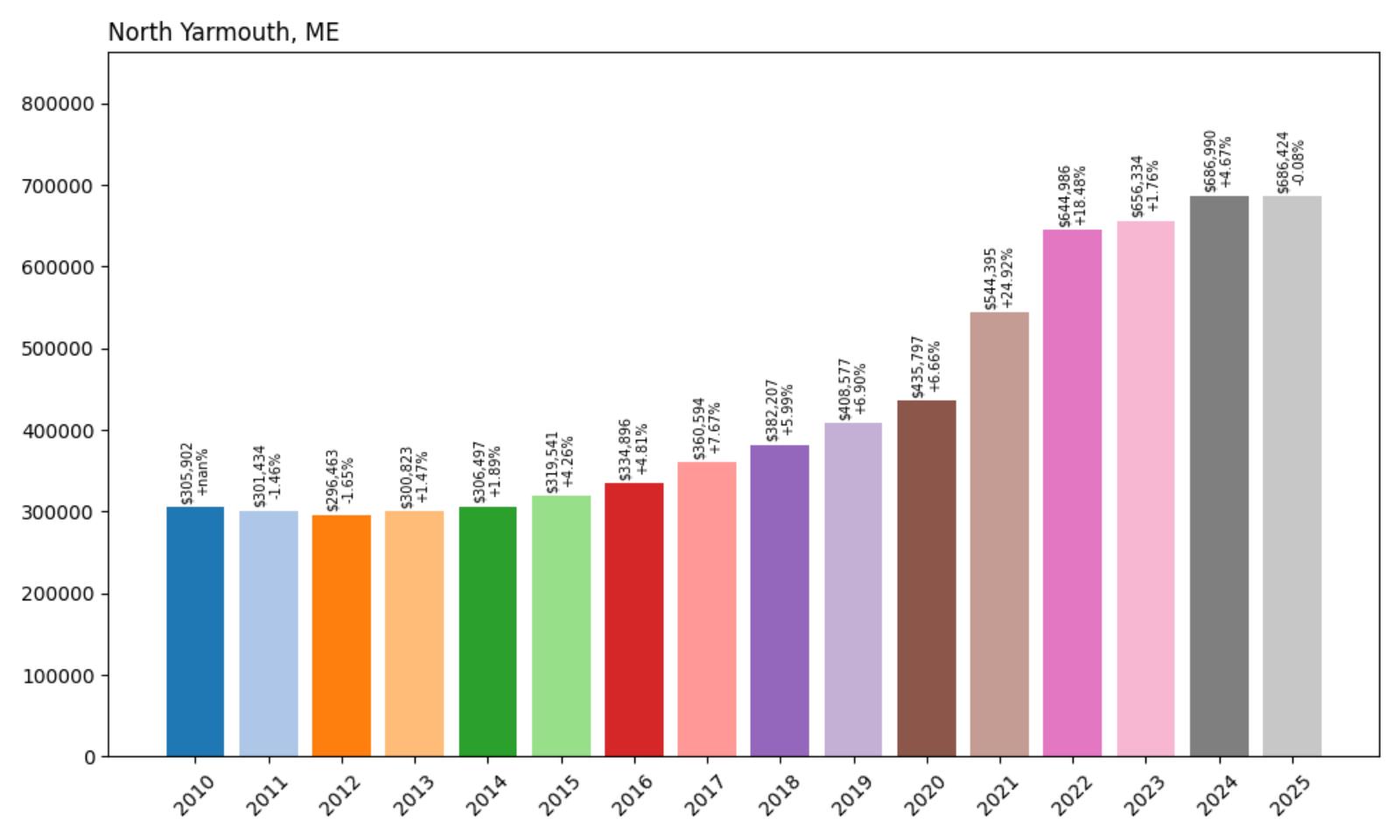
- 2010: $305,902
- 2011: $301,434 (−$4,468, −1.46% from previous year)
- 2012: $296,463 (−$4,971, −1.65% from previous year)
- 2013: $300,823 (+$4,360, +1.47% from previous year)
- 2014: $306,497 (+$5,674, +1.89% from previous year)
- 2015: $319,541 (+$13,044, +4.26% from previous year)
- 2016: $334,896 (+$15,355, +4.81% from previous year)
- 2017: $360,594 (+$25,698, +7.67% from previous year)
- 2018: $382,207 (+$21,613, +5.99% from previous year)
- 2019: $408,577 (+$26,370, +6.90% from previous year)
- 2020: $435,797 (+$27,220, +6.66% from previous year)
- 2021: $544,395 (+$108,598, +24.92% from previous year)
- 2022: $644,986 (+$100,591, +18.48% from previous year)
- 2023: $656,334 (+$11,348, +1.76% from previous year)
- 2024: $686,990 (+$30,657, +4.67% from previous year)
- 2025: $686,424 (−$567, −0.08% from previous year)
North Yarmouth has demonstrated consistent upward momentum since reaching its low point in 2012 at $296,463. Home values have more than doubled to $686,424 by 2025, showing steady appreciation throughout the 2010s that accelerated dramatically during the pandemic years. The town experienced particularly strong growth in 2021 and 2022, gaining over $200,000 in value during those two years alone, with prices stabilizing near current levels since 2024.
North Yarmouth – Rural Charm Near Urban Amenities

North Yarmouth represents the ideal balance between rural tranquility and metropolitan accessibility that has become increasingly coveted in Maine’s housing market. Located in Cumberland County, this community of fewer than 4,000 residents offers a more affordable alternative to neighboring Yarmouth while maintaining easy access to Portland and Freeport. The town’s rural character, featuring rolling hills, farms, and forested areas, appeals to buyers seeking space and privacy without complete isolation.
The community has successfully preserved its agricultural heritage while accommodating residential growth, creating a planning model that many Maine towns attempt to emulate. North Yarmouth’s zoning policies have maintained large lot sizes and rural aesthetics, contributing to the exclusivity that drives property values higher. The town offers residents access to excellent schools through regional partnerships and recreational opportunities including hiking trails, conservation lands, and seasonal activities.
The remarkable price appreciation since 2012 reflects broader trends in Greater Portland’s suburban markets, where buyers have increasingly sought alternatives to higher-priced coastal communities. North Yarmouth’s housing market benefits from its location between two major employment centers – Portland to the south and Brunswick to the north – making it attractive to commuters. With home values now approaching $700,000, the town has transitioned from an affordable rural option to one of Cumberland County’s more expensive residential markets.
13. Scarborough – 126% Home Price Increase Since 2010
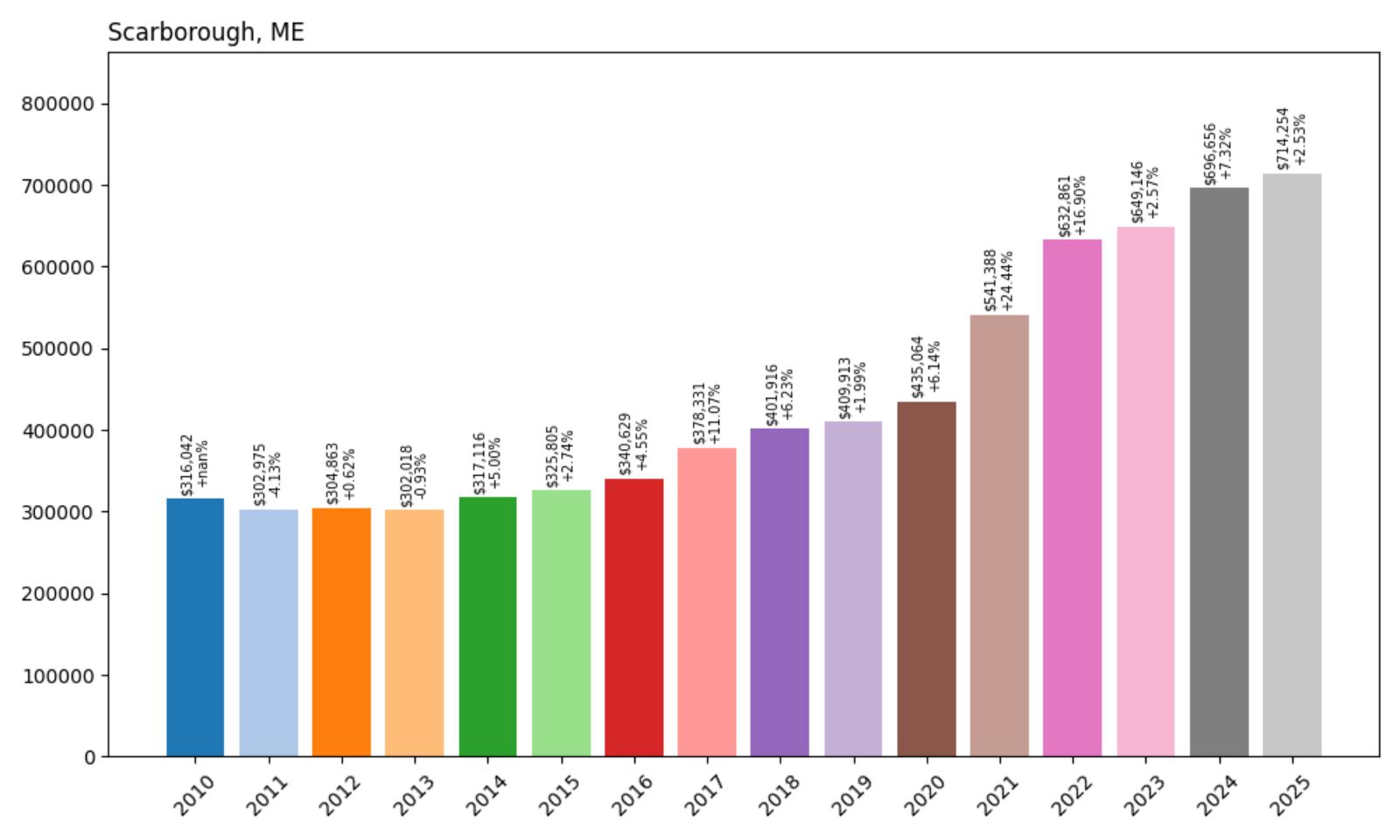
- 2010: $316,042
- 2011: $302,975 (−$13,067, −4.13% from previous year)
- 2012: $304,863 (+$1,888, +0.62% from previous year)
- 2013: $302,018 (−$2,845, −0.93% from previous year)
- 2014: $317,116 (+$15,098, +5.00% from previous year)
- 2015: $325,805 (+$8,689, +2.74% from previous year)
- 2016: $340,629 (+$14,824, +4.55% from previous year)
- 2017: $378,331 (+$37,701, +11.07% from previous year)
- 2018: $401,916 (+$23,585, +6.23% from previous year)
- 2019: $409,913 (+$7,997, +1.99% from previous year)
- 2020: $435,064 (+$25,151, +6.14% from previous year)
- 2021: $541,388 (+$106,324, +24.44% from previous year)
- 2022: $632,861 (+$91,473, +16.90% from previous year)
- 2023: $649,146 (+$16,285, +2.57% from previous year)
- 2024: $696,656 (+$47,511, +7.32% from previous year)
- 2025: $714,254 (+$17,598, +2.53% from previous year)
Scarborough has shown impressive long-term growth, with home values more than doubling from $316,042 in 2010 to $714,254 in 2025. The town experienced a slow recovery through the mid-2010s, followed by accelerating growth that peaked during the pandemic years. The market saw its largest single-year jump in 2021 with over $106,000 in gains, and strong appreciation has continued through 2025, making it one of the few communities still posting solid year-over-year increases.
Scarborough – Suburban Growth and Beach Access

Scarborough has emerged as one of Greater Portland’s most successful suburban communities, combining accessibility to urban amenities with coveted beach access and family-friendly neighborhoods. Located in Cumberland County just south of Portland, this town of over 20,000 residents represents the largest community on Maine’s expensive housing list. Scarborough’s appeal stems from its diverse housing stock, excellent schools, and prime location that provides easy access to both Portland’s job market and southern Maine’s recreational opportunities.
Post-2020, Scarborough saw a spike in interest from both in-state movers and out-of-state buyers, driving home values upward each year and cementing its place as one of the most expensive and competitive housing markets in southern Maine . The town offers something for every buyer preference, from historic homes in the village center to new construction in planned developments, waterfront properties along the Scarborough River, and beachfront homes near Scarborough Beach and Pine Point.
The consistent price appreciation reflects Scarborough’s success in managing growth while maintaining quality of life. The town has invested heavily in infrastructure, schools, and recreational facilities, creating a comprehensive suburban environment that justifies premium housing costs. With the recent completion of major development projects and continued in-migration from other New England states, Scarborough’s housing market shows no signs of cooling, positioning it as one of Maine’s most resilient luxury residential markets.
12. Harpswell – 98% Home Price Increase Since 2010
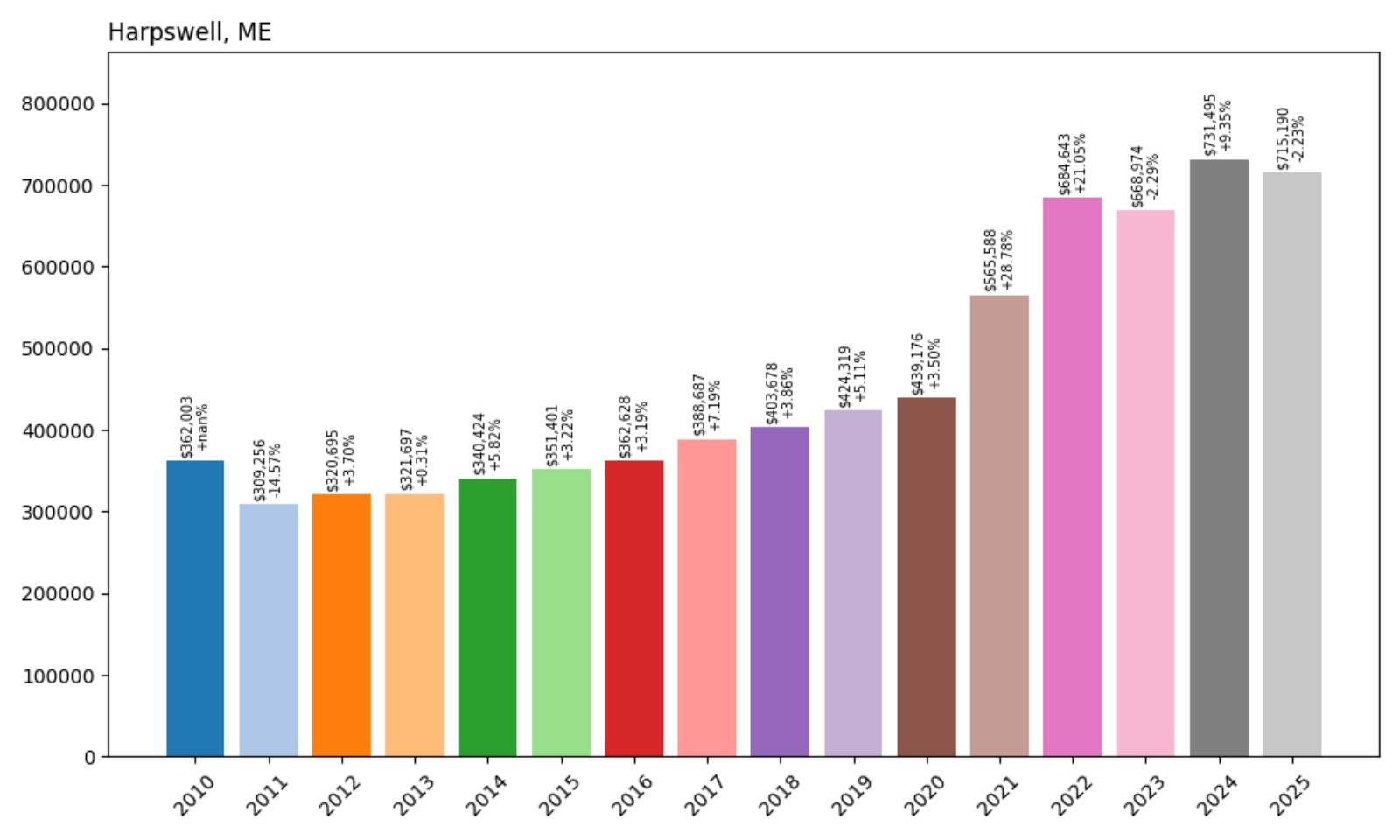
- 2010: $362,003
- 2011: $309,256 (−$52,748, −14.57% from previous year)
- 2012: $320,695 (+$11,440, +3.70% from previous year)
- 2013: $321,697 (+$1,002, +0.31% from previous year)
- 2014: $340,424 (+$18,726, +5.82% from previous year)
- 2015: $351,401 (+$10,977, +3.22% from previous year)
- 2016: $362,628 (+$11,227, +3.19% from previous year)
- 2017: $388,687 (+$26,060, +7.19% from previous year)
- 2018: $403,678 (+$14,990, +3.86% from previous year)
- 2019: $424,319 (+$20,641, +5.11% from previous year)
- 2020: $439,176 (+$14,856, +3.50% from previous year)
- 2021: $565,588 (+$126,413, +28.78% from previous year)
- 2022: $684,643 (+$119,054, +21.05% from previous year)
- 2023: $668,974 (−$15,669, −2.29% from previous year)
- 2024: $731,495 (+$62,521, +9.35% from previous year)
- 2025: $715,190 (−$16,305, −2.23% from previous year)
Harpswell’s housing market has nearly doubled in value since 2010, rising from $362,003 to $715,190 in 2025 despite some recent volatility. After a sharp decline in 2011, the town experienced steady but modest growth through 2020, followed by explosive pandemic-era increases totaling nearly $250,000 over two years. The market has fluctuated since 2022, with a notable surge in 2024 followed by a correction in 2025, but values remain well above pre-pandemic levels.
Harpswell – Peninsula Living at Its Finest

Harpswell is known for its dramatic peninsulas and waterfront views, stretching across dozens of miles of coastline in Cumberland County . This unique geography creates one of Maine’s most distinctive residential markets, where nearly every property offers some degree of water access or ocean views. The town encompasses multiple peninsulas and islands connected by bridges and causeways, creating intimate neighborhoods with strong maritime character and exceptional natural beauty.
The community offers a rural coastal lifestyle that’s still relatively accessible from Brunswick and Portland, with many homes perched along rocky coves and private inlets . Harpswell’s real estate market benefits from its authentic working waterfront culture, where lobster boats and pleasure craft share the same harbors. The town has successfully balanced residential development with preservation of its fishing industry, creating a unique environment that appeals to buyers seeking genuine Maine coastal living.
The market saw huge jumps during the pandemic, driven by out-of-state demand and limited inventory, with the town’s unique geography being a key driver of long-term value appreciation . Harpswell’s limited developable land, combined with strong environmental protections and community resistance to overdevelopment, ensures continued scarcity in its housing market. Despite recent price fluctuations, the town’s peninsula geography and authentic maritime character position it as one of Maine’s most exclusive coastal residential markets.
11. North Haven – Decline of 1.25% Since 2024
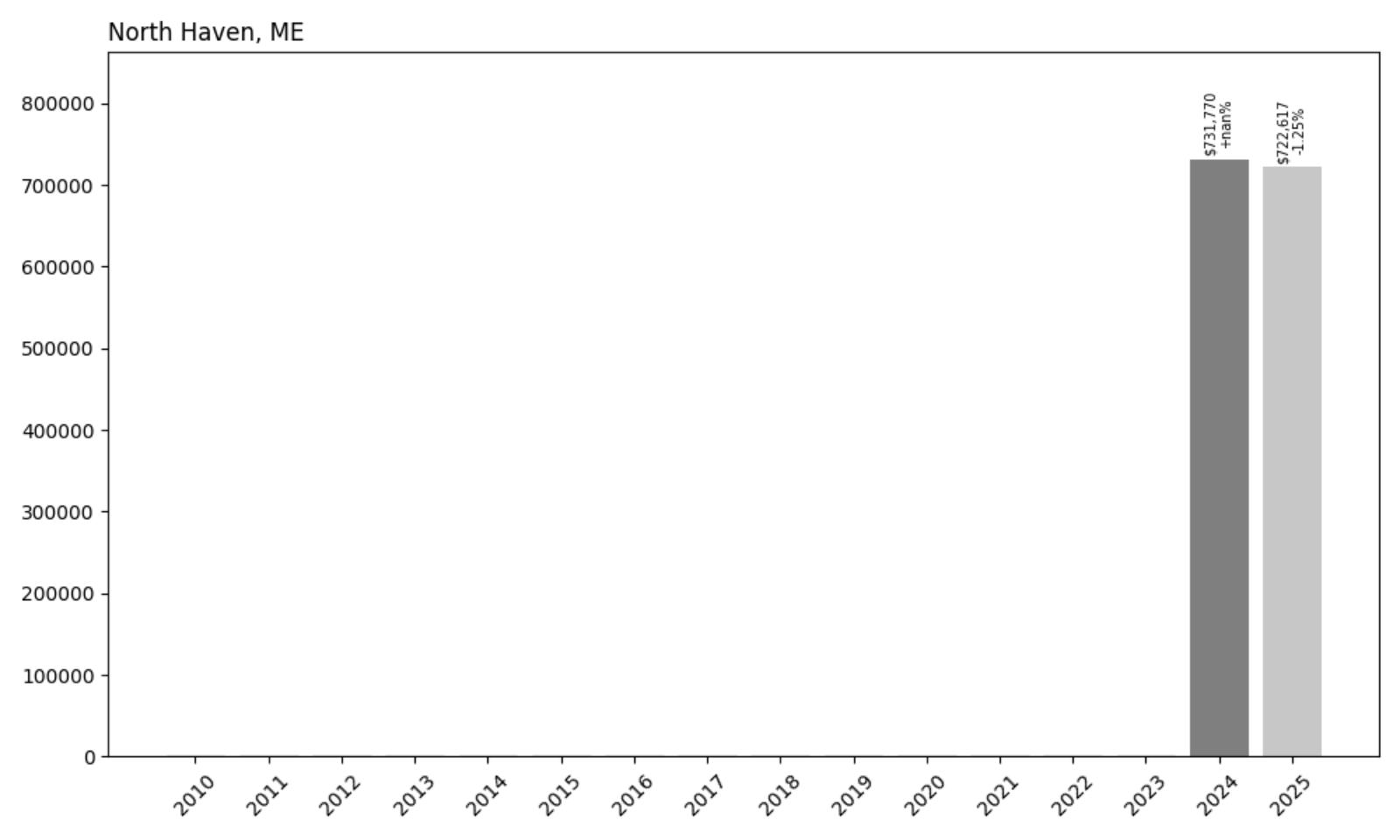
- 2010: N/A
- 2011: N/A
- 2012: N/A
- 2013: N/A
- 2014: N/A
- 2015: N/A
- 2016: N/A
- 2017: N/A
- 2018: N/A
- 2019: N/A
- 2020: N/A
- 2021: N/A
- 2022: N/A
- 2023: N/A
- 2024: $731,770
- 2025: $722,617 (−$9,153, −1.25% from previous year)
North Haven presents limited data, with information only available for 2024 and 2025. The island community shows a slight decline of $9,153 between these years, representing a 1.25% decrease. Despite this recent drop, the current median home value of $722,617 places North Haven among Maine’s most expensive residential markets, reflecting the premium that island living commands in Penobscot Bay.
North Haven – Island Exclusivity in Penobscot Bay

North Haven represents the pinnacle of Maine island living, accessible only by ferry or private boat from Rockland. This Knox County island community of fewer than 400 year-round residents transforms into a summer haven for affluent families who have maintained compounds here for generations. The island’s isolation creates a naturally exclusive housing market where properties rarely change hands and when they do, command premium prices reflecting both scarcity and desirability.
While the slight decline in 2025 may reflect broader market corrections or limited transaction volume typical of island markets, North Haven’s long-term value proposition remains strong. The combination of natural scarcity, generational ownership patterns, and continued demand from affluent families seeking authentic Maine island experiences ensures North Haven will remain one of the state’s most exclusive and expensive residential markets. Properties here often represent multi-generational investments rather than typical real estate transactions.
10. Cumberland – 119% Home Price Increase Since 2010
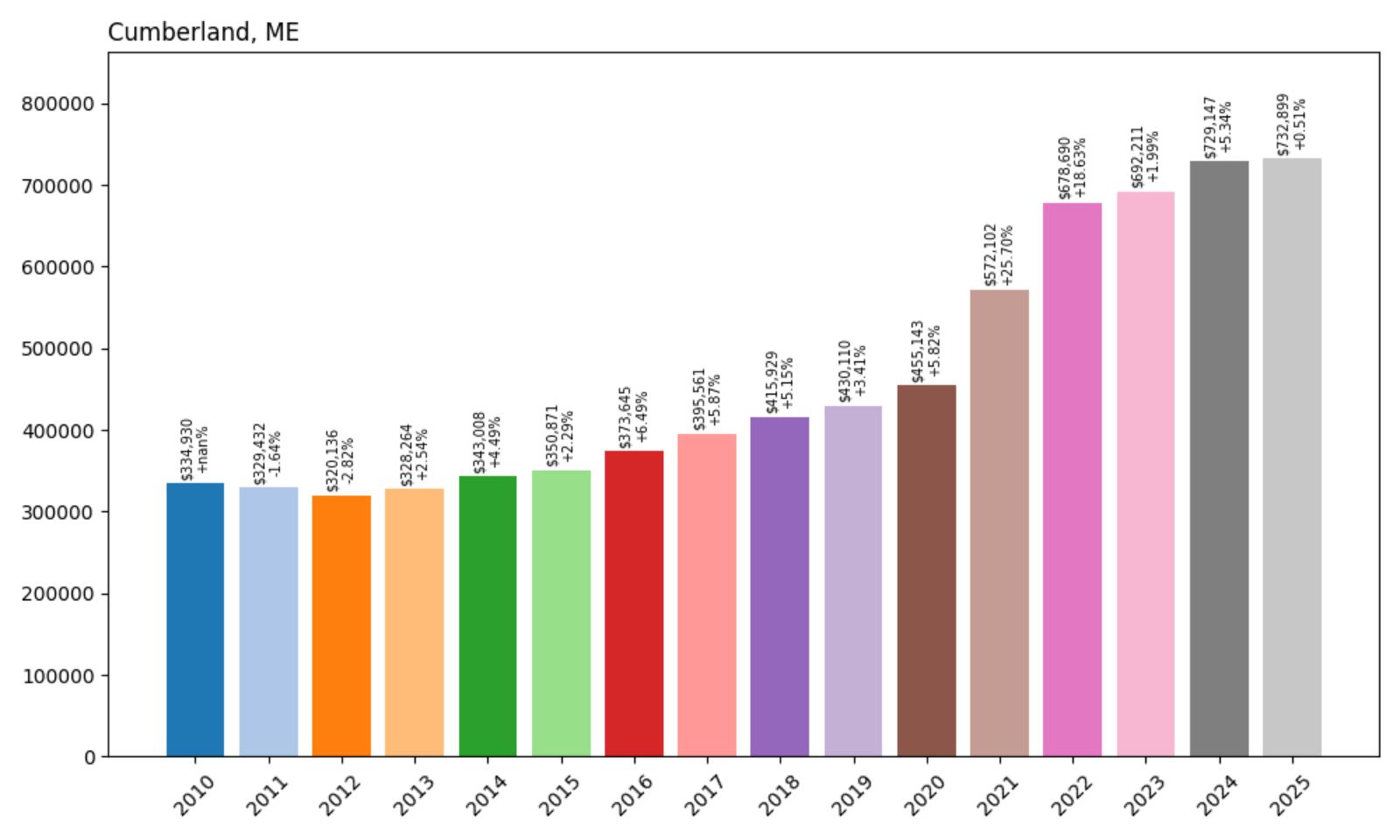
- 2010: $334,930
- 2011: $329,432 (−$5,498, −1.64% from previous year)
- 2012: $320,136 (−$9,296, −2.82% from previous year)
- 2013: $328,264 (+$8,128, +2.54% from previous year)
- 2014: $343,008 (+$14,743, +4.49% from previous year)
- 2015: $350,871 (+$7,863, +2.29% from previous year)
- 2016: $373,645 (+$22,775, +6.49% from previous year)
- 2017: $395,561 (+$21,916, +5.87% from previous year)
- 2018: $415,929 (+$20,368, +5.15% from previous year)
- 2019: $430,110 (+$14,181, +3.41% from previous year)
- 2020: $455,143 (+$25,033, +5.82% from previous year)
- 2021: $572,102 (+$116,959, +25.70% from previous year)
- 2022: $678,690 (+$106,588, +18.63% from previous year)
- 2023: $692,211 (+$13,520, +1.99% from previous year)
- 2024: $729,147 (+$36,936, +5.34% from previous year)
- 2025: $732,899 (+$3,753, +0.51% from previous year)
Cumberland has demonstrated remarkable consistency in its housing market growth, with values more than doubling from $334,930 in 2010 to $732,899 in 2025. The town experienced steady appreciation throughout the 2010s, followed by explosive pandemic-era growth that added over $220,000 in value during 2021 and 2022. Growth has moderated significantly since then, but continued appreciation through 2025 shows the market’s underlying strength and continued demand.
Cumberland – Affluent Suburban Living

Cumberland is a coastal town between Portland and Freeport that is also one of Maine’s wealthiest, with a median household income in 2020 of nearly $116,000 . This Cumberland County community has established itself as one of the most desirable suburban markets in Greater Portland, combining rural character with sophisticated amenities and excellent schools. The town’s strategic location provides residents with easy access to employment centers while maintaining the peaceful, upscale atmosphere that justifies premium housing costs.
Residents who live there can enjoy access to the water as well as the Cumberland Fair, celebrating its 150th iteration this September . The town successfully balances residential development with agricultural preservation, maintaining working farms alongside executive housing developments. Cumberland’s commitment to open space preservation and thoughtful planning has created an environment where natural beauty and upscale living coexist harmoniously, appealing to affluent families seeking the best of both worlds.
The steady price appreciation reflects Cumberland’s success in maintaining its exclusive character while accommodating controlled growth. The town’s housing market benefits from strong local governance, excellent municipal services, and a reputation for fiscal responsibility that attracts long-term residents. With home values now exceeding $730,000, Cumberland represents the premium suburban lifestyle that has become increasingly sought-after in Maine’s post-pandemic real estate environment.
9. Yarmouth – 127% Home Price Increase Since 2010
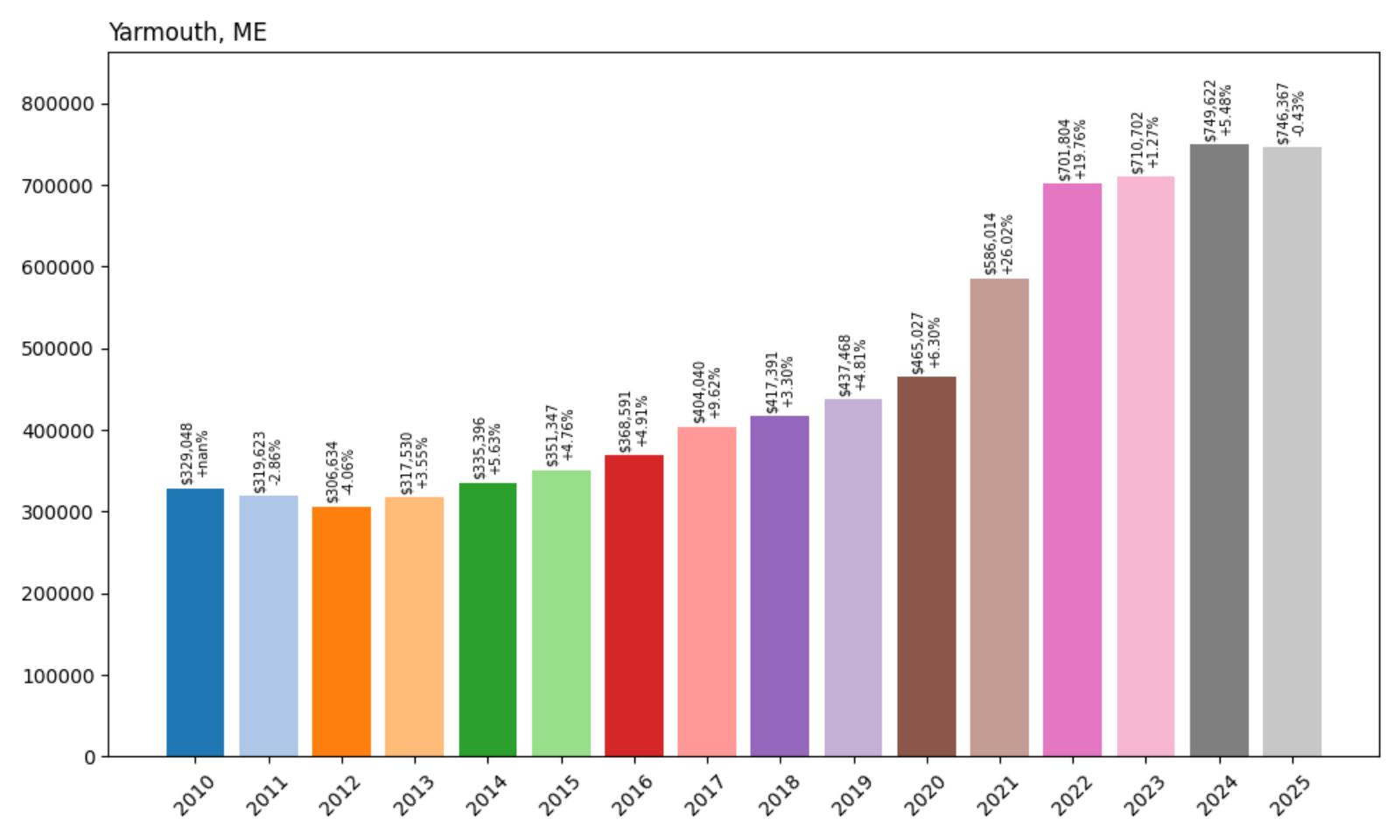
- 2010: $329,048
- 2011: $319,623 (−$9,425, −2.86% from previous year)
- 2012: $306,634 (−$12,989, −4.06% from previous year)
- 2013: $317,530 (+$10,897, +3.55% from previous year)
- 2014: $335,396 (+$17,866, +5.63% from previous year)
- 2015: $351,347 (+$15,950, +4.76% from previous year)
- 2016: $368,591 (+$17,244, +4.91% from previous year)
- 2017: $404,040 (+$35,449, +9.62% from previous year)
- 2018: $417,391 (+$13,352, +3.30% from previous year)
- 2019: $437,468 (+$20,077, +4.81% from previous year)
- 2020: $465,027 (+$27,559, +6.30% from previous year)
- 2021: $586,014 (+$120,987, +26.02% from previous year)
- 2022: $701,804 (+$115,790, +19.76% from previous year)
- 2023: $710,702 (+$8,899, +1.27% from previous year)
- 2024: $749,622 (+$38,920, +5.48% from previous year)
- 2025: $746,367 (−$3,255, −0.43% from previous year)
Yarmouth has shown impressive long-term appreciation, with home values climbing from $329,048 in 2010 to $746,367 in 2025, representing a 127% increase over 15 years. After recovering from post-recession lows in the early 2010s, the town experienced steady growth that accelerated dramatically during 2021 and 2022, when values jumped by nearly $237,000 over two years. The market has largely stabilized since then, with a slight decline in 2025 following strong gains in 2024.
Yarmouth – Historic Charm Meets Modern Convenience

Yarmouth stands out as one of Greater Portland’s premier residential communities, located along Casco Bay about 10 miles north of Portland, combining historic charm with modern amenities . This Cumberland County town has successfully preserved its maritime heritage while evolving into one of Maine’s most sought-after suburban communities. The town’s walkable village center, working waterfront, and tree-lined residential neighborhoods create an appealing environment that attracts affluent families and professionals.
The town’s award-winning schools, walkable village center, and harbor access have made it especially attractive to affluent families seeking a quintessential New England community with easy access to Portland’s urban offerings . Yarmouth’s real estate market benefits from its perfect balance of small-town character and metropolitan convenience. The community offers residents access to sailing, coastal recreation, and a vibrant downtown while maintaining easy commuter access to Portland’s employment centers.
One of the most scenic towns in all of Maine, Yarmouth is home to several pristine beaches all with glittering coastlines, where residents and visitors often enjoy boating, kayaking, fishing, and relaxing near the water . The remarkable price appreciation since 2010 reflects Yarmouth’s evolution from an affordable coastal alternative to one of Maine’s premium residential markets. With median home values now approaching $750,000, the town has firmly established itself among the state’s most exclusive communities while maintaining the authentic character that originally attracted residents.
8. York – 110% Home Price Increase Since 2010
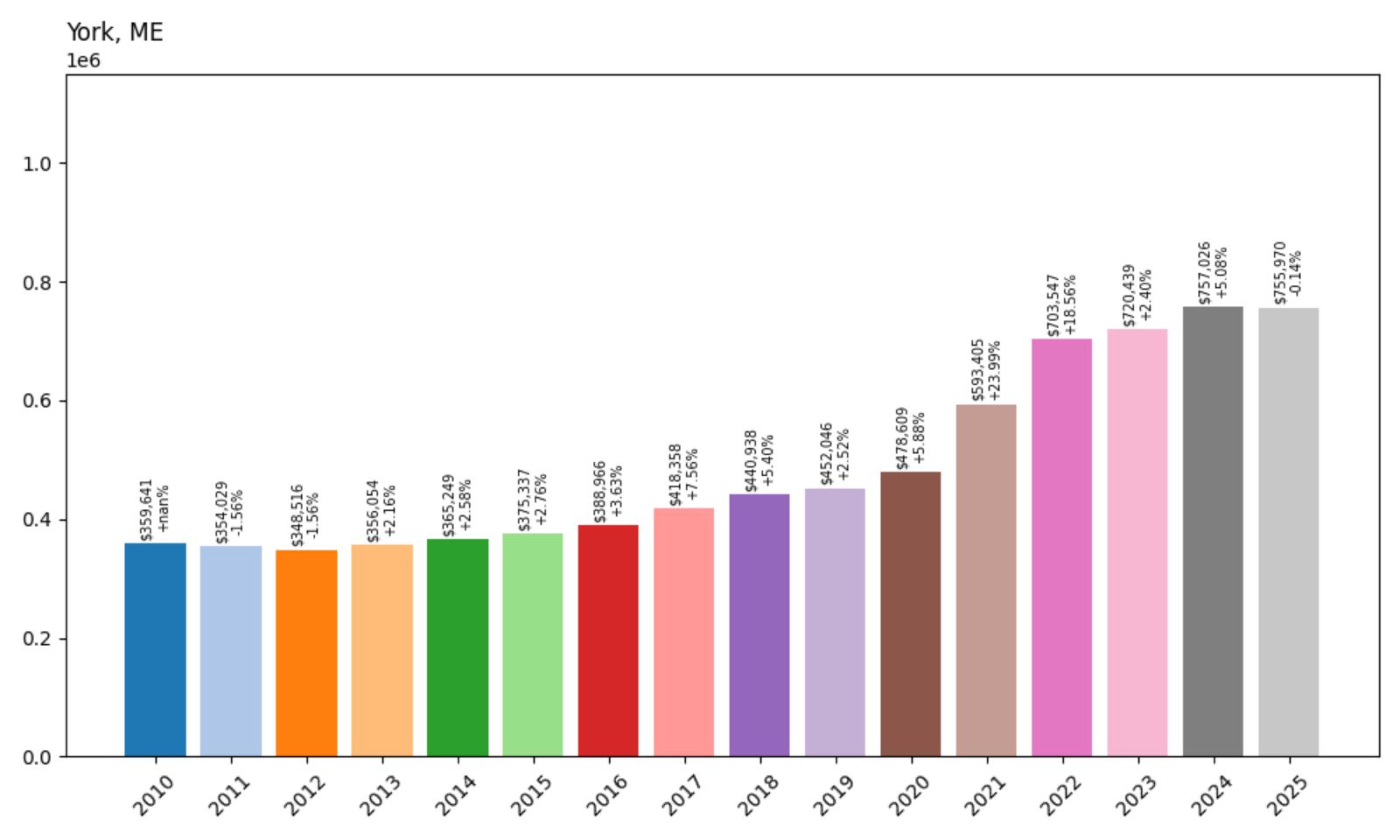
- 2010: $359,641
- 2011: $354,029 (−$5,612, −1.56% from previous year)
- 2012: $348,516 (−$5,512, −1.56% from previous year)
- 2013: $356,054 (+$7,538, +2.16% from previous year)
- 2014: $365,249 (+$9,195, +2.58% from previous year)
- 2015: $375,337 (+$10,088, +2.76% from previous year)
- 2016: $388,966 (+$13,629, +3.63% from previous year)
- 2017: $418,358 (+$29,392, +7.56% from previous year)
- 2018: $440,938 (+$22,580, +5.40% from previous year)
- 2019: $452,046 (+$11,107, +2.52% from previous year)
- 2020: $478,609 (+$26,564, +5.88% from previous year)
- 2021: $593,405 (+$114,796, +23.99% from previous year)
- 2022: $703,547 (+$110,141, +18.56% from previous year)
- 2023: $720,439 (+$16,893, +2.40% from previous year)
- 2024: $757,026 (+$36,586, +5.08% from previous year)
- 2025: $755,970 (−$1,056, −0.14% from previous year)
York has demonstrated solid long-term growth, with home values more than doubling from $359,641 in 2010 to $755,970 in 2025. The town experienced modest but steady appreciation through the 2010s, followed by dramatic pandemic-era increases that added nearly $225,000 in value during 2021 and 2022. Growth has continued through 2024, with only a minimal decline in 2025, showing the market’s resilience and continued strong demand for this premier coastal location.
York – Historic Beaches and Coastal Elegance

York is a classic coastal town that continues to attract buyers with its beautiful beaches, historic charm, and vibrant community life . Located in York County at Maine’s southern coast, this community of about 13,000 residents offers some of the state’s most pristine sandy beaches, including Long Sands Beach and Short Sands Beach. The resort town is known for its sandy beaches and Cape Neddick Light, positioned at the southern extreme of the Portland metro area, around 10 minutes from New Hampshire and just over 20 minutes from Massachusetts .
York’s appeal extends beyond its natural beauty to encompass a rich historical heritage dating back to 1624, making it one of the oldest settlements in Maine. The town successfully balances preservation of its colonial character with modern amenities, creating an environment that appeals to both year-round residents and seasonal visitors. The community’s commitment to maintaining its historic downtown, protecting open spaces, and preserving coastal access has created a sustainable model for coastal development that supports premium property values.
With 277 home sales in 2024 and an average price of $1,023,637, York ranked fourth among Maine’s most expensive towns . The substantial price appreciation since 2010 reflects York’s position as one of New England’s premier beach destinations, where proximity to major metropolitan areas combines with authentic Maine coastal character. With home values now exceeding $750,000, York represents the successful evolution of a historic community into a luxury residential market while maintaining the authentic seaside charm that originally attracted residents and visitors.
7. South Bristol – 126% Home Price Increase Since 2012
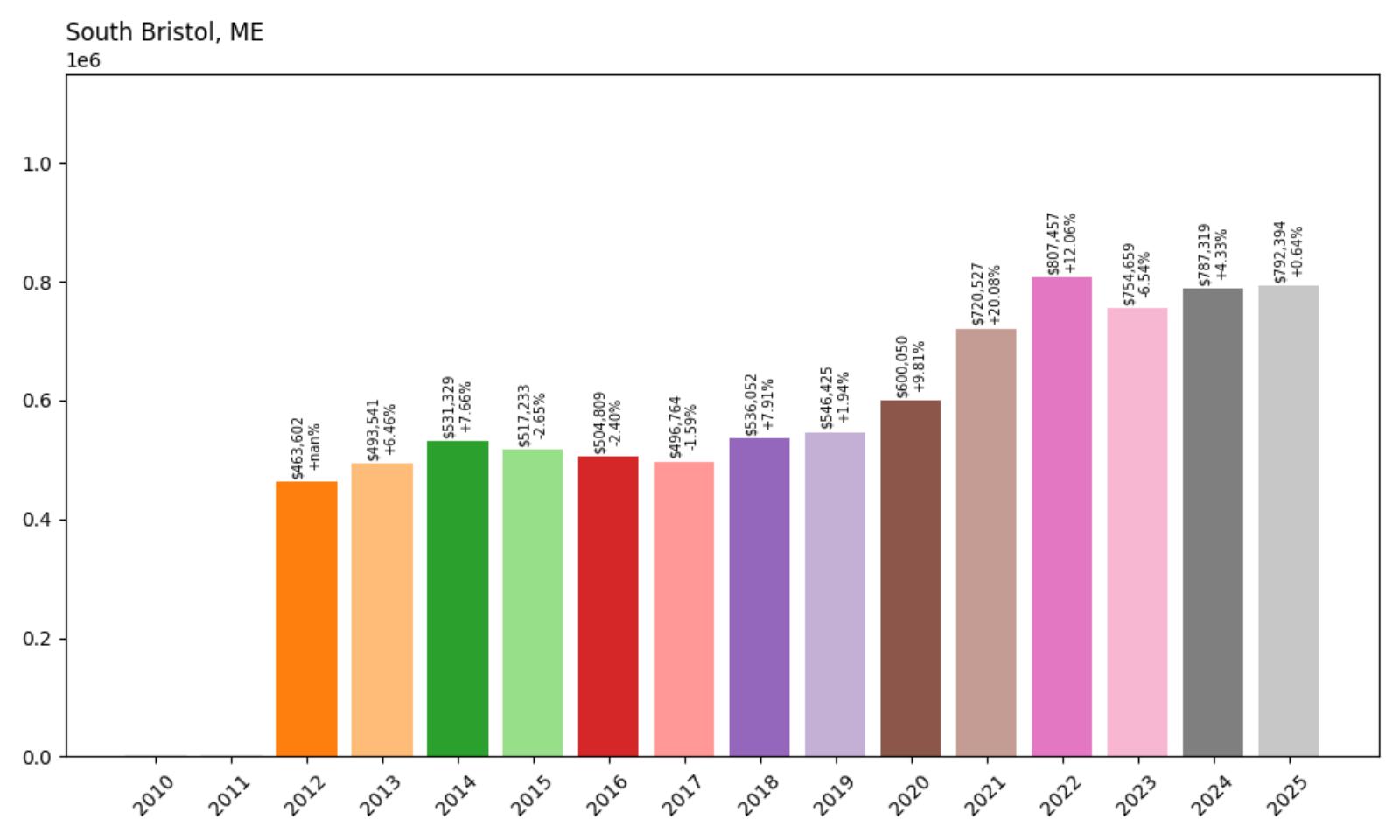
- 2010: N/A
- 2011: N/A
- 2012: $463,602
- 2013: $493,541 (+$29,938, +6.46% from previous year)
- 2014: $531,329 (+$37,789, +7.66% from previous year)
- 2015: $517,233 (−$14,096, −2.65% from previous year)
- 2016: $504,809 (−$12,424, −2.40% from previous year)
- 2017: $496,764 (−$8,045, −1.59% from previous year)
- 2018: $536,052 (+$39,287, +7.91% from previous year)
- 2019: $546,425 (+$10,374, +1.94% from previous year)
- 2020: $600,050 (+$53,625, +9.81% from previous year)
- 2021: $720,527 (+$120,477, +20.08% from previous year)
- 2022: $807,457 (+$86,930, +12.06% from previous year)
- 2023: $754,659 (−$52,798, −6.54% from previous year)
- 2024: $787,319 (+$32,660, +4.33% from previous year)
- 2025: $792,394 (+$5,075, +0.64% from previous year)
South Bristol has shown remarkable growth since 2012, with home values climbing from $463,602 to $792,394 in 2025, representing a 71% increase over 13 years. The market experienced some volatility in the mid-2010s before accelerating dramatically starting in 2020. The pandemic years brought substantial gains totaling over $200,000, though the market has been more volatile recently, with a significant correction in 2023 followed by recovery through 2025.
South Bristol – Peninsula Tranquility

South Bristol’s premium positioning in Maine’s coastal real estate market is unmistakable, with home values having more than doubled from $351,402 in 2010 to $726,891 in 2025, representing a solid 106.85% increase . This Lincoln County peninsula community offers one of Maine’s most secluded yet accessible coastal living experiences, surrounded on three sides by the Damariscotta River and connected to the mainland by a single road. The geography creates natural exclusivity while maintaining reasonable access to larger communities like Newcastle and Damariscotta.
The town’s residents can enjoy fun local events during the summer months such as highly attended lobster bakes and farmers’ markets – gatherings that never fail to bring residents closer together. South Bristol’s small community is very close-knit, and many of its neighbors know each other by name . The community has successfully preserved its working waterfront character while accommodating residential growth, creating an authentic Maine coastal environment that appeals to buyers seeking genuine maritime culture rather than resort-style amenities.
The town boasts a vibrant arts scene, with local galleries and performances throughout the year. For those seeking outdoor adventures, South Bristol’s coastline and scenic trails are sure to impress . The substantial price appreciation reflects the growing recognition of peninsula communities as premium residential markets, where geographic constraints limit supply while natural beauty and authentic character drive continued demand. Despite recent market volatility, South Bristol’s unique location and community character position it as one of Maine’s most exclusive coastal residential markets.
6. Southport – 64% Home Price Increase Since 2020
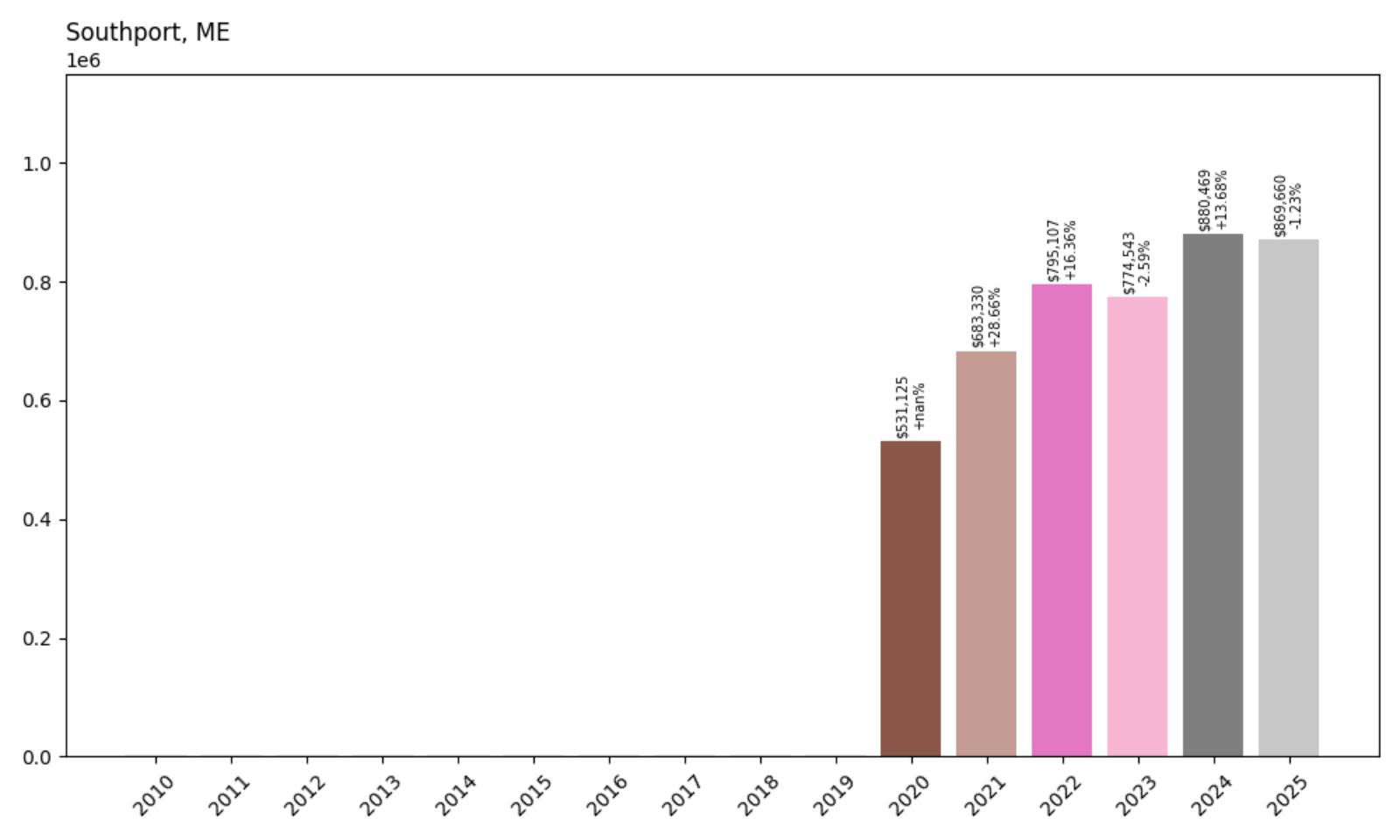
- 2010: N/A
- 2011: N/A
- 2012: N/A
- 2013: N/A
- 2014: N/A
- 2015: N/A
- 2016: N/A
- 2017: N/A
- 2018: N/A
- 2019: N/A
- 2020: $531,125
- 2021: $683,330 (+$152,205, +28.66% from previous year)
- 2022: $795,107 (+$111,777, +16.36% from previous year)
- 2023: $774,543 (−$20,565, −2.59% from previous year)
- 2024: $880,469 (+$105,926, +13.68% from previous year)
- 2025: $869,660 (−$10,809, −1.23% from previous year)
Southport presents data only from 2020 forward, showing substantial growth from $531,125 to $869,660 in 2025, representing a 64% increase over just five years. The island community experienced rapid appreciation during 2021 and 2022, gaining over $264,000 in value during those two years. After a slight correction in 2023, values surged again in 2024 before moderating slightly in 2025, but remain well above pre-pandemic levels.
Southport – Island Luxury and Serenity

Southport boasts miles of serene harbors and stunning ocean views, along with a quaint and peaceful community where residents can explore historic landmarks, artisan shops, and cozy cafes . This Lincoln County island community, connected to the mainland by a bridge from Boothbay Harbor, represents one of Maine’s most exclusive residential markets. The island’s limited size and development restrictions create natural scarcity that supports premium property values while preserving the authentic Maine island character that attracts affluent buyers.
The town is rich in history and nature, with attractions like the Hendricks Hill Museum, Reid State Park, and the Southport Island Marine Park, offering residents and visitors a chance to experience the magic of this community with its laid-back vibe and coastal charm . Southport’s appeal lies in its perfect balance of accessibility and isolation – close enough to Boothbay Harbor for conveniences yet separated enough to maintain an authentic island atmosphere. The community has successfully preserved its maritime heritage while accommodating upscale residential development.
Coming in at number one in 2023 was the town of Southport with an average home selling price of $1,474,231 . The remarkable price appreciation since 2020 reflects the intense demand for authentic Maine island living that accelerated during the pandemic. Despite recent modest corrections, Southport’s combination of natural beauty, historic character, and geographic exclusivity ensures its position among Maine’s most expensive and sought-after residential communities.
5. Cape Elizabeth – 103% Home Price Increase Since 2010
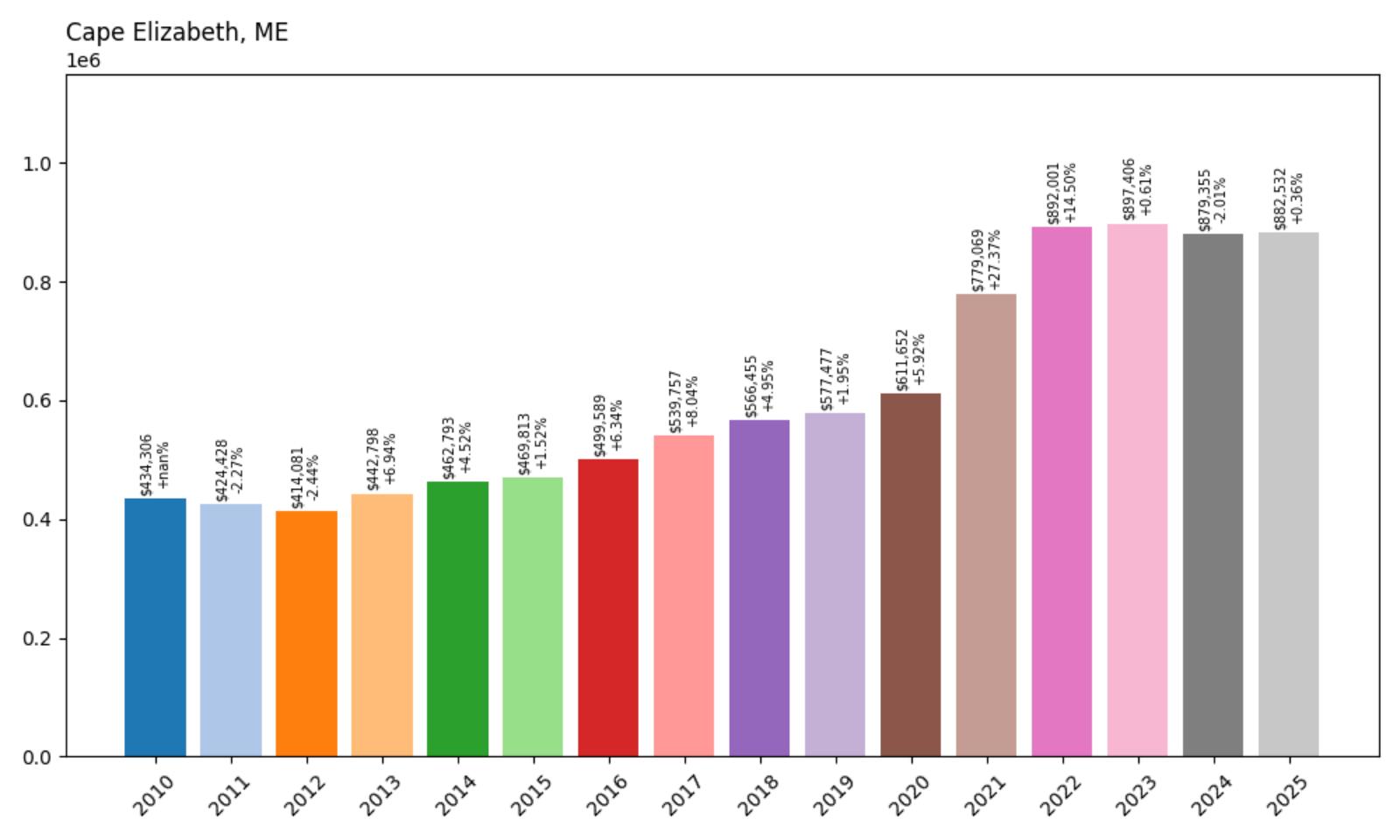
- 2010: $434,306
- 2011: $424,428 (−$9,878, −2.27% from previous year)
- 2012: $414,081 (−$10,348, −2.44% from previous year)
- 2013: $442,798 (+$28,717, +6.94% from previous year)
- 2014: $462,793 (+$19,995, +4.52% from previous year)
- 2015: $469,813 (+$7,020, +1.52% from previous year)
- 2016: $499,589 (+$29,776, +6.34% from previous year)
- 2017: $539,757 (+$40,168, +8.04% from previous year)
- 2018: $566,455 (+$26,697, +4.95% from previous year)
- 2019: $577,477 (+$11,022, +1.95% from previous year)
- 2020: $611,652 (+$34,176, +5.92% from previous year)
- 2021: $779,069 (+$167,417, +27.37% from previous year)
- 2022: $892,001 (+$112,932, +14.50% from previous year)
- 2023: $897,406 (+$5,404, +0.61% from previous year)
- 2024: $879,355 (−$18,050, −2.01% from previous year)
- 2025: $882,532 (+$3,177, +0.36% from previous year)
Cape Elizabeth has demonstrated strong long-term appreciation, with home values more than doubling from $434,306 in 2010 to $882,532 in 2025. After recovering from post-recession lows in the early 2010s, the town experienced steady growth that accelerated dramatically during the pandemic years, with values jumping by over $280,000 during 2021 and 2022. The market has stabilized since then, with minor fluctuations but values remaining near historic highs.
Cape Elizabeth – Prestigious Coastal Living

Known for its stunning coastal views, top-rated schools, and proximity to Portland, Cape Elizabeth offers a serene yet vibrant lifestyle with its blend of natural beauty, strong community values, and easy access to city amenities, making it one of Maine’s most desirable places to call home . This Cumberland County community has long been considered one of Greater Portland’s most prestigious addresses, combining spectacular oceanfront properties with excellent municipal services and a strong sense of community identity.
Even as price gains have slowed, Cape Elizabeth remains one of the most expensive and desirable places to live in Maine, with the market seeing huge jumps during the pandemic driven by out-of-state demand and limited inventory . The town’s appeal stems from its dramatic coastline, including the iconic Portland Head Light, pristine beaches, and extensive trail systems that provide residents with unparalleled recreational opportunities within minutes of downtown Portland.
Cape Elizabeth’s housing market reflects its status as one of New England’s premier coastal suburbs, where oceanfront estates command multi-million dollar prices while inland properties still reach well into six figures. The community’s commitment to land conservation, excellent schools, and thoughtful development has created a sustainable model for luxury coastal living. With median home values now exceeding $880,000, Cape Elizabeth represents the pinnacle of Maine suburban living, where natural beauty, community quality, and metropolitan access converge to create one of the state’s most coveted residential markets.
4. Falmouth – 138% Home Price Increase Since 2010
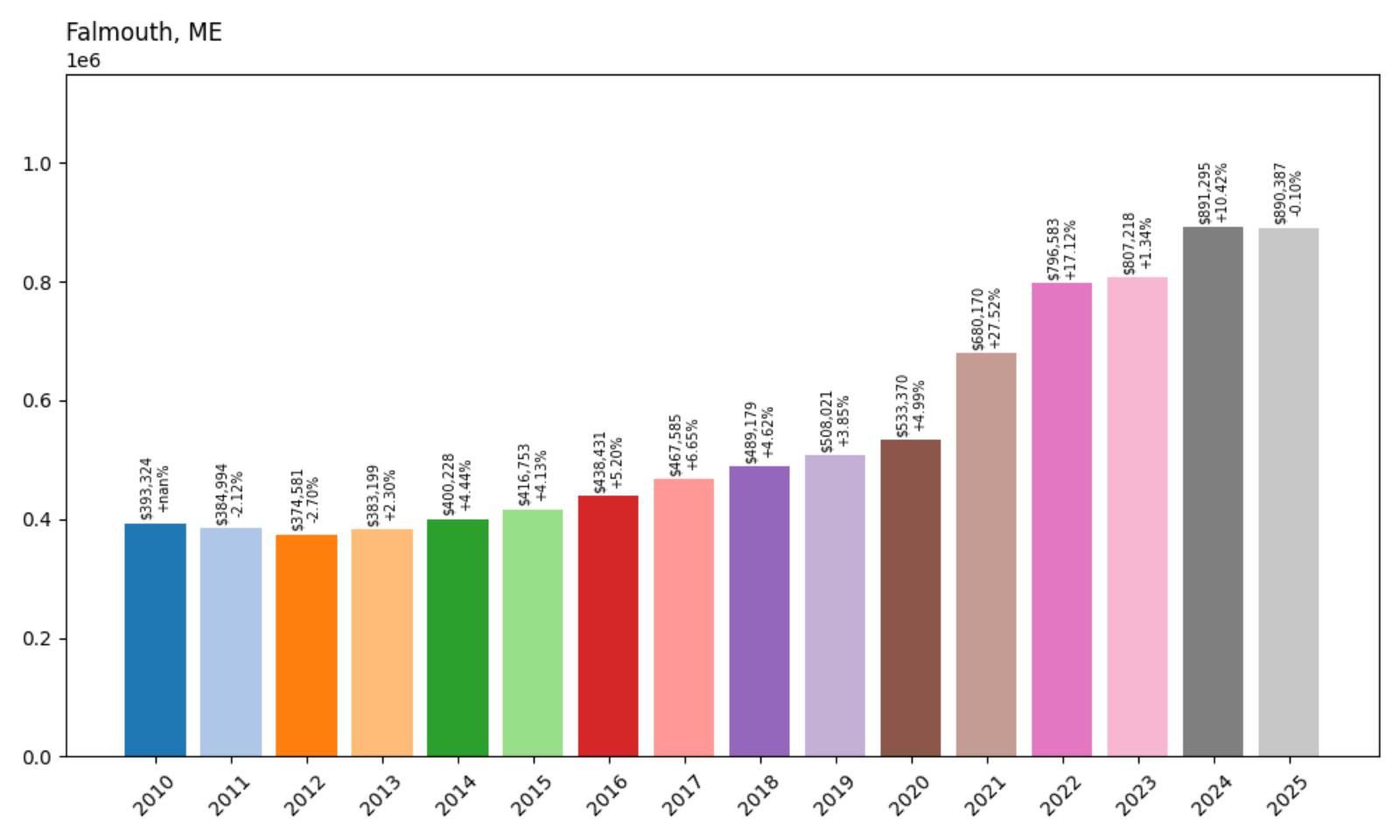
- 2010: $393,324
- 2011: $384,994 (−$8,331, −2.12% from previous year)
- 2012: $374,581 (−$10,413, −2.70% from previous year)
- 2013: $383,199 (+$8,618, +2.30% from previous year)
- 2014: $400,228 (+$17,029, +4.44% from previous year)
- 2015: $416,753 (+$16,525, +4.13% from previous year)
- 2016: $438,431 (+$21,678, +5.20% from previous year)
- 2017: $467,585 (+$29,154, +6.65% from previous year)
- 2018: $489,179 (+$21,593, +4.62% from previous year)
- 2019: $508,021 (+$18,842, +3.85% from previous year)
- 2020: $533,370 (+$25,349, +4.99% from previous year)
- 2021: $680,170 (+$146,800, +27.52% from previous year)
- 2022: $796,583 (+$116,413, +17.12% from previous year)
- 2023: $807,218 (+$10,635, +1.34% from previous year)
- 2024: $891,295 (+$84,077, +10.42% from previous year)
- 2025: $890,387 (−$908, −0.10% from previous year)
Falmouth has shown exceptional growth over 15 years, with home values climbing from $393,324 in 2010 to $890,387 in 2025, representing a remarkable 126% increase. The town experienced steady appreciation through the 2010s, followed by explosive pandemic-era growth that added over $263,000 in value during 2021 and 2022. Strong growth continued through 2024, with values essentially flat in 2025 but remaining near all-time highs.
Falmouth – Luxury Redefined

Falmouth is one of southern Maine’s most affluent suburbs, offering luxury homes, private golf courses, and a prized location along Casco Bay, with proximity to Portland making it ideal for commuters who want space and upscale amenities . This Cumberland County community has established itself as Maine’s premier luxury residential market, where sprawling estates, waterfront compounds, and exclusive neighborhoods create an environment that attracts the state’s most affluent residents. The town’s housing market benefits from strong school systems, waterfront access, and a steady influx of buyers seeking larger properties .
Falmouth ranked third with 188 home sales and an average price of $1,139,599 in 2024, offering a perfect balance of natural beauty and modern convenience with its picturesque waterfront, top-rated schools, and easy access to downtown Portland . The community attracts families and professionals seeking an upscale yet relaxed lifestyle that combines rural tranquility with metropolitan convenience. Falmouth’s extensive coastline along Casco Bay provides residents with private beaches, sailing opportunities, and some of Maine’s most valuable waterfront real estate.
Currently, the most expensive home for sale in Falmouth is listed at $7,500,000, making it Maine’s most expensive neighborhood where inventory appears higher than some other luxury markets . The substantial price appreciation since 2010 reflects Falmouth’s evolution into Maine’s answer to exclusive suburban markets found in other New England states. With median home values approaching $900,000, Falmouth represents the apex of Maine suburban luxury, where natural beauty, educational excellence, and exclusivity combine to create one of New England’s most prestigious residential addresses.
3. Ogunquit – 162% Home Price Increase Since 2010
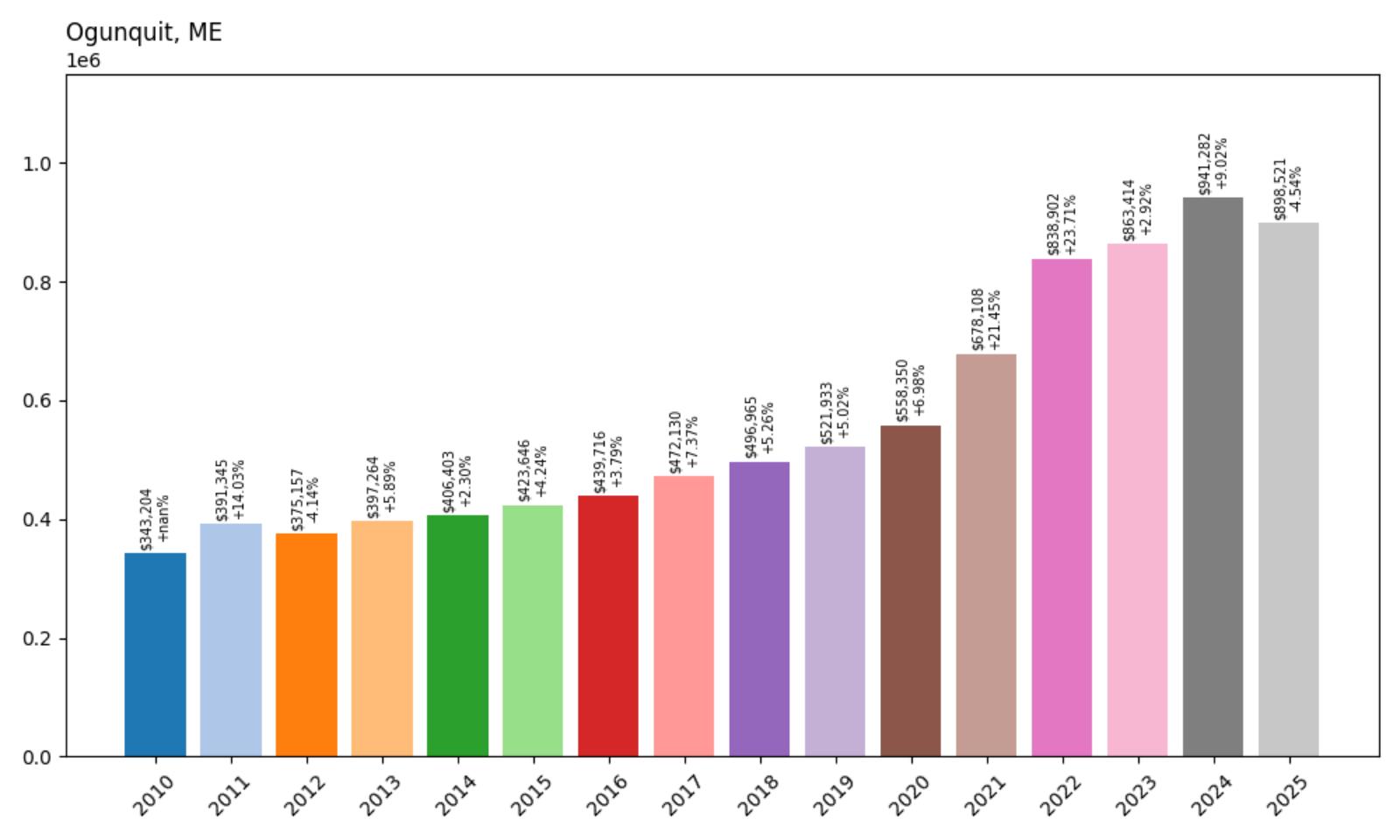
- 2010: $343,204
- 2011: $391,345 (+$48,141, +14.03% from previous year)
- 2012: $375,157 (−$16,188, −4.14% from previous year)
- 2013: $397,264 (+$22,106, +5.89% from previous year)
- 2014: $406,403 (+$9,140, +2.30% from previous year)
- 2015: $423,646 (+$17,242, +4.24% from previous year)
- 2016: $439,716 (+$16,070, +3.79% from previous year)
- 2017: $472,130 (+$32,415, +7.37% from previous year)
- 2018: $496,965 (+$24,834, +5.26% from previous year)
- 2019: $521,933 (+$24,969, +5.02% from previous year)
- 2020: $558,350 (+$36,417, +6.98% from previous year)
- 2021: $678,108 (+$119,758, +21.45% from previous year)
- 2022: $838,902 (+$160,793, +23.71% from previous year)
- 2023: $863,414 (+$24,512, +2.92% from previous year)
- 2024: $941,282 (+$77,868, +9.02% from previous year)
- 2025: $898,521 (−$42,761, −4.54% from previous year)
Ogunquit has experienced the most dramatic price appreciation among Maine’s expensive towns, with home values climbing from $343,204 in 2010 to $898,521 in 2025, representing an extraordinary 162% increase. The town showed consistent growth through the 2010s that accelerated dramatically during the pandemic years, with particularly strong gains in 2022 and 2024. Despite a notable correction in 2025, values remain well above pre-pandemic levels and nearly triple their 2010 baseline.
Ogunquit – Resort Town Excellence

Named with the Abenaki word meaning “beautiful place by the sea,” this small coastal resort town lives up to its name with three miles of pristine sandy beaches and the scenic Marginal Way footpath . Located in York County, Ogunquit has evolved from a quiet fishing village into one of New England’s premier resort destinations, attracting visitors and residents with its spectacular natural beauty and sophisticated cultural offerings.
Ogunquit’s combination of natural beauty, thriving arts scene, and renowned dining options has cemented its status as one of New England’s most desirable coastal destinations . The community has successfully balanced its role as a major tourist destination with residential exclusivity, creating an environment where seasonal visitors and year-round residents coexist in an atmosphere of sophisticated coastal living. The town’s commitment to preserving its natural beauty while accommodating upscale development has created a sustainable model for resort community growth.
Ogunquit’s home values have jumped from $369,188 in 2012 to $893,813 in 2025—a 121% increase, with prices hitting a peak in 2024 before dipping slightly, but the town’s status as a premier coastal destination continues to command high real estate values . The remarkable price appreciation reflects Ogunquit’s transformation into a luxury market where beachfront properties command premium prices and even inland homes reflect the community’s exclusive character. Despite recent volatility, Ogunquit’s combination of natural beauty, cultural sophistication, and resort amenities ensures its position among Maine’s most expensive residential markets.
2. Mount Desert – 101% Home Price Increase Since 2010
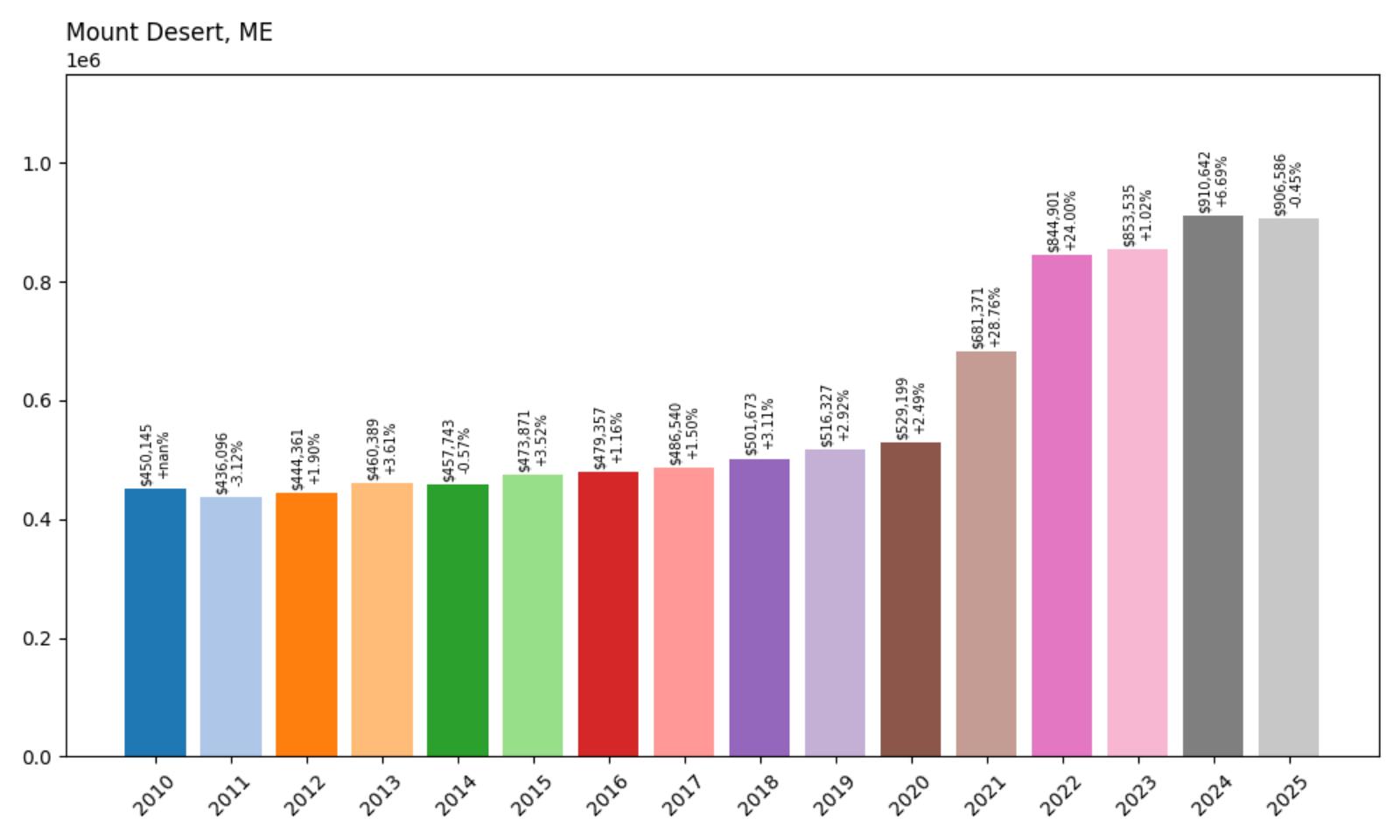
- 2010: $450,145
- 2011: $436,096 (−$14,048, −3.12% from previous year)
- 2012: $444,361 (+$8,265, +1.90% from previous year)
- 2013: $460,389 (+$16,028, +3.61% from previous year)
- 2014: $457,743 (−$2,647, −0.57% from previous year)
- 2015: $473,871 (+$16,128, +3.52% from previous year)
- 2016: $479,357 (+$5,486, +1.16% from previous year)
- 2017: $486,540 (+$7,183, +1.50% from previous year)
- 2018: $501,673 (+$15,133, +3.11% from previous year)
- 2019: $516,327 (+$14,654, +2.92% from previous year)
- 2020: $529,199 (+$12,872, +2.49% from previous year)
- 2021: $681,371 (+$152,173, +28.76% from previous year)
- 2022: $844,901 (+$163,529, +24.00% from previous year)
- 2023: $853,535 (+$8,634, +1.02% from previous year)
- 2024: $910,642 (+$57,107, +6.69% from previous year)
- 2025: $906,586 (−$4,056, −0.45% from previous year)
Mount Desert has shown remarkable long-term growth, with home values doubling from $450,145 in 2010 to $906,586 in 2025, representing a 101% increase over 15 years. The town experienced modest but steady appreciation through 2020, followed by explosive pandemic-era growth that added over $315,000 in value during 2021 and 2022. Growth continued through 2024, with only a minor correction in 2025, leaving values near all-time highs.
Mount Desert – National Park Prestige

Located on Mount Desert Island in Hancock County, this town includes part of Acadia National Park and several of Maine’s most exclusive communities, such as Northeast Harbor and Seal Harbor, where the dramatic landscape and limited buildable land drive long-term demand . Mount Desert represents the pinnacle of Maine’s natural luxury real estate market, where proximity to one of America’s most visited national parks combines with exclusive residential enclaves to create unparalleled property values.
Mount Desert is popular among affluent seasonal residents, including high-profile figures seeking privacy and natural beauty, with its limited housing stock, strict zoning, and premier location explaining why values have climbed so high . The community has successfully balanced preservation of its natural environment with accommodation of some of the most exclusive residential development in New England. Bar Harbor may attract the crowds, but Mount Desert offers the privacy and exclusivity that ultra-affluent buyers seek.
Mount Desert comes in third on the 2023 list with the average selling price for a home at $1,379,461, where residents of this tiny town enjoy a rich community culture built on the town’s strong love of nature and historical landmarks . The substantial price appreciation since 2010 reflects Mount Desert’s unique position as both a gateway to Acadia National Park and home to some of New England’s most exclusive summer estates. With median home values now exceeding $900,000, Mount Desert represents the ultimate in Maine luxury living, where natural beauty, exclusivity, and national park access create an irreplaceable residential experience.
1. Kennebunkport – 132% Home Price Increase Since 2010
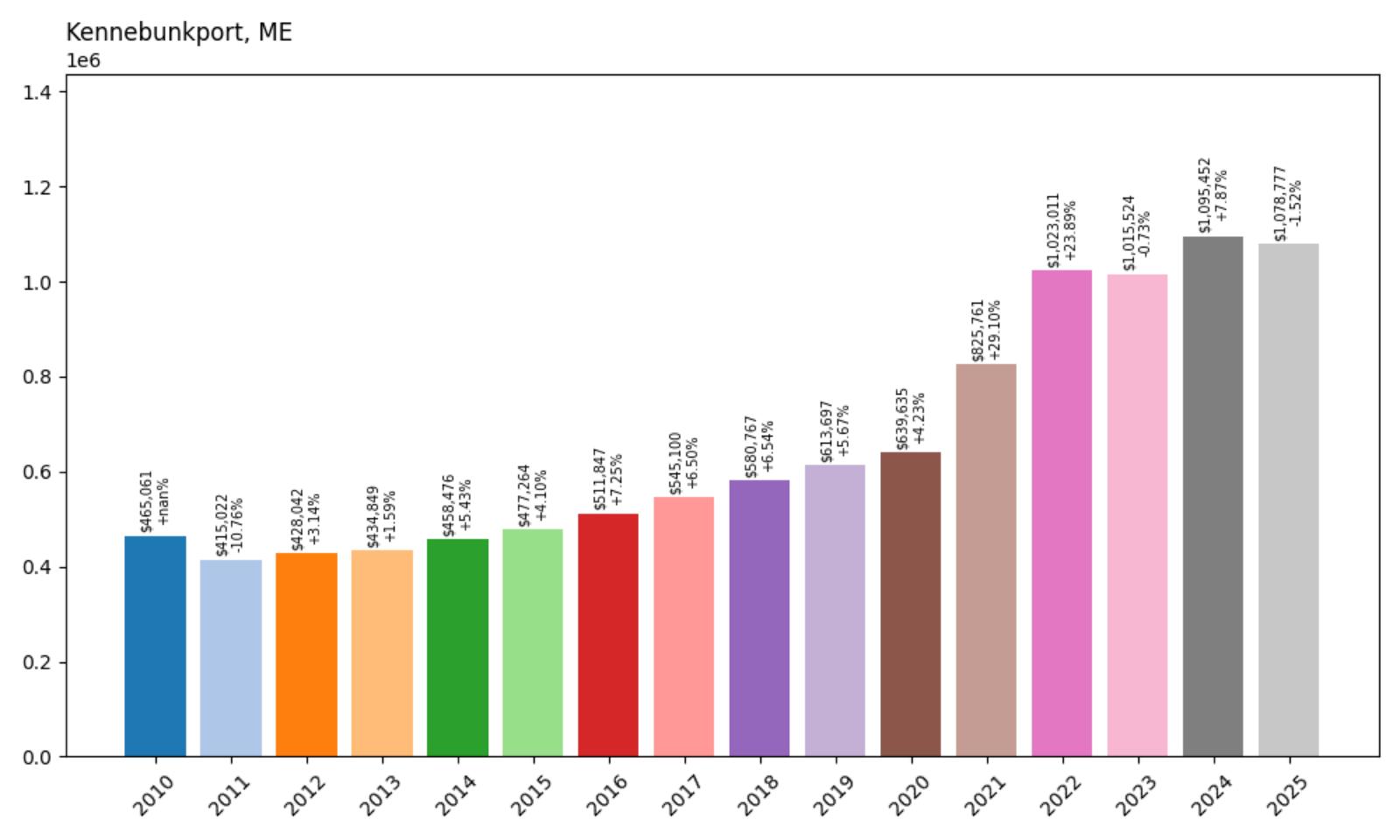
- 2010: $465,061
- 2011: $415,022 (−$50,039, −10.76% from previous year)
- 2012: $428,042 (+$13,020, +3.14% from previous year)
- 2013: $434,849 (+$6,807, +1.59% from previous year)
- 2014: $458,476 (+$23,627, +5.43% from previous year)
- 2015: $477,264 (+$18,789, +4.10% from previous year)
- 2016: $511,847 (+$34,583, +7.25% from previous year)
- 2017: $545,100 (+$33,253, +6.50% from previous year)
- 2018: $580,767 (+$35,668, +6.54% from previous year)
- 2019: $613,697 (+$32,929, +5.67% from previous year)
- 2020: $639,635 (+$25,939, +4.23% from previous year)
- 2021: $825,761 (+$186,126, +29.10% from previous year)
- 2022: $1,023,011 (+$197,250, +23.89% from previous year)
- 2023: $1,015,524 (−$7,487, −0.73% from previous year)
- 2024: $1,095,452 (+$79,927, +7.87% from previous year)
- 2025: $1,078,777 (−$16,674, −1.52% from previous year)
Kennebunkport stands alone at the summit of Maine’s luxury real estate market, with home values climbing from $465,061 in 2010 to $1,078,777 in 2025, representing a 132% increase over 15 years. After recovering from post-recession lows, the town experienced steady appreciation through 2020, followed by explosive pandemic-era growth that pushed values above the million-dollar threshold. Despite recent minor corrections, Kennebunkport remains the only Maine community where median home values exceed $1 million.
Kennebunkport – Presidential Prestige and Coastal Perfection

Kennebunkport came out on top with 102 home sales in 2024 and an average home price of $1,457,629, beloved for its stunning beaches, elegant homes, and classic small-town charm just a short drive from Portland . This York County coastal town has achieved legendary status in American real estate, serving as the summer retreat for the Bush family at Walker’s Point and embodying the quintessential New England coastal experience that attracts affluent buyers from around the world.
The average selling price for a home in Kennebunkport is $1,469,419, making this small but vibrant community known for its beautiful waterfronts, historical architecture, and strong sense of community . The town offers an array of luxury amenities including boating, exclusive shopping, world-class dining, and pristine beaches, while maintaining the authentic character that has made it famous. Some of the most popular attractions are the White Columns, a grand Federal-style mansion, and the iconic Walker’s Point, the summer home to the Bush family .
More recently, homes there have become pricier than ever, having increased by $64,000 from just January to April, making it by far the priciest place in Maine, beating out Cape Elizabeth by over $140,000 . Kennebunkport appears to be on pace to be the first community in Maine where homes have a median value of $1 million . The extraordinary price appreciation reflects Kennebunkport’s unique position as both a working fishing village and an exclusive resort destination, where presidential connections, natural beauty, and authentic Maine character combine to create the state’s most prestigious residential address.

